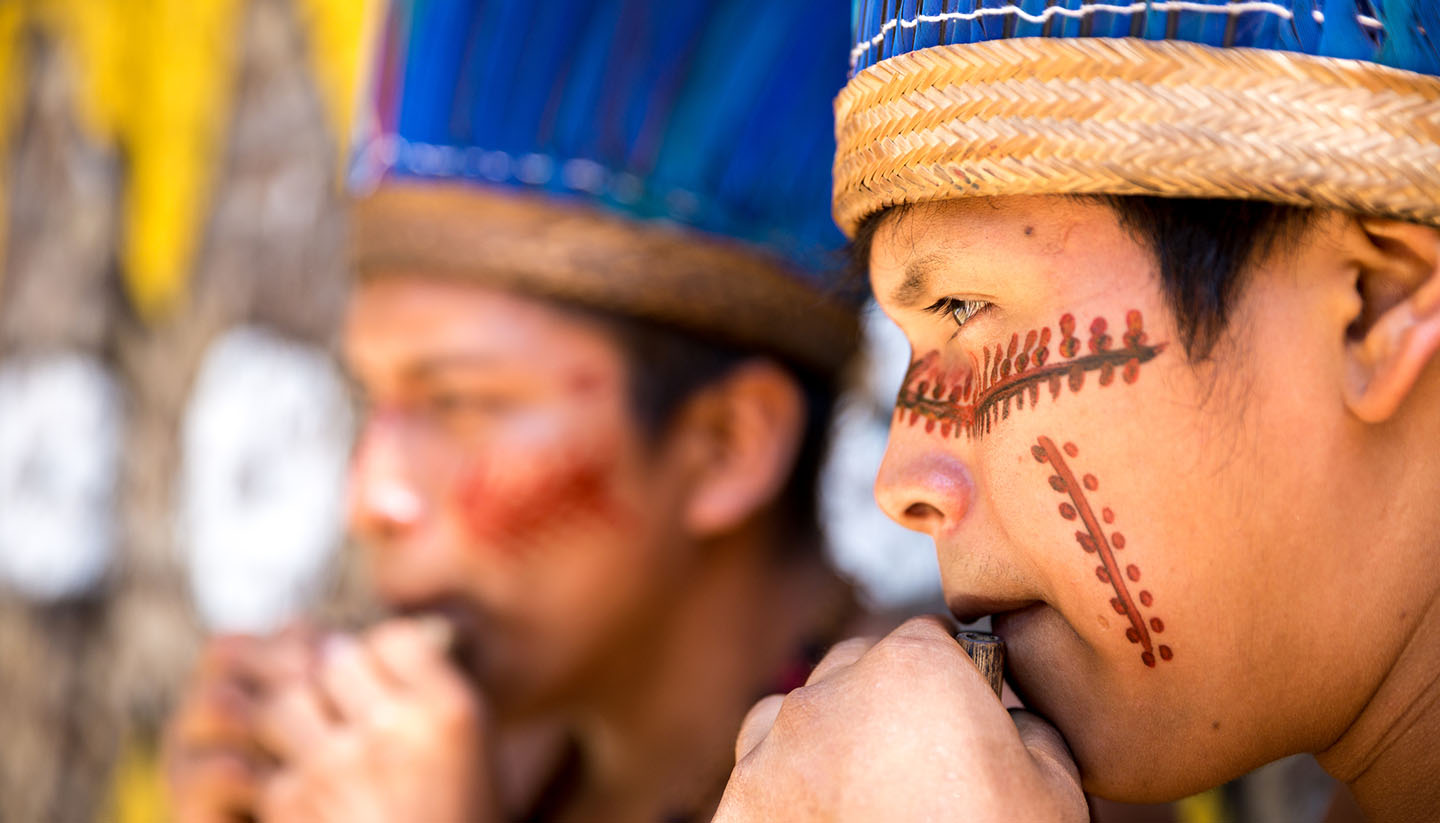

Introducing Brazil
About brazil.
- Images of Brazil
- History, language & culture
- Weather & geography
- Doing business & staying in touch
Plan your trip
- Travel to Brazil
- Where to stay
While you’re there
- Things to see & do
- Shopping & nightlife
- Food & drink
- Getting around
Before you go
- Passport & visa
- Public Holidays
- Money & duty free
Book your flights
Rio de Janeiro
- Brasilia International Airport
- Rio de Janeiro-Galeão (Antonio Carlos Jobim International Airport)
- Salvador International Airport
- São Paulo-Guarulhos International Airport
- Buzios beaches
- Copacabana beaches
- Natal beaches
- Salvador beaches
Cruise Locations
Brazil travel guide.
From the jungle calls of the Amazon to the thong-clad crowds of Copacabana beach, Brazil is an intoxicating mix of the big, the bold and the beautiful, perennially one of the world’s favourite destinations.
It’s also one of the largest countries on the planet, with an awesome array of treasures to match. Its vast coastline is fringed with soft sands and island getaways; the Amazon Basin teems with an unrivalled mass of flora and fauna; and the wetlands of the Pantanal, the largest on Earth, support a staggering diversity of wildlife.
And then there’s the Iguaçu Falls, an unforgettable natural spectacle featuring hundreds of waterfalls, which cascade from the tropical rainforest as blue morpho butterflies flit through the spray.
Undoubtedly the greatest draw, however, are the Brazilians themselves; probably the most hedonistic people on earth. Whether it’s Rio’s effervescent Cariocas going overboard at Carnival, or São Paulo’s sultry citizens gyrating in chic nightclubs, Brazilians love having fun.
Their irrepressible joie de vivre finds its best outlet through music and dance. Samba, lambada and bossa nova are Brazil’s best-known musical exports, but visitors can also discover a plethora of other genres, from the Northeast’s forró to the punchy bass of baile funk coming out of Rio’s favelas.
Adrenaline junkies can go wild in Brazil; shooting the big surf of Santa Catarina; bouncing in beach buggies over the sand dunes of northern Natal; snorkeling in Fernando de Noronha National Park; or abseiling in the Chapada Diamantina National Park.
Or you can take life easy and let Brazil come to you by lolling in a hammock on an Amazonian ferry, looking out for the occasional macaw, or browsing the backstreets of colonial towns such as Ouro Preto and Paraty, which are lined with architectural monuments and chic boutique hotels.
Whatever you’re looking for, rest assured, Brazil has it in spades.
8,515,770 sq km (3,287,957 sq miles).
210,274,356 (UN estimate 2016).
24 per sq km.
Brasília.
Federal Republic.
President Luiz Inácio Lula da Silva since 2023.
Travel Advice
Your travel insurance could be invalidated if you travel against advice from the Foreign, Commonwealth & Development Office (FCDO).
Areas where FCDO advises against all but essential travel
Amazonas state.
FCDO advises against all but essential travel to the following river areas towards the west of Amazonas State, where Brazil shares borders with Colombia, Peru and Venezuela:
- along the Amazonas (Amazon) River and its tributaries west of the town of Codajás and east of the town of Belém do Solimões in Amazonas State
- along any part of the Itaquaí River in Amazonas State
- along any part of the Japurá River or its tributaries in Amazonas State
- along the Rio Negro (Black River) and its tributaries north or west of the town of Barcelos in Amazonas State
Find out more about why FCDO advises against travel .
The Foreign, Commonwealth & Development Office ( FCDO ) provides advice about risks of travel to help British nationals make informed decisions. Find out more about FCDO travel advice .
Before you travel
No travel can be guaranteed safe. Read all the advice in this guide and see support for British nationals abroad for information about specific travel topics.
Follow and contact FCDO travel on Twitter , Facebook and Instagram . You can also sign up to get email notifications when this advice is updated.
Travel insurance
If you choose to travel, research your destinations and get appropriate travel insurance . Insurance should cover your itinerary, planned activities and expenses in an emergency.
This advice reflects the UK government’s understanding of current rules for people travelling on a full ‘British citizen’ passport from the UK, for the most common types of travel.
The authorities in Brazil set and enforce entry rules. If you’re not sure how these requirements apply to you, contact the Brazilian Embassy in the UK .
COVID-19 rules
There are no COVID-19 testing or vaccination requirements for travellers entering Brazil.
Passport validity requirements
To enter Brazil, your passport must have an ‘expiry date’ at least 6 months after the date you arrive.
Check with your travel provider that your passport and other travel documents meet requirements. Renew your passport if you need to.
You will be denied entry if you do not have a valid travel document or try to use a passport that has been reported lost or stolen.
Visa requirements
You can visit Brazil without a visa for up to 90 days for tourism.
If you want to extend your tourist visa, contact the Federal Police (in Portuguese) before your visa expires.
For more information about visas, contact the Brazilian Consulate in London .
If you overstay your visa, you’ll face a daily fine. You have the option to pay this fine either when you leave Brazil or during your next visit. You will not be allowed to re-enter Brazil if you do not pay the fine. Overstaying your visa will result in a 6-month ban from re-entering the country.
Make sure you get your passport stamped.
Make sure the border control officer puts a stamp in your passport. If it is not stamped, you may be fined when you leave.
Read about passport stamping if you live in Brazil (in Portuguese).
At Brazil border control, you must be able to show:
- information about the purpose of your visit
- evidence you have enough money for your whole stay
- details of your accommodation
- evidence of return or onward travel
British-Brazilian dual nationals
Brazilian immigration authorities often require dual British-Brazilian nationals visiting Brazil to travel on Brazilian (rather than British) passports.
Travelling with children
Children with dual british-brazilian citizenship.
British-Brazilian dual nationals under the age of 18 who are travelling without all parents or legal guardians need authorisation from all parents or legal guardians to travel in Brazil or leave the country.
If they travel with only one parent (or guardian) or without any parent, they must have 2 original written authorisations from all parents or guardians. Read more about the formal travel authorisation process for Brazilian minors and the frequently asked questions .
You must show this permission when the under-18 leaves Brazil. One copy will be kept by the Federal Police inspection agent, together with a copy of the under-18’s identification document, and the other must stay with the under-18 or the adult accompanying them on the trip.
Children who are not dual British-Brazilian nationals
The Federal Police have sometimes delayed the travel of non-Brazilian under-18s who travel without authorisation from both parents. Families of non-Brazilian under-18s travelling through Brazil without one or both parents should follow the instructions for dual British-Brazilian under-18s. Make sure the under-18 or their travelling companion also carries the original or notarised copy of the under-18’s birth certificate. Contact the Brazilian Consulate in London for more information.
Vaccination requirements
At least 8 weeks before your trip, check the vaccinations and certificates you need in TravelHealthPro’s Brazil guide . Depending on your circumstances, this may include a yellow fever vaccine.
This guide also has safety advice for regions of Brazil .
There is a high threat of terrorist attack globally affecting UK interests and British nationals, including from groups and individuals who view the UK and British nationals as targets. You should remain vigilant at all times.
UK Counter Terrorism Policing has information and advice on staying safe abroad and what to do in the event of a terrorist attack. Find out how to reduce your risk from terrorism while abroad .
Terrorism in Brazil
Terrorist attacks in Brazil cannot be ruled out.
Protests and civil unrest
Protests, demonstrations and strikes take place regularly in cities across Brazil, with reports of arrests and clashes between police and protesters. They can disrupt transport. Even peaceful events can sometimes turn confrontational and escalate into violence. Police have used rubber bullets and tear gas extensively to disperse protesters. The effects of tear gas can be felt several hundred metres beyond the immediate site of demonstrations.
You should:
- avoid political rallies or other events where crowds have congregated to protest
- follow local news reports
- comply with the instructions of local authorities
If you encounter a political protest or feel uncomfortable in a large gathering, leave the area immediately.
Favelas (‘slum’ or ‘shanty town’) are urban neighbourhoods of high-density informal housing. They exist in all major Brazilian cities and can border areas used by tourists and visitors.
The security situation in many favelas is unpredictable. Visiting a favela can be dangerous. Avoid all favelas, including favela tours marketed to tourists and any accommodation, restaurants or bars advertised as being within a favela.
- make sure the suggested route does not take you into a favela if you’re using GPS navigation
- avoid entering unpaved, cobbled or narrow streets which may lead into a favela - tourists have been shot after accidentally entering favelas
If you’re unsure about a location, check with your hotel or the local authorities.
Carnival and other large-scale celebrations
If you are attending a large-scale celebration in Brazil, such as the Carnival in Rio de Janeiro or other major cities, be aware that criminals target people who appear to be wealthy or easy targets, for example, those who have drunk a lot of alcohol.
Be aware of your personal security and surroundings, and be cautious about proposals from strangers that take you away from public areas.
If you’re the victim of crime, contact the local police number 190 or the nearest British embassy or consulate.
Read our guidance if you’re the victim of a crime abroad .
Pickpocketing is common. Do not go on to city beaches after dark.
If threatened, hand over your valuables without resistance. Attackers may be armed and under the influence of drugs. Do not resist attackers – this increases the risk of harm to you.
You can take steps to reduce the risk to yourself and your belongings, including:
- avoiding wearing expensive jewellery and watches
- avoiding carrying large sums of money – consider wearing a money belt
- avoiding using a mobile phone in the street
- keeping cameras out of sight when not in use
- leaving your passport and valuables in a safe place, but carry a copy of your passport and another form of photo ID, if you have one, at all times
Thefts are particularly common on public beaches and include ‘arrastões’ where large groups of thieves sometimes run through an area of the beach grabbing possessions. Keep your belongings close and avoid taking valuables to the beach.
Robberies on buses are common in many cities. Thieves target mobile phones, particularly between 4pm and 9pm.
Bank and credit card scams are common, including card cloning from ATMs and in shops. Keep sight of your card and do not use an ATM if you notice anything suspicious.
If you withdraw cash at an ATM and the cash has pink marks on it, speak to the bank (or police) straight away to get it changed. It may have been marked as damaged or counterfeit.
Sexual assault and drink spiking
Rape and other sexual offences against tourists are not common, but there have been attacks against both women and men. Some have involved date rape drugs. Buy your own drinks and keep them in sight.
If you begin to feel strange, sick or drunk after only a couple of drinks, tell a trusted friend or security staff. They should take you to a safe place, such as your hotel room or a hospital. You can phone the local police, a hospital or the nearest British embassy or consulate for advice.
Read our advice on what to do if you have been raped, sexually assaulted or drugged abroad .
Child sexual abuse
There are widespread cases of sexual abuse of children in Brazil. All sexual activity with children (persons under the age of 18) is illegal, regardless of the age of consent locally. If you commit sex offences against children abroad, you can be prosecuted in the UK.
Parental child abduction
Parental child abduction is not common but can happen in Brazil. Dial 190 to report a missing child or go to the nearest police station. Read the guidance on international parental child abduction if your child may be at risk of this.
Theft from cars is common. Keep valuables out of sight.
Carjacking can happen, particularly on major roads and in tunnels. To reduce your risk you should:
- approach your car with your keys in your hand so you can get into your car quickly
- keep doors locked and windows closed
- take particular care at traffic lights
- drive in the middle lane if possible
- avoid deserted or poorly lit areas, unless you have reliable local advice
- be cautious of people approaching to ask for information, especially at night
- If driving at night outside the city, avoid stopping at the roadside – if you must stop, try to stop in a petrol station or well-lit area
Laws and cultural differences
Illegal drugs and trafficking scams.
Drug trafficking is widespread in Brazil and the penalties are severe. The penalties for possessing drugs for personal use range from educational classes to community service.
British nationals have been targeted through email scams where fraudsters offer a financial reward for travelling to Brazil, where they are then asked to carry items out of Brazil, including to the UK. These items are often illegal drugs. Anyone caught will face detention for drug trafficking, regardless of the circumstances.
LGBT+ travellers
There is no legislation against homosexuality in Brazil. Same-sex marriage is legal and LGBT+ couples have equal rights in law.
São Paulo holds the world’s largest Pride celebration, which is usually very peaceful. Violence at the event is rare. Pride in Rio de Janeiro and other cities also attracts large numbers.
Brazil is generally tolerant. However, Brazilian society is quite conservative, particularly outside the larger towns and cities. Violence against LGBT+ people is a concern. Instances of discrimination, violence and harassment against the community have been reported. Factors contributing to these concerns include societal attitudes, cultural influences and the presence of conservative perspectives. Urban areas can be more accepting.
Read more advice for LGBT+ travellers .
Outdoor activities and adventure tourism
Swimming safety.
Strong currents can be a danger off some beaches. Get local advice before going in the water. Pay attention to warning flags and the location of lifeguards if present on the beach.
Shark attacks are a danger, particularly on the beaches around Recife in north-east Brazil. Pay attention to warning signs and consult lifeguards if unsure. Do not enter the water if there are warning signs. Sharks have been known to attack in waist-deep water and deaths have occurred.
See water safety on holiday from the Royal Life Saving Society.
Transport risks
Road travel.
You can use a UK photocard driving licence to drive in Brazil. If you still have a paper driving licence, you may need to update it to a photocard licence or get the 1968 version of the international driving permit ( IDP ) as well. An IDP is recommended. After 180 days, you need to apply for a Brazilian driving licence.
Driving standards
Brazil has a high road accident rate. Driving standards are poor. Take care on the roads and avoid riding bicycles. In many rural areas, roads are in poor condition away from the main highways. Bus and coach crashes are frequent.
Immediately report all accidents involving personal injury to the police: call 190 or file a report at a police station. Also call the police if the vehicles are obstructing traffic and you need help.
You can report an accident:
- at the nearest police station
- to the tourist police (DEAT)
Drink-driving
Drink-driving is a serious offence in Brazil and checkpoints are often set up. If you’re caught driving under the influence of alcohol, you will be prosecuted. Penalties range from fines and a suspension from driving for 12 months, to up to 3 years in prison.
Allow plenty of time to arrive at the airport for your flight. Traffic in the main cities, especially São Paulo and Rio de Janeiro, can be very heavy.
If you have been a victim of a passport theft and you need to fly to Brasilia, São Paulo or Rio de Janeiro for consular services, you can travel on domestic flights with a valid photo ID or a police report.
Check whether your tour operator has concerns about airlines in Brazil.
There have been armed and unarmed attacks on merchant vessels, including British flag vessels off the Brazilian coast and in some Brazilian ports.
Rail travel
There is a limited railway infrastructure in Brazil, and there have been safety incidents on the rail network.
Extreme weather and natural disasters
Heavy rainfall .
The rainy season runs from November until March in the south and south-east (including Rio de Janeiro – see Regional risks ) and from April until July in the north-east of Brazil. However heavy rainfall and flooding can also occur outside of the designated rainy seasons, in any region of the country.
Heavy rains often disrupt infrastructure, particularly in rural areas. Flash floods and landslides, especially in poorer urban areas, are common during heavy rains. Monitor local media and follow any instructions given by the local authorities.
Forest fires
Forest fires are common from May to September, especially during July and August due to the arrival of dry season. They are highly dangerous and unpredictable. Check the latest alerts and weather forecast (in Portuguese) and follow advice of local authorities if you’re considering travelling to affected areas.
This section has safety advice for regions of Brazil. It only covers regions where FCDO has specific advice. You should also read FCDO ’s overall travel advice and safety and security advice .
All regions
Heavy rainfall.
Heavy rainfall (particularly in the summer months of January to March, and in the rainy seasons of November to March in the south-east, and April to July in the north-east ) can lead to localised flash floods, as well as landslides in regions where mountains are close to the coast such as Rio de Janeiro. This includes in tourist areas. Follow local authority warnings which are displayed on digital street signs and sent to hotels and hostels. Heavy rainfall and flooding can also occur outside of the designated rainy seasons, in any region of the country.
Avoid travelling on the road during heavy rain. Cars and buses have been caught in landslides, resulting in deaths. If you are outside when the rain starts, avoid walking in flooded areas, and do not cross fast flowing water, however shallow you think it is. People have drowned when swept away.
Protests in Rio de Janeiro
Copacabana beach is a popular location for demonstrations.
Organised crime and militias
Organised crime groups and militias operate in Rio de Janeiro.
Avoid all favelas – see Safety and security . There are favelas located around the city, including close to the tourist area of Zona Sul and Maré.
There have been armed clashes on major roads, including the main highway to the international airport, which runs alongside a large favela. Tourists participating in favela tours have accidentally been shot dead during police operations.
There is a risk of violence spilling over into nearby areas, including popular tourist areas. There have been injuries and deaths from stray bullets in and near favelas.
Theft in Rio de Janeiro
The most common incidents affecting British nationals are thefts and pickpocketing around:
- Copacabana beach
- Ipanema beach
- Santa Teresa
Tourists have reported armed robberies on the Corcovado walking trail to the Christ the Redeemer statue.
Drinking water
Problems have been reported with tap water. Only use bottled water.
Protests in São Paulo
Protests take place regularly and often without warning. Roads and public transport are frequently disrupted and there can be delays along the main road to Guarulhos International Airport.
Popular locations for demonstrations include the Avenida Paulista and the historic downtown area.
Theft in São Paulo
The most common incidents affecting British nationals in São Paulo are thefts or pickpocketing around:
- Avenida Paulista
- the historical downtown area
- the red light districts located on Rua Augusta (north of Avenida Paulista)
- Catedral da Sé
- Praça da República
- the Estacao de Luz metro area (where Cracolandia is located)
Protests in Brasilia
The Esplanada dos Ministerios is a popular location for demonstrations. See our advice on protests and civil unrest .
Theft in Brasilia
In Brasilia, the central bus station area has a lot of incidents of theft. Theft from pedestrians also happens across the city, especially in the central and southern commercial centres. Take particular care at these locations.
River travel
FCDO advises against all but essential travel:
There are risks to travellers in river areas towards the west of Amazonas State, where Brazil shares borders with Colombia, Peru and Venezuela, due to criminal activity. Armed groups, including pirates and drug traffickers, travel by the river routes in the Amazonas state where is there is low presence of police and local authorities.
Be aware of safety procedures on board vessels and check the location of life jackets, including for children if travelling with them. Boat accidents on the Amazon River are not uncommon.
North-east Brazil
Theft in north-east brazil.
The most common incidents affecting British nationals in north-east Brazil are theft from hotel and motel rooms and muggings. Reduce the risk of being mugged by avoiding quiet or deserted areas and by using taxis after sunset instead of walking.
Before you travel check that:
- your destination can provide the healthcare you may need
- you have appropriate travel insurance for local treatment or unexpected medical evacuation
This is particularly important if you have a health condition or are pregnant.
Emergency medical number
Call 192 and ask for an ambulance.
Contact your insurance company promptly if you’re referred to a medical facility for treatment.
Vaccinations and health risks
At least 8 weeks before your trip:
- check the latest vaccination recommendations for Brazil
- see where to get vaccines and whether you have to pay on the NHS travel vaccinations page
See what health risks you’ll face in Brazil , including:
- yellow fever
- chikungunya
- high UV levels
Altitude sickness is a risk in parts of Brazil. Read more about altitude sickness on TravelHealthPro .
There is an increase of Dengue in Brazil. Local authorities have declared states of emergency have been introduced in multiple regions of the country, including in Rio de Janeiro State. Dengue is spread by mosquitos, take extra steps to avoid being bitten. Read TravelHealthPro’s Brazil page and information on avoiding insect and tick bites .
The legal status and regulation of some medicines prescribed or bought in the UK can be different in other countries.
If you’re taking medication, bring a prescription or letter from your doctor confirming your need to carry the medication. Bring enough to last your whole trip, as some medicines may not be available locally. Counterfeit drugs can be an issue, so it’s better to travel with your own supplies.
Read best practice when travelling with medicines on TravelHealthPro .
The NHS has information on whether you can take your medicine abroad .
Healthcare facilities in Brazil
Foreign nationals are entitled to emergency medical treatment in Brazilian public hospitals. Public hospitals in Brazil, especially in major cities, tend to be overcrowded and there’s often a long wait for a bed and a lack of medication. Private hospitals will not accept you unless you can show evidence of enough money or insurance to cover your treatment.
FCDO has a list of English-speaking doctors in Brazil .
There is also guidance on healthcare if you’re living in Brazil .
Travel and mental health
Read FCDO guidance on travel and mental health . There is also mental health guidance on TravelHealthPro .
The Foreign, Commonwealth & Development Office ( FCDO ) cannot provide tailored advice for individual trips. Read this travel advice and carry out your own research before deciding whether to travel.
Emergency services in Brazil
Ambulance: 192
Police: 190
Contact your travel provider and insurer
Contact your travel provider and your insurer if you are involved in a serious incident or emergency abroad. They will tell you if they can help and what you need to do.
Refunds and changes to travel
For refunds or changes to travel, contact your travel provider. You may also be able to make a claim through insurance. However, insurers usually require you to talk to your travel provider first.
Find out more about changing or cancelling travel plans , including:
- where to get advice if you are in a dispute with a provider
- how to access previous versions of travel advice to support a claim
Support from FCDO
FCDO has guidance on staying safe and what to do if you need help or support abroad, including:
- finding English-speaking lawyers and funeral directors in Brazil
- dealing with a death in Brazil
- being arrested or imprisoned in Brazil
- getting help if you’re a victim of rape or sexual assault in Brazil
- getting help if you’re a victim of crime
- what to do if you’re in hospital
- if you’re affected by a crisis , such as a terrorist attack
Contacting FCDO
Follow and contact FCDO travel on Twitter , Facebook and Instagram . You can also sign up to get email notifications when this travel advice is updated.
You can also contact FCDO online .
Help abroad in an emergency
If you’re in Brazil and you need emergency help from the UK government, contact the British Embassy in Brasilia or the British consulates in Rio de Janeiro , São Paulo , Recife and Belo Horizonte .
FCDO in London
You can call FCDO in London if you need urgent help because something has happened to a friend or relative abroad.
Telephone: 020 7008 5000 (24 hours)
Find out about call charges
Risk information for British companies
The Overseas Business Risk service offers information and advice for British companies operating overseas on how to manage political, economic, and business security-related risks.

Related Articles
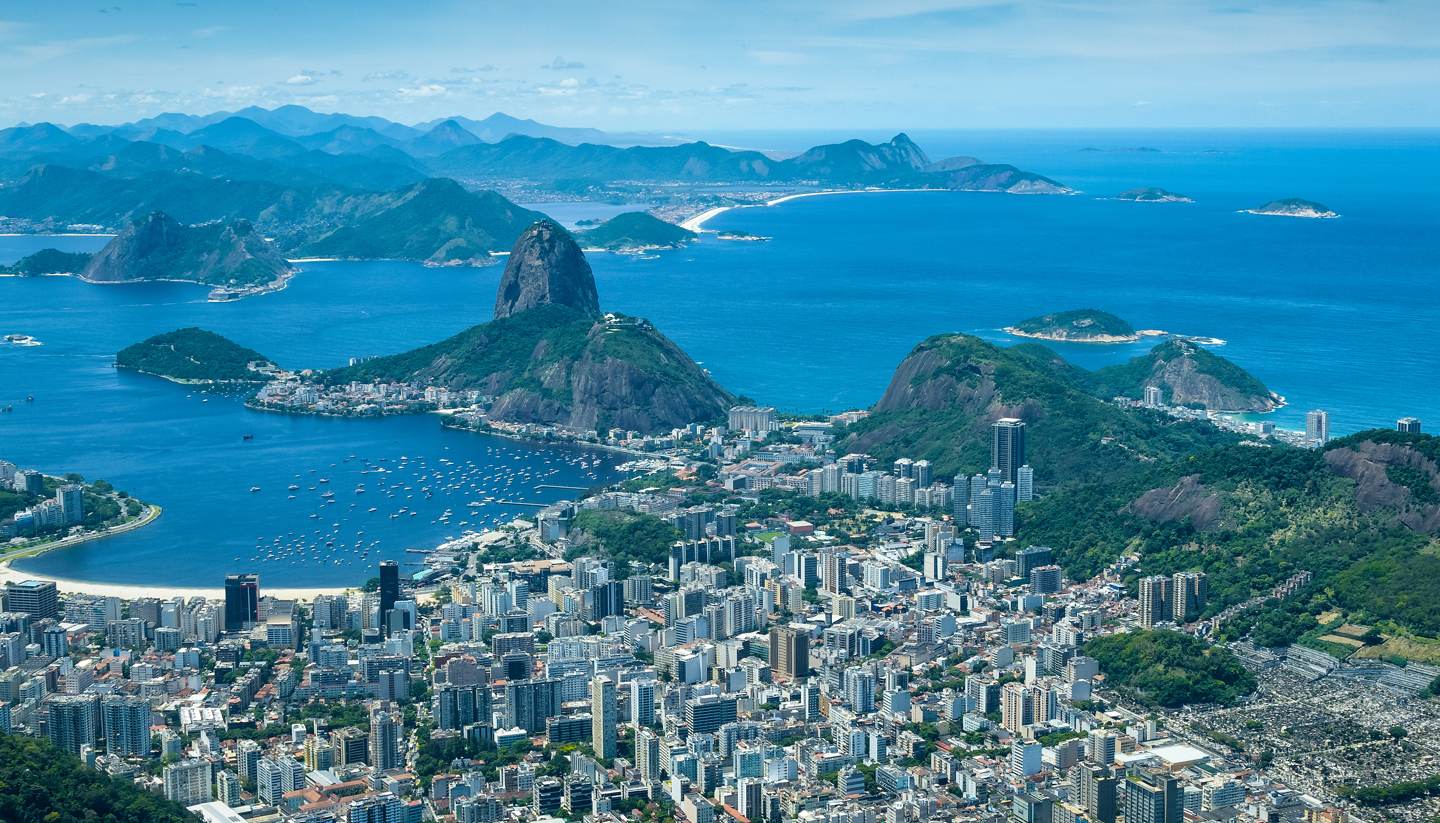
City Highlight: Rio de Janeiro
Vibrant, exciting and dazzling are words synonymous with Rio de Janeiro, one of the world’s favourite party cities
Book a Hotel
© Columbus Travel Media Ltd. All rights reserved 2024
Travel Guide Brazil
Book your individual trip , stress-free with local travel experts
Select Month
- roughguides.com
- South America
- Travel guide
- Itineraries
- Local Experts
- Travel Advice
- Accommodation
Plan your tailor-made trip with a local expert
Book securely with money-back guarantee
Travel stress-free with local assistance and 24/7 support
Just wanted to say that it was incredible. Trip Provider was also incredibly good, and really made their best effort to solve any problems. We were very im...
Brazilians often say they live in a continent rather than a country. It’s an excusable exaggeration. The landmass is bigger than the United States if you exclude Alaska; the journey from Recife in the east to the western border with Peru is longer than that from London to Moscow, and the distance between the northern and southern borders is about the same as that between New York and Los Angeles. Brazil has no mountains to compare with its Andean neighbours, but in every other respect it has all the scenic – and cultural – variety you would expect from so vast a country.
Brazil fact file
Where to go in brazil, festivals in brazil, language in brazil, travel ideas for brazil, created by local experts.

9 days / from 2042 USD
Brazilian Beaches: Copacabana, Botafogo and more
Begin at Foz do Iguaçu, where you will stand in awe of the huge Iguaçu Falls. Next up, we'll head to the lively city of Rio de Janeiro, home of the legendary Copacabana, Botafogo and Flamengo beaches, and of course, Sugar Loaf Mountain and the iconic Christ the Redeemer statue.

10 days / from 1700 USD
Blissful Brazil
Welcome to a lavish journey that marries adventure with style, featuring stays in carefully chosen four-star hotels. This reinvigorating trip will have you sightseeing in São Paulo, gazing at the spectacular Foz do Iguaçu falls and relaxing on Rio's finest beaches before you know it.

10 days / from 2683 USD
Breathtaking Brazil: Rio, Beaches and Waterfalls
Explore the lively city of Rio de Janeiro, home to Ipanema and Copacabana beaches; experience the stunning Foz do Iguaçu National Park and see the world’s largest waterfalls system; immerse yourself in cultural Salvador, the magnificent former capital of Portugal’s New World colony.
Despite the immense expanses of the interior, roughly two-thirds of Brazil’s population live on or near the coast and well over half live in cities – even in the Amazon. In Rio and São Paulo, Brazil has two of the world’s great metropolises, and ten other cities have over a million inhabitants. Yet Brazil still thinks of itself as a frontier country, and certainly the deeper into the interior you go, the thinner the population becomes.
Other South Americans regard Brazilians as a race apart, and language has a lot to do with it – Brazilians understand Spanish, just about, but Spanish-speakers won’t understand Portuguese. Brazilians also look different. In the extreme south German and eastern European immigration has left distinctive traces; São Paulo has the world’s largest Japanese community outside Japan; slavery lies behind a large Afro-Brazilian population concentrated in Rio, Salvador and São Luís; while the Indian influence is still very visible in the Amazon. Italian and Portuguese immigration has been so great that its influence is felt across the entire country.
Brazil is a land of profound economic contradictions. Rapid post-war industrialization made it one of the world’s ten largest economies by the 1990s and it is misleading to think of Brazil as a developing country; it is quickly becoming the world’s leading agricultural exporter and has several home-grown multinationals competing successfully in world markets. The last decade has seen millions of Brazilians haul their way into the country’s expanding middle class, and across-the-board improvements in social indicators like life expectancy and basic education. But yawning social divides are still a fact of life in Brazil. The cities are dotted with favelas , shantytowns that crowd around the skyscrapers, and there are wide regional differences , too: Brazilians talk of a “Switzerland” in the South, centred on the Rio–São Paulo axis, and an “India” above it, and although this is a simplification the level of economic development does fall the further north or east you go. Brazil has enormous natural resources but their exploitation has benefited fewer than it should. Institutionalized corruption, a bloated and inefficient public sector and the reluctance of the country’s middle class to do anything that might jeopardize its comfortable lifestyle are a big part of the problem. Levels of violence that would be considered a public emergency in most countries are fatalistically accepted in Brazil – an average of seventeen murders per day in the city of Rio de Janeiro, for example.
These difficulties, however, don’t overshadow everyday life in Brazil, and violence rarely affects tourists. It’s fair to say that nowhere in the world do people enjoy themselves more – most famously in the annual orgiastic celebrations of Carnaval , but reflected, too, in the lively year-round nightlife that you’ll find in any decent-sized town. This national hedonism also manifests itself in Brazil’s highly developed beach culture , superb music and dancing, rich regional cuisines and the most relaxed and tolerant attitude to sexuality – gay and straight – that you’ll find anywhere in South America.
- By far the largest country in South America, Brazil covers nearly half the continent and is only slightly smaller than the US, with an area of just over 8.5 million square kilometres. It shares a frontier with every South American country except Chile and Ecuador.
- Brazil has around 200 million inhabitants, making it the fifth most populous country in the world.
- Almost ninety percent of Brazil’s electricity is generated from hydropower, about six percent from fossil fuels and six percent from nuclear power. Brazil is becoming an important oil exporter, with new reserves recently discovered offshore from Rio.
- Brazilian exports consist mainly of manufactured products (including automobiles, machinery and footwear), minerals and foodstuffs as varied as coffee, beef and orange juice. But only thirteen percent of GDP comes from exports: Brazil‘s growing domestic economy is the powerhouse of its development.
The most heavily populated part of the country is the Southeast, where the three largest cities – São Paulo, Rio de Janeiro and Belo Horizonte – form a triangle around which the economy pivots. All are worth visiting but Rio, which really is as beautiful as it seems in pictures, is the one essential destination. The South, encompassing the states of Paraná, Santa Catarina and Rio Grande do Sul, is the most economically advanced part of the country and includes much of the enormous Paraná river system. The spectacular Iguaçu Falls on the border with Argentina is one of the great natural wonders of South America.

Central Brazil is dominated by an enormous plateau of savanna and rock escarpments, the Planalto Central. In the middle stands Brasília, the country’s space-age capital, built from scratch in the late 1950s and still developing today. The capital is the gateway to a vast interior, Mato Grosso, only fully charted and settled over the last fifty years; it includes the Pantanal, the largest wetlands in the world and the richest wildlife reserve anywhere in the Americas. North and west Mato Grosso shades into the Amazon, the world’s largest river basin and a mosaic of jungle, rivers, savanna and marshland that also contains two major cities – Belém, at the mouth of the Amazon itself, and Manaus, some 1600km upstream. The tributaries of the Amazon, rivers like the Tapajós, the Xingú, the Negro, the Araguaia or the Tocantins, are virtually unknown outside Brazil, but each is a huge river system in its own right.
The other major sub-region of Brazil is the Northeast, the part of the country that curves out into the Atlantic Ocean. This was the first part of Brazil to be settled by the Portuguese and colonial remains are thicker on the ground here than anywhere else in the country – notably in the cities of Salvador and São Luís and the lovely town of Olinda. It’s a region of dramatic contrasts: a lush tropical coastline with the best beaches in Brazil quickly gives way to the sertão, a semi-arid interior plagued by drought and grinding poverty. All the major cities of the Northeast are on the coast; the two largest are sprawling Recife and Salvador, Brazil’s most heavily Afro-Brazilian city and a fascinating place to visit. The coast of the Northeast is developing rapidly these days, taking advantage of proximity to Europe to attract package tourists and holiday-home buyers. But it is big enough for it still to be possible to get away from it all.
Discover more places in Brazil

- Mato Grosso Travel Guide
- Minas Gerais and Espírito Santo Travel Guide
- The Northeast Travel Guide
- São Paulo Travel Guide
- Brazil South Travel Guide
Carnaval is the most important festival in Brazil, but there are other parties, too, from saints’ days to celebrations based around elections or the World Cup.
When Carnaval comes, the country gets down to some of the most serious partying in the world. A Caribbean carnival might prepare you a little, but what happens in Brazil is more spectacular, goes on longer and is on a far larger scale. Every place in Brazil, large or small, has some form of Carnaval, and in three places especially – Rio, Salvador and Olinda, just outside Recife – Carnaval has become a mass event, involving seemingly the entire populations of the cities and drawing visitors from all over the world.
When exactly Carnaval begins depends on the ecclesiastical calendar: it starts at midnight of the Friday before Ash Wednesday and ends on the Wednesday night, though effectively people start partying on Friday afternoon – over four days of continuous, determined celebration. It usually happens in the middle of February, although very occasionally it can be early March. But in effect, the entire period from Christmas is a kind of run-up to Carnaval. People start working on costumes, songs are composed and rehearsals staged in school playgrounds and backyards, so that Carnaval comes as a culmination rather than a sudden burst of excitement and colour.
During the couple of weekends immediately before Carnaval proper, there are carnival balls (bailes carnavalescos), which get pretty wild. Don’t expect to find many things open or to get much done in the week before Carnaval, or the week after it, when the country takes a few days off to shake off its enormous collective hangover. During Carnaval itself, stores open briefly on Monday and Tuesday mornings, but banks and offices stay closed. Domestic airlines, local and inter-city buses run a Sunday service during the period.
The most familiar and most spectacular Carnaval is in Rio, dominated by samba and the parade of samba schools down the enormous concrete expanse of the gloriously named Sambódromo. One of the world’s great sights, and televised live to the whole country, Rio’s Carnaval has its critics. It is certainly less participatory than Olinda or Salvador, with people crammed into grandstands watching, rather than down following the schools.
Salvador is, in many ways, the antithesis of Rio, with several focuses around the old city centre: the parade is only one of a number of things going on, and people follow parading schools and the trio elétrico, groups playing on top of trucks wired for sound. Samba is only one of several types of music being played; indeed, if it’s music you’re interested in, Salvador is the best place to hear and see it.
Olinda, in a magical colonial setting just outside Recife, has a character all its own, less frantic than Rio and Salvador; musically, it’s dominated by frevo, the fast, whirling beat of Pernambuco, and is in some ways the most distinctive visually, with its bonecos, large papier-mâché figures that are the centrepiece of the Olinda street parades.
Some places you would expect to be large enough to have an impressive Carnaval are in fact notoriously bad at it: cities in this category are São Paulo, Brasília and Belo Horizonte. On the other hand, there are also places that have much better Carnavals than you would imagine: the one in Belém is very distinctive, with the Amazonian food and rhythms of the carimbó, and Fortaleza also has a good reputation. The South, usually written off by most people as far as Carnaval is concerned, has major events in Florianópolis, primarily aimed at attracting Argentine and São Paulo tourists, and the smaller but more distinctive Carnaval in Laguna. For full details of the events, music and happenings at each of the main Carnavals, see under the relevant sections of the Guide.
Other festivals
The third week in June has festas juninas, geared mainly towards children, who dress up in straw hats and checked shirts and release paper balloons with candles attached (to provide the hot air), causing anything from a fright to a major conflagration when they land.
Elections and the World Cup are usually excuses for impromptu celebrations, while official celebrations, with military parades and patriotic speeches, take place on September 7 (Independence Day) and November 15, the anniversary of the declaration of the Republic.
In towns and rural areas, you may well stumble across a dia de festa, the day of the local patron saint, a very simple event in which the image of the saint is paraded through the town, with a band and firecrackers, a thanksgiving Mass is celebrated, and then everyone turns to the secular pleasures of the fair, the market and the bottle. In Belém, this tradition reaches its zenith in the annual Cirio on the second Sunday of October, when crowds of over a million follow the procession of the image of Nossa Senhora de Nazaré, but most festas are small-scale, small-town events.
In recent years, many towns have created new festivals, usually glorified industrial fairs or agricultural shows. Often these events are named after the local area’s most important product, such as the Festa Nacional do Frango e do Peru (chickens and turkeys) in Chapecó. Occasionally, these local government creations can be worth attending as some promote local popular culture as well as industry. One of the best is Pomerode’s annual Festa Pomerana, which takes place in the first half of January and has done much to encourage the promotion of local German traditions.
Football in Brazil
Going to a football match in Brazil is something even those bored by the game will enjoy as spectacle: the stadiums are sights in themselves and big matches are watched behind a screen of tickertape and waving flags, huge banners, massed drums, fireworks and firecrackers, to the chants, roars and whistling of the world’s most passionate football supporters.
Brazil’s major teams are concentrated in Rio and São Paulo. In Rio, Flamengo is the best-supported team in the country, and its distinctive shirt of red and black hoops is seen everywhere. Its clashes with perennial Rio rival Fluminense (maroon, green and white stripes) is one of the most intense matches in Brazilian club football, rivalled only by the games between São Paulo’s two leading teams, São Paulo (white with red and black hoops) and Coríntians (white). In Rio, Botafogo (black and white stripes with the famous white-star badge) and Vasco (white with black diagonal stripe) vie with Fla-Flu for dominance, while Palmeiras (green) and Santos (white) make up the big four in São Paulo. The only teams that consistently live with the best of Rio and São Paulo are Internacional (red) and Grêmio (blue, white and black stripes) from Porto Alegre, and Atlético Mineiro (white) and Cruzeiro (dark blue) from Belo Horizonte.
Brazilian stadiums tend to be enormous, concrete, and with a few exceptions rather dingy and lacking in character: they are rarely full save for clássicos, matches between major teams, and rely on the supporters rather than their architecture for colour and feeling. Most pitches are separated from supporters by a wide running track and sometimes even a moat, which puts the play further from the terraces than British fans will be used to. But some stadiums are worth going out of your way for: the Maracanã in Rio, it goes without saying, but also the beautiful Art Deco Pacaembú in São Paulo. No football fan should visit Rio without leaving a morning for the excellent tour of the Maracanã, or miss the superb new Museu de Futbol when in São Paulo.
Tickets are very cheap by European standards; good seats at a clássico will cost no more than R$50, but an ordinary match will be half that or less – the issue is availability rather than price. For clássicos, hotels often have packages that include transport, tickets and a guide for around R$100 all in, an expensive way of doing it but often the only practical option if you can’t get a ticket a few days in advance. For ordinary matches, you can almost always turn up half an hour beforehand and look for the bilheteria, the ticket office, which usually only takes cash. All stadiums are two-deckers, most are now all-seaters but a few still have terracing on the lower deck: upper-deck seats are arquibancada, lower-deck geral. There is not as much of a problem with crowd violence in Brazil as in many European countries, but don’t wear a Brazilian club shirt just to be on the safe side: non-Brazilian shirts are no problem (except for Argentinian ones – the two countries don’t get on well in footballing terms), and Brazilian fans are extremely friendly to foreigners. December is the off season; otherwise, a mixture of state and national championships ensures constant football.
Learning some Portuguese before you go to Brazil is an extremely good idea. Although many well-educated Brazilians speak English, and it’s now the main second language taught in schools, this hasn’t filtered through to most of the population. If you know Spanish you’re halfway there: there are obvious similarities in the grammar and vocabulary, so you should be able to make yourself understood if you speak slowly, and reading won’t present you with too many problems. However, Portuguese pronunciation is utterly different and much less straightforward than Spanish, so unless you take the trouble to learn a bit about it you won’t have a clue what Brazilians are talking about. And contrary to what you might expect, very few Brazilians speak Spanish themselves.
Unfortunately, far too many people – especially Spanish-speakers – are put off going to Brazil precisely by the language, but in reality this should be one of your main reasons for going. Brazilian Portuguese is a colourful, sensual language full of wonderfully rude and exotic vowel sounds, swooping intonation and hilarious idiomatic expressions. You’ll also find that Brazilians will greatly appreciate even your most rudimentary efforts, and every small improvement in your Portuguese will make your stay in Brazil ten times more enjoyable.
People who have learned their Portuguese in Portugal or in Lusophone Africa won’t have any real problems with the language in Brazil, but there are some quite big differences. There are many variations in vocabulary, and Brazilians take more liberties with the language, but the most notable differences are in pronunciation: Brazilian Portuguese is spoken more slowly and clearly; the neutral vowels so characteristic of European Portuguese tend to be sounded in full; in much of Brazil outside Rio the slushy “sh” sound doesn’t exist; and the “de” and “te” endings of words like cidade and diferente are palatalized so they end up sounding like “sidadgee” and “djiferentchee”.
Carnaval plunges Brazil into the most serious partying in the world. Mardi Gras in New Orleans or Notting Hill in London are not even close; nothing approaches the sheer scale and spectacle of Carnaval in Rio, Salvador and Olinda, just outside Recife. But Carnaval also speaks to the streak of melancholy that is the other side of the stereotype of fun-loving Brazil.
Part of the reason is Carnaval’s origins at the time when Brazil was still the largest slaveholding country in the Americas. The celebrations just before Lent acquired a kind of “world turned upside down” character, with slaveowners ceremonially serving their slaves food and allowing them time off work – giving a particularly double-edged feel to Carnaval as servitude reasserted itself come Ash Wedneday. Brazil has come a long way since then, but the traditional freedom to transgress that comes with Carnaval gives its partying an edge that deepens in the small hours, as alcohol and crowds generate their usual tensions – the already high murder rate hits its peak over the festival and traffic deaths are also at their annual high. There is a big difference between day and night. Carnaval during the day is for families, and you can relax along with the Pierrots, masks and brass bands that ply the streets and squares: if you travel with children they will remember a good Carnaval for the rest of their lives. Carnaval at night is memorably spectacular in Rio and the biggest street party you will ever see in Salvador and Olinda, but it’s best to keep your wits about you and your head clear. For more information, see Carnaval dates and the relevant sections of the guide for more information.
Travel advice for Brazil
From travel safety to visa requirements, discover the best tips for traveling to Brazil
- Eating and drinking in Brazil
- How to get to Brazil
- Getting around Brazil: Transportation Tips
- Travel Tips Brazil for planning and on the go
The Rough Guides to Brazil and related travel guides
In-depth, easy-to-use travel guides filled with expert advice.

Find even more inspiration here

Planning your own trip? Prepare for your trip
Use Rough Guides' trusted partners for great rates
written by Rough Guides Editors
updated 26.04.2021
Ready to travel and discover Brazil?
Get support from our local experts for stress-free planning & worry-free travels.
- Where to stay
- Travel advice
A beginner's guide to Brazil

Jan 21, 2016 • 7 min read

A couple with backpacks overlook Rio de Janiero, Brazil.
What do you get if you combine cinematic landscapes, kaleidoscopic culture, head-spinning biodiversity and a constant rhythm of carefree joie de vivre? Welcome to Brazil!
The world's fifth-largest country commandeers the lion's share of South America , all the way from the Amazon Basin – the world's largest tropical rainforest – to the pampas of southernmost Rio Grande do Sul, delivering 7500kms of sun-toasted sands in between.
It is these postcard-perfect shores for which Brazil is arguably most famous, but this Latin giant boasts far more than beaches. Lush jungle? Check. Colonial villages? Check. Unparalleled wildlife? Check. Delectable restaurants and pulse-pumping nightlife? Check. Stunning waterfalls, canyons, mountains and dunescapes? Pronto, pronto, pronto and pronto!
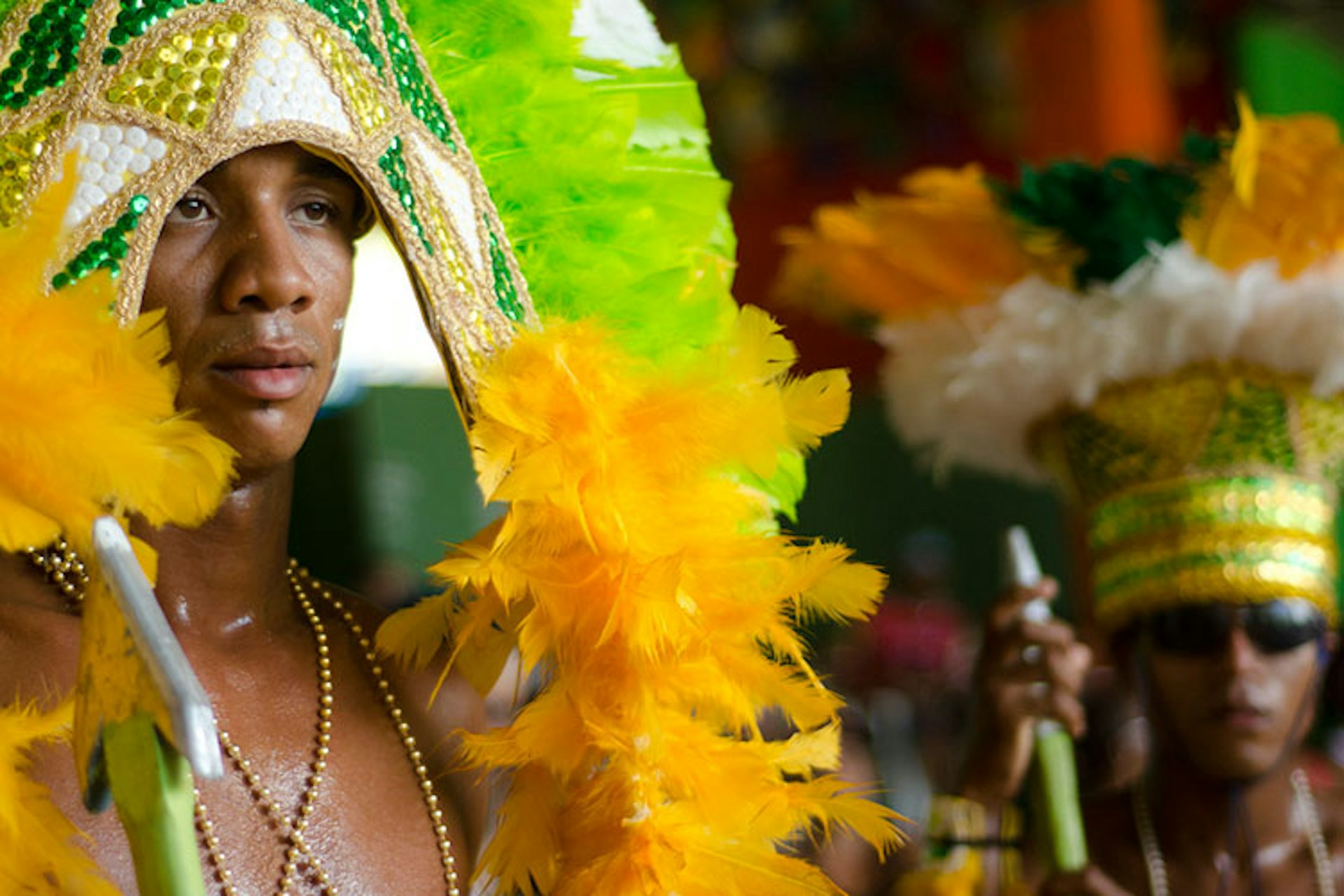
Brazil owes its language and much of its cultural potpourri to Portugal – both unique compared to its Spanish-settled South American neighbors – whose explorers arrived in the 1500s and settled what was then a land of largely indigenous inhabitants numbering between two and four million people. Waves of immigration from Africa , Europe and the Middle East have shaped and enriched the country throughout history. Today, with a population of nearly 200 million, Brazil is one of the world's most diverse nations.
A tropical wonderland
A visit to Brazil usually begins in Rio de Janeiro , one of the world's most vibrant urban landscapes, where dramatic, rainforest-crowned mountaintops surround a city nestled picturesquely between jungle and sea. The Amazon region – and its namesake river – are home to the planet's greatest collection of plants and animals, and this enigmatic landscape has long intrigued explorers, naturalists, novelists and travelers alike. Brazil's other hotspot for biodiversity, the Pantanal , is the world's largest wetland, where every moment throws up another photo opportunity full of colorful birds and wildlife.

The roar of Iguaçu Falls will redefine your idea of the power of Mother Nature; this torrent thundering over the edges of cliffs is a spectacle without rival. And in a country with no shortage of world-class beaches, the archipelago of Fernando de Noronha serves up three of the best, and then adds the distinction of being Brazil's top spot for diving and surfing, and one of the best places on Earth to mingle with endangered sea turtles and Spinner dolphins.

But wait, there's more! Pristinely preserved colonial villages (Ouro Prêto, Tiradentes, Paraty , Olinda), scenic national parks (Lençóis-Maranhenses ( parquelencois.com.br ), Chapada Diamantina , Chapada dos Veadeiros ( whc.unesco.org/en/list/1035 ), Chapada dos Guimarães ), idyllic tropical islands ( Ilha Grande , Ilhabela , Ilha de Santa Catarina, Morro de São Paulo , Boipeba, Ilha do Mel) and an even longer list of diverse regional cuisine and culture, from the African-fueled state of Bahía to the heavily German and Italian-influenced states of Santa Catarina and Rio Grande do Sul , all unite in a seductive marriage that ticks off a traveler's wishlist.
Olympic fever (and fears)
Summer 2016 brings the Olympic Games to Rio de Janeiro, the first time the world's most important amateur athletic event has been held on South American soil. From August 5-21, 2016, the world's spotlight will once again focus on Brazil in much the same way it did for the 2014 FIFA World Cup. And much like the world's greatest football tournament, the lead-up to the event has not been without controversy and concern.

For starters, the Brazil of 2016 is a very different country than the Brazil of two years prior, so economic woes and rising inflation have plagued costs and budgets. Several of the 14 under-construction Olympic venues are behind schedule, as are most infrastructure projects associated with the event, such as the new metro line built to link the city with the Olympic Park in suburban Barra di Tijuca. Finances and construction woes aside, a 2015 Associated Press investigation revealed dangerously high levels of viruses and bacteria in all of Rio’s Olympic water venues, most notably Guanabara Bay, the host site for sailing and windsurfing events, and Lagoa Rodrigo de Freitas, which will host rowing and canoeing events. The lead-up to the 2014 FIFA World Cup spawned similar pre-event outcry, but despite deeply concerning construction, budget, crime and social unrest woes, Brazil pulled off an excellent party in the end – and by all accounts, from athletic and spectator perspectives, the tournament was a roaring success.
The bottom line? Brazil has its fair share of problems, but throwing a party isn't one of them. The friendliness and hospitality of the Brazilian people and a deep pride in proving the naysayers wrong when the world's eyes are focused on the country will always prevail in the end. It's safe to say you can expect a wonderful Olympic Games, made all the more cinematic against the backdrop of one of the world's most remarkably gorgeous cities, Rio de Janeiro.
Visa-Free Travel
If you're planning on traveling to Brazil in 2016, and are a citizen of the United States, Canada, Japan or Australia, you're in luck. Brazil has announced the waiving of visa requirements for those nationalities entering the country through September 18, 2016, for a stay of up to 90 days.
During the much ballyhooed Brazil boom of the early 2000s, there was no sugarcoating it: Brazil was expensive. By 2016, however, the Brazil boom had flip-flopped to the Brazil gloom. The overvalued r eal has come crashing back down to earth amid a fast and furious economic collapse spurred by government mismanagement, rampant corruption scandals, alarming inflation and a president, Dilma Rousseff, who may or may not make it through her second term (impeachment proceedings remain a dark and looming cloud over her head). But what does a Brazilian economy in tatters (and projected to decline further) mean in practical terms from a tourism perspective? Brazil is on sale! With the r eal spending the better part of recent times hovering around R$3.7-4 to US$1, that gourmet burger that cost nearly US$20 in 2011 now costs just US$7. Bom apetite!
Brazil's official language is Portuguese. English is still under-spoken by most Brazilians, even by folks working in hospitality in major tourist destinations.
Brazil is home to extensive air and bus networks. The country's major domestic airlines include Latam ( latam.com) , the re-branded offering from the recent merger of Lan and Tam Airlines; Gol ( voegol.com.br ), Azul ( voeazul.com.br ) and Avianca ( avianca.com ). Most visitors arrive at Antônio Carlos Jobim International Airport (Galeão; aeroportogaleao.net/en ) in Rio de Janeiro or Aeroporto Internacional de Guarulhos (GRU Airport; aeroportoguarulhos.net/en ) in São Paulo , but there are also international arrivals in Brasília , Fortaleza , Natal , Recife , Salvador , Belo Horizonte and Porto Alegre , among others. Flights are expensive, though competition-spawned mega-sales are common and, if you are covering a lot of ground, a Brazil Airpass is your new best friend. Miami-based BR Online Travel (BROL; brol.com ) specializes in passes, which are available only to foreign visitors.
Itapemirim ( itapemirim.com.br ) and Cometa ( viacaocometa.com.br ) are two of the biggest and best bus companies. For a national database of bus routes, try Busca Ônibus ( buscaonibus.com.br) or ClickBus ( clickbus.com.br) , the latter accepting international credit cards and PayPal for payments. Fares begin around R$10 to R$12 per hour for the cheapest services and rise from there in price and comfort level.
In addition to the usual traveler precautions, malaria is a concern in certain areas of the Amazon and northwest Brazil. Travelers should weigh the risks of an appropriate preventative (chloroquine is not effective here), and cover up as much as possible to prevent mosquito bites. Brazil has become the epicenter of mosquito-borne dengue fever in Latin America, especially in and around Rio and in Bahía. Pregnant women in particular should take extreme caution against mosquitoes while in Brazil as an alarming surge in cases of the Zika virus in 2015 was blamed for 20 times more cases of an incurable fetal deformity known as microcephaly than previous years.
Tap water is safe in most urban areas but doesn't win any taste competitions. Bottled water is preferred by most Brazilians.
Brazil receives a lot of bad press about its violence and high crime rate but the country is generally safe for tourists. That said, extra precaution should be taken in major urban areas, Rio de Janeiro, Recife and São Paulo in particular.
Besides all of the standard-issue traveler safety provisions, heed some added warnings: never take anything of value to the beach, use ATMs only inside banks or shopping malls, and do not walk along empty streets, deserted parks or urban beaches at night.
This article was first published in December 2013 and updated in January 2016.
Explore related stories
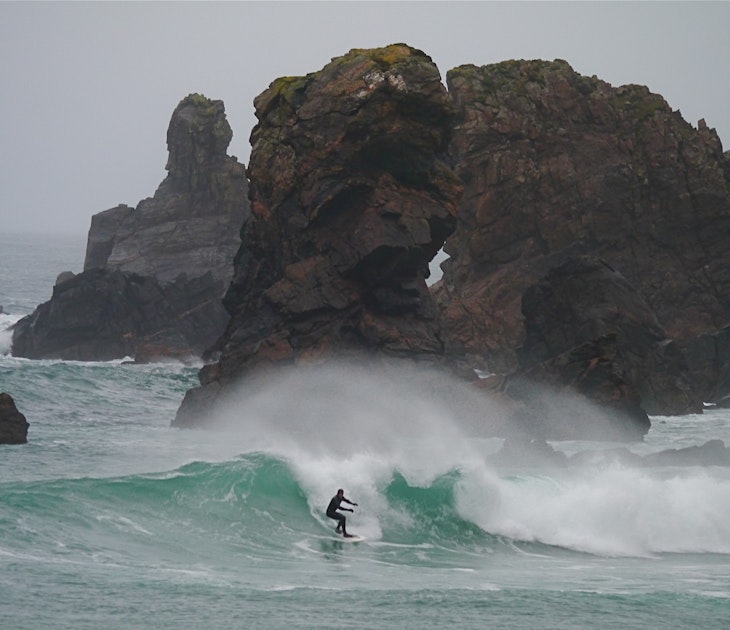
Aug 16, 2022 • 12 min read
Here are the top 9 surfing spots in Europe for 2022, according to professional surfers, photographers and writers.
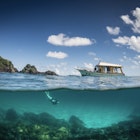
Oct 23, 2019 • 6 min read
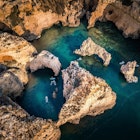
Sep 30, 2019 • 4 min read

Oct 28, 2013 • 8 min read

May 17, 2024 • 6 min read

May 17, 2024 • 14 min read

Apr 30, 2024 • 5 min read
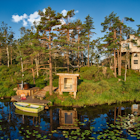
Apr 30, 2024 • 8 min read

Apr 19, 2024 • 10 min read
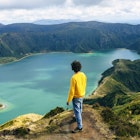
Apr 15, 2024 • 8 min read

Brazil Travel Guide
Your complete brazil travel guide, with our tips, ideas on things to do, and best things to see in brazil. great for first-time travelers..
Brazil is the largest country in South America and a top tourist destination. In fact, Brazil has its own Ministry of Tourism, which ensures touring is as easy as possible for visitors.
It is a fun, vibrant country and home to iconic landmarks, including Iguazu Falls and the towering Christ the Redeemer statue.
Explore the Amazon Rainforest, go to one of many (over 2,000) beaches, meet friendly and diverse locals, or try some authentic Brazilian cuisine. There is a lot to see and do here.
This Brazil travel guide will help you plan your next vacation.
Popular Guides
- Rio de Janeiro
- Iguassu Falls
- Brazil Cuisine
Our Highlight
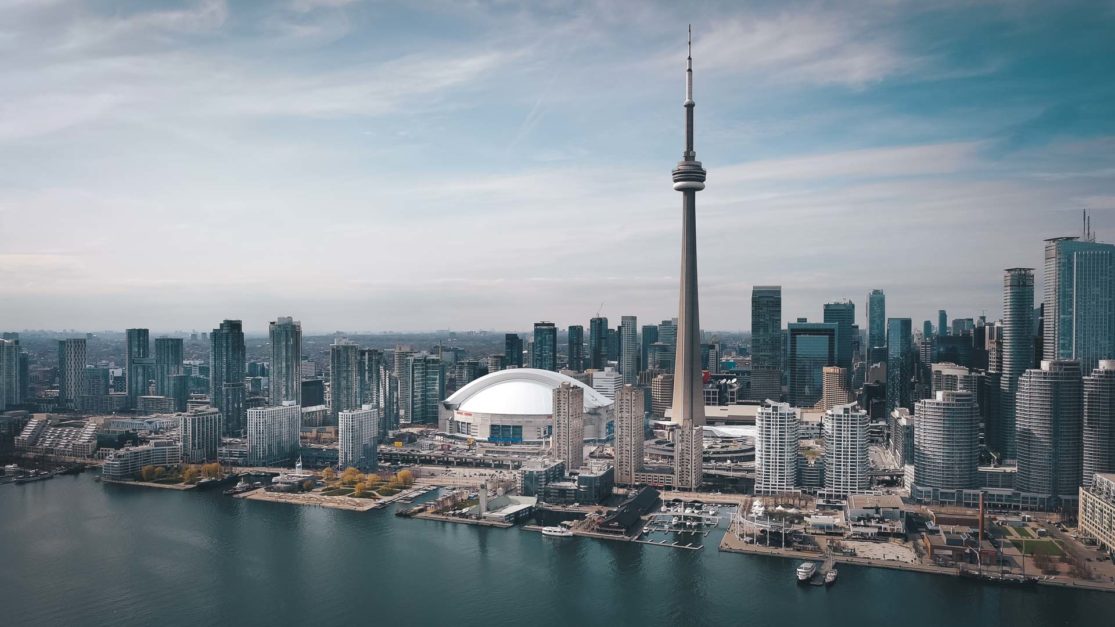
Table of contents
Table of Contents
Fast Facts about Brazil
- Power voltage is 127V- 220V at 60 Hz depending on location. About 60% of households use 127V. Plug C and N.
- Brazil’s currency is the Brazilian Real (R$) and 1 R$ is equal to 0.26 USD.
- Traveling by bus is considered the best way to get around Brazil.
- You no longer need a tourist visa, just a valid US passport.
- The most popular cellular networks in Brazil are Vivo, TIM, and Oi. You can purchase a prepaid SIM card through these networks.
- VAT: The state average value-added tax (VAT) comes at 17%, though it goes 18% in São Paulo, Minas Gerais and Paraná, and 19% in Rio de Janeiro.
- Language: Remember Brazilians do not speak Spanish, they speak Portuguese. Try to avoid speaking to Brazilians in Spanish as its not the same language and they won’t necessarily understand what you are saying. Furthermore, English is not widely spoken, even in tourist cities of Rio de Janeiro and São Paulo, so brush up on some basic Portuguese words and sayings before you go. Remember it’s not Gracias but Obrigado | Obrigada.
Things to See and Do in Brazil
- Fly ov e r Rio de Janeiro: Rio needs to be seen from a helicopter to truly take in the scope of its beauty. Helisul is the premier helicopter tour operator in the city, and we can understand why, these guys were friendly, welcoming and top-notch.
- Go See Iguassu Falls : Iguassu Falls is one of the must-see natural wonders on earth. As a matter of fact, it was recently named one of the new 7 Natural Wonders in the world.
- Sandboard in Floripa: Sandboarding at the dunes of the famous Joaquina beach, one of the most famous beaches of Florianopolis.
- Visit the Ecotourism capital of Brazil: if you are craving an adventure, than Bonito in Mato Grosso do Sul is the just the place for you. Our recommendation? Abismo Anhumas a huge, stalactite-covered cavern that offers abseiling and diving in an underground lake.
- Visit the Amazon and stay at the Uakari Lodge : the lodge is managed by shared management among Mamirauá Institute and the communities from Mamirauá Reserve. The enterprise’s aim is to generate income for the local people and to contribute to natural resources’ preservation. Ten communities from the reserve act managing the Lodge, the employees, the contractors, and the salespeople.
- Visit Copacabana and Ipanema Beach: While in Rio, we tried three different hotels on three different beaches. If you are going to stay in Rio, you may be interested in one of these three Rio hotels.
- See Christ the Redeemer: One of the most iconic things to do in Rio de Janeiro is to visit Christ the Redeemer. It’s one of the most recognized in the world. When picturing Rio, this is what everyone envisions. Christo Redentor stands proudly over the city at the top of Corcovado Mountain.
- Visit Jericoacoara: Jeri is a very special fishing village on the northeast coast of Brazil in Ceara, 330 kilometers northwest of Fortaleza. It was once hailed as having one of the ten most beautiful beaches in the world by the Washington Post. Jericoacoara is surrounded by dunes, freshwater lagoons and set in a national park. The only way to get to Jeri is a 4×4 Jardineira vehicle or buggy. It is known as the perfect place for kitesurfers and surfers. Paradise is waiting.
- Take a Favela Tour: If you want to learn more about Rio culture, take a favela tour to visit local communities. There are 800 favelas in Rio and nearly 1.5 million people inhabit these communities.
- Explore the Downtown of Rio de Janeiro: Downtown Rio is definitely worth spending a day to explore. The alleyways are charming mazes filled with cafés and stores. There’s markets, cathedrals, museums, and monasteries. If you get a chance, be sure to take a Rio City tour.
- See the Museum of Tomorrow: Opening in December 2015, it is one of the world’s most extraordinary architectural designs.
- Go on on an Afro-Walking Tour: Did you know that Rio was the largest slave port in history? It is also the birthplace of samba. Learn about the rich history of Rio de Janeiro on this incredibly informative walking tour.
Brazil Travel Guides
- Things to do in Rio de Janeiro
- Things to do in Iguassu Falls
- Top Brazil Cuisine
Accommodation
Budget: Brazil offers many hostels in the range of 50-100 Brazilian Reals per night.
Mid-Range: For mid-range hotels, expect to pay around 190-260 Brazilian Reals per night.
High-End: Upscale hotels will cost 350-750 Brazilian Reals per night.
Check out our favorite booking platforms Booking.com , Tripadvisor and VRBO for the best deals on accommodation.
Brazil offers many exciting options for food. Bolinhos de bacalhau (codfish balls) and pastels (deep-fried stuffed pastries) are some of the things you can find when in Brazil. Expect to pay around R$15 for a meal, or R$55 total per day.
Food: If you’re hungry, we would highly recommend visiting a por kilo restaurant. The concept is just like a buffet but in the end, you weigh your food and pay in terms of weight. The por kilo restaurants have a huge variety of delicious food, including some Brazilian favorites like farofa [a toasted cassava flour mixture], feijão, pastel [think deep-fried empanadas] and of course grilled-to-order meat [with garlic sauce!]. Yum!
Drinks: Make sure to drink a Caipirinha! It Brazil’s national cocktail, made with cachaça, sugar, and lime. They also make fruit caipirinhas, we would recommend the maracujá [passion fruit] caipirinha.
The tap water in Brazil is increasingly safe to drink. However, as a result of the treatment process, it still doesn’t taste great. To be on the safe side, drink bottled or filtered water (most Brazilians do). All brands are reliable; ask for agua sem gas for still water and agua com gas for carbonated water.
Water: If you ask for water in a restaurant, you will be served with a bottle of water (charged to your account) unless you specifically request água da casa [water of the house].
The Best Ways to Get Around Brazil
Getting to brazil:.
Getting to Brazil: If going to Rio de Janeiro, the Galeão Airport is one of the best and is located just 12 miles from the city center. For those traveling to São Paulo, São Paulo-Guarulhos International Airport is the best.
You can check for the best flights on Skyscanner .
Transportation:
Bus: Buses are a cheap way to get around Brazil, as well as the preferred way to travel locals. Fares are 3 to 4 Brazilian Reals for one way.
Train: Trains are rarely used in Brazil except for cargo, though there are a few train rides made for tourists. To learn more, click here.
Renting a car: To rent a car in Brazil, you must be at least 21 years old, have a valid driver’s license and passport. Prices start around 8 Brazilian Reals per day. Check out Rentlcars.com to compare the best rates
When to go To Brazil
As the temperature is great year-round (an average of 80s degrees Fahrenheit), the best time to visit depends on what you want to do.
If you want to see as many animals in the Amazon as you can, going between April to October is your best bet.
If traveling to Rio, December to March is the driest season and is also the season when popular events like the New Year’s Eve celebration (Réveillon) and the Fat Tuesday festival occurs.
For the cheapest flights, go in March.
Where to Stay in Brazil
Hilton Barra Rio de Janeiro: This 5-star hotel is bus accessible and a short walk to the Maria Lenk Aquatic Center, Citibank Hall, and the beach. The Hilton provides a full range of services, including babysitting, laundry, room service, bicycle rentals, a fitness room, outdoor pool and lounge area, and wheelchair ramps, as well as gorgeous views of Rio de Janeiro.
Hotel Nacional Inn Campos do Jordão: This three-star hotel is located in the entertainment center of Sao Paulo. Whether traveling alone, with a partner, or with a family, this hotel has multiple options for rooms, including a Quadruple room for up to 4 guests, and a romantic room complete with complimentary rose petals. Free high-speed Wi-Fi, a fitness room, minibars, sport court, and game room, and breakfast are also included.
Sol Bahia: Right by the water, this casual hotel offers beautiful ocean and beach views from the hotel. It’s just a few miles from Salvador shopping. The hotel also comes with a children’s play area, restaurant and bar, an outdoor pool, free Wi-Fi, single and family rooms, and LCD TVs with cable, among other things.
Read our recommendations at Three Great Hotels in Rio on the Best of the City’s Beaches
Brazil Accommodation Guides
- Three Great Hotels in Rio on the Best of the City’s Beaches
- The Top 18 Most Excellent Things to do in Rio de Janeiro
- Ultimate Iguazu Falls Tour
What to Pack for Brazil
Packing for Brazil can be tricky depending on the areas that you will be visiting and the time of year.
Temperatures below the equator are high and there is very little seasonal variation, although at times it can get cool enough to wear a jacket.
If visitors venture more South, especially during Brazil’s winter months [June – September], expect much colder temperature with the possibility of frost or even snow [although rare].
The cities of Belo Horizonte and Brasília have moderate temperatures, usually between 15 and 30 °C (59 and 86 °F). Rio de Janeiro, Recife, and Salvador on the coast have warm climates, with average temperatures of each month ranging from 23 to 27 °C (73 to 81 °F), but enjoy constant trade winds.
Winter in Rio de Janeiro can be chilly. The cities of São Paulo, Curitiba, Florianópolis and Porto Alegre have a subtropical climate similar to that of the southern United States, and temperatures can fall below freezing in winter.
- Leave your valuables at home – New Apple watch? Expensive diamond earrings? Gold chain? Leave all your shiny, expensive valuables at home.
- Classic Basic items – You do not need to be a fashionista to blend in. The key is in embracing neutrally toned items that can be mixed and matched easily. Avoid logos, baseball caps, shorts, hoodies, flip-flops, and running shoes as these items scream tourist!
- Personal Safety products – Certain areas in Brazil are known as pickpocket hotspots; before leaving for your trip, make sure to pack some personal safety products , like money belts and locks, so that you can keep
- Get Medical Insurance – adventure and eco-travel is common in Brazil; if you plan on trekking in the Amazon; paragliding and/or hiking, make sure to be covered just in case .
- Bug Spray! – As of April 2017, the World Health Organization has updated their yellow fever vaccination recommendations in terms of Brazil as the yellow fever virus transmission continues to expand towards the Atlantic coast of Brazil in areas not deemed to be a risk for yellow fever transmission prior to the review risk assessment.
- As a result of this make sure to cover exposed skin by wearing long-sleeved shirts and long pants, use EPA-registered insect repellents containing DEET, picaridin, oil of lemon eucalyptus (OLE, also called para-menthane-diol [PMD]), IR3535, or 2-undecanone (methyl nonyl ketone)(Always use as directed) OR Use permethrin-treated clothing and gear (such as boots, pants, socks, and tents).
- Lastly, if you are traveling from Brazil to another country make sure to check if you need a yellow fever vaccination certificate or might be denied entry.
- Rain gear – if you plan on visiting São Paulo and/or Rio in the wintertime, be prepared for rain; make sure to bring along an umbrella and/or a raincoat.
Brazil Travel Guide: Best Booking Resources
Whenever we travel to we make sure to start with these companies. We have tried a lot of different ones over the years and all of these have consistently proven to be the best when it comes to offering great prices.
We have used every one of these personally and continue to do so.
- Booking.com : This is our go site to when comparing prices for accommodation. It usually has the cheapest prices, especially in Europe and we love their interface. Not to mention you get free cancellation and you are guaranteed the best price.
- Trip Advisor : What we like about Trip Advisor is that we can look at all the reviews and then book our accommodation. TripAdvisor is where we go when we want to compare prices with multiple accommodation providers.
- VRBO : is the main search engine we use when we are looking for a home or apartment rental. It can sometimes be cheaper than hotels and it is the best way to stay in areas that offer a more local feel.
- Hostelworld : With one of the largest databases of hostels in the world, Hostelworld is the go-to site when you are looking for budget accommodation.
- Skyscanner : This is the first place we check for flights. It consistently comes back with the cheapest and best options. It allows us to compare a lot of airlines to get the best price.
- Rome 2 Rio : If you want to see how to get somewhere by plane, train, bus, ferry or car Rome2Rio lays it all out for you as well as related costs.I love how they show it all to you on a Google Map and it works offline.
- Get Your Guide: For all your day trip and city guide needs, we use Get Your Guide. It has the world’s largest collection of things to do with more than 30,000 activities in 7500 destinations.
- World Nomads Insurance: When traveling to Italy you should always have travel insurance. We have found the best bang for your buck is by far World Nomads.
Brazil Travel Guide: Related Articles
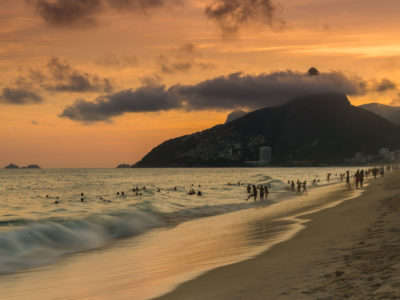
18 Fun and Interesting Facts about Brazil
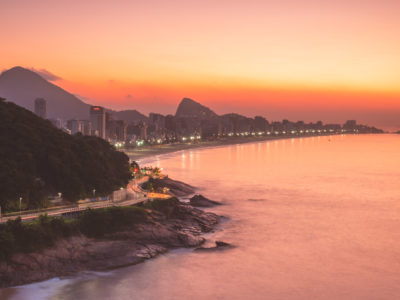
Where to stay in Rio De Janeiro In 2024 – The Best Hotels and Neighborhoods
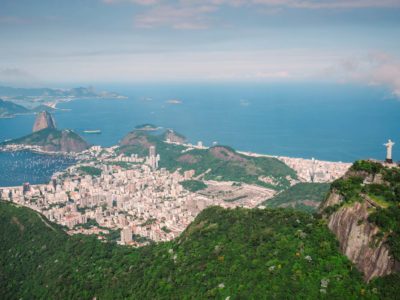
28 Best Things to Do in Rio De Janeiro in 2024

Ultimate BRAZIL Travel Guide
Brazil is a country located in South America . Brasilia is the capital and it is a country known for its natural wonders, culture, architecture, and diversity. Our Brazil travel guide is here to help you see the best it offers.
Brazil eluded us for some time before we finally made a visit. We won’t lie to you, we were a bit put off by the crime and violence that is associated with the country. Having been now, though, we can’t believe we waited so long.
Rio de Janeiro easily made its way onto our list of favorite cities in the world. The way the city combines nature with urbanism is so unique. Taking a favela tour opened our eyes to the class system that haunts the country.
We spent three weeks traveling around Brazil and planned our visit to coincide with the world-famous Carnival.
Destinations
Brazil travel: quick tips, don’t visit brazil without:.
UNIVERSAL TRAVEL ADAPTER

GET A GUIDEBOOK

REUSABLE WATER BOTTLE

START PLANNING YOUR TRIP TO BRAZIL!
Where to stay in brazil.
Below you will find some of the places we have stayed during our travels in Brazil. These are individual properties that we enjoyed and would recommend to other travelers.
HOW TO GET AROUND IN BRAZIL
Anyone looking to travel to Brazil will likely fly into Rio de Janeiro or Sao Paulo and connect to the other airports across the country. From these major cities, it is possible to use public transportation to see the city or take buses further afield.
Many people choose to engage in group tours or day tours to get around and see things in Brazil. It is also possible to rent a car and plan a road trip that takes you further afield and out of the city.
TOP BRAZIL TOURS
Wonders of brazil.
15 Days from Rio de Janeiro Visits: Ilha Grande, Paraty, Iguazu Falls, Bonito & Pantanal
EXPLORE BRAZIL – NAT GEO
9 Days from Rio de Janeiro Visits: Rio de Janeiro, Pantanal & Iguazu Falls
HIGHLIGHTS OF BRAZIL
8 Days from Rio de Janeiro Visits: Rio de Janeiro, Ilha Grande, Saco do Mamanguá and Paraty
DON’T MISS OUT ON ANY OF THE GOOD STUFF!
Brazil travel: booking resources, brazil travel guide: related articles.
Looking for more info? Check out all the articles we’ve written on travel to Brazil and start planning your dream trip.
The Best Way to Visit Iguazu Falls: Argentina or Brazil?
Pantanal in brazil: ultimate guide to the world’s largest wetlands, bonito, brazil: ultimate planning guide + why you should go, paraty, brazil: ultimate planning guide, the best favela tour in rio: defeating the stigma, 40 bucketlist things to do in rio de janeiro, two week trip to brazil itinerary for any traveler, ilha grande, brazil: ultimate planning guide to a paradise found, 16 amazing things to do in brazil.

- Destinations
- Central & South America

Brazil Travel Guide
Last Updated: April 29, 2024
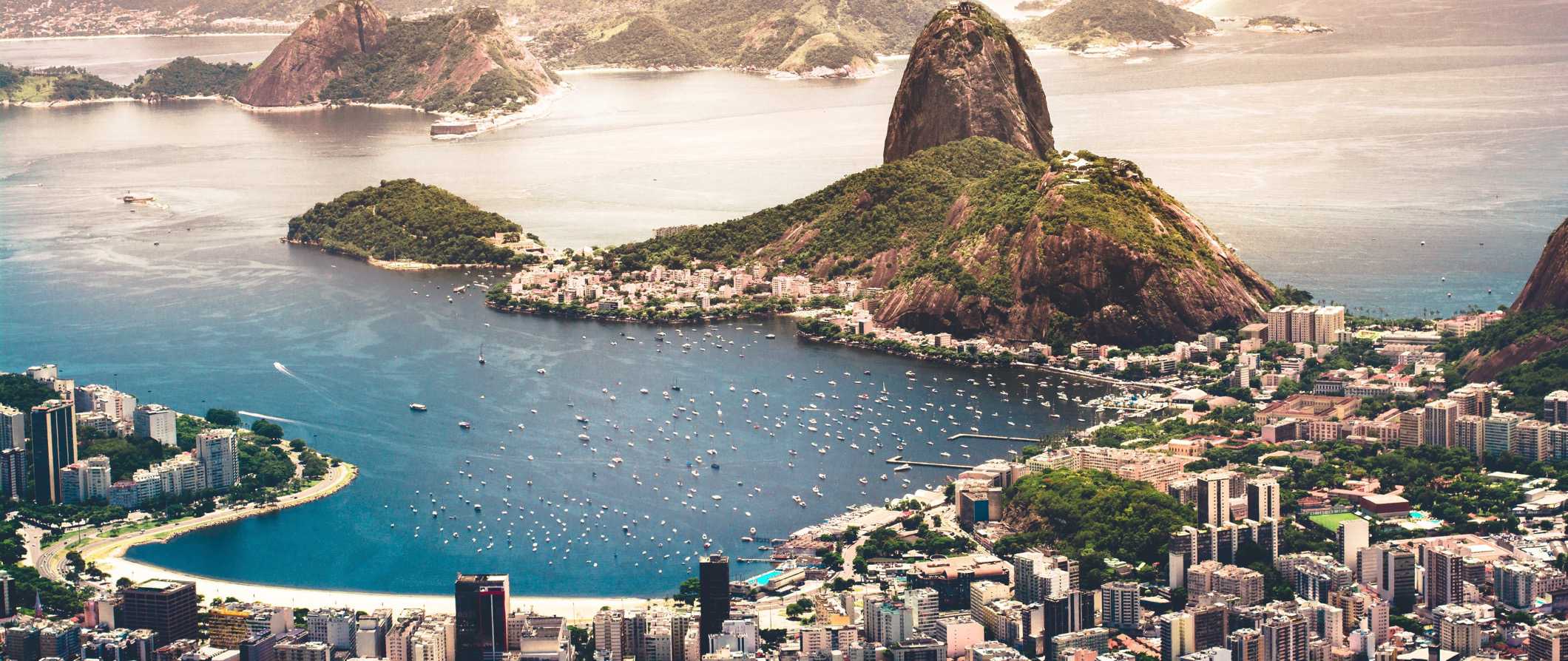
Brazil is impossible to summarize in just a few paragraphs. It’s the largest country in South America and home to cosmopolitan cities like Rio de Janeiro and its Wonder of the World Christ the Redeemer statue, the rambunctious and world-famous Carnival, the Amazon River and rainforest, and an abundance of lush and untamed nature.
Brazil has more plant and animal species than anywhere else in the world, making it a paradise for travelers who love the outdoors. It’s also home to the towering and awe-inspiring Iguazú Falls.
In other words, you’re going to need longer than a week to visit this massive, diverse country.
Meet the locals at Copacabana Beach in Rio or spend an evening learning how to dance the samba. Cruise the wetlands of the Pantanal or the Amazon River while keeping an eye out for exotic wildlife like toucans and pink dolphins. Gorge on a barbecue feast, and cool off with caipirinha , Brazil’s official cocktail of sugarcane liquor, sugar, and lime.
Throw in passionate fútbol (soccer) matches, beautiful people, and low prices, and it’s easy to see why Brazil is one of the most popular destinations in the world.
This travel guide to Brazil will help you plan your trip, save money, stay safe, and make the most of your time in this amazing country.
Table of Contents
- Things to See and Do
- Typical Costs
- Suggested Budget
- Money-Saving Tips
- Where to Stay
- How to Get Around
- How to Stay Safe
- Best Places to Book Your Trip
- Related Blogs on Brazil
Click Here for City Guides
Top 5 things to see and do in brazil.
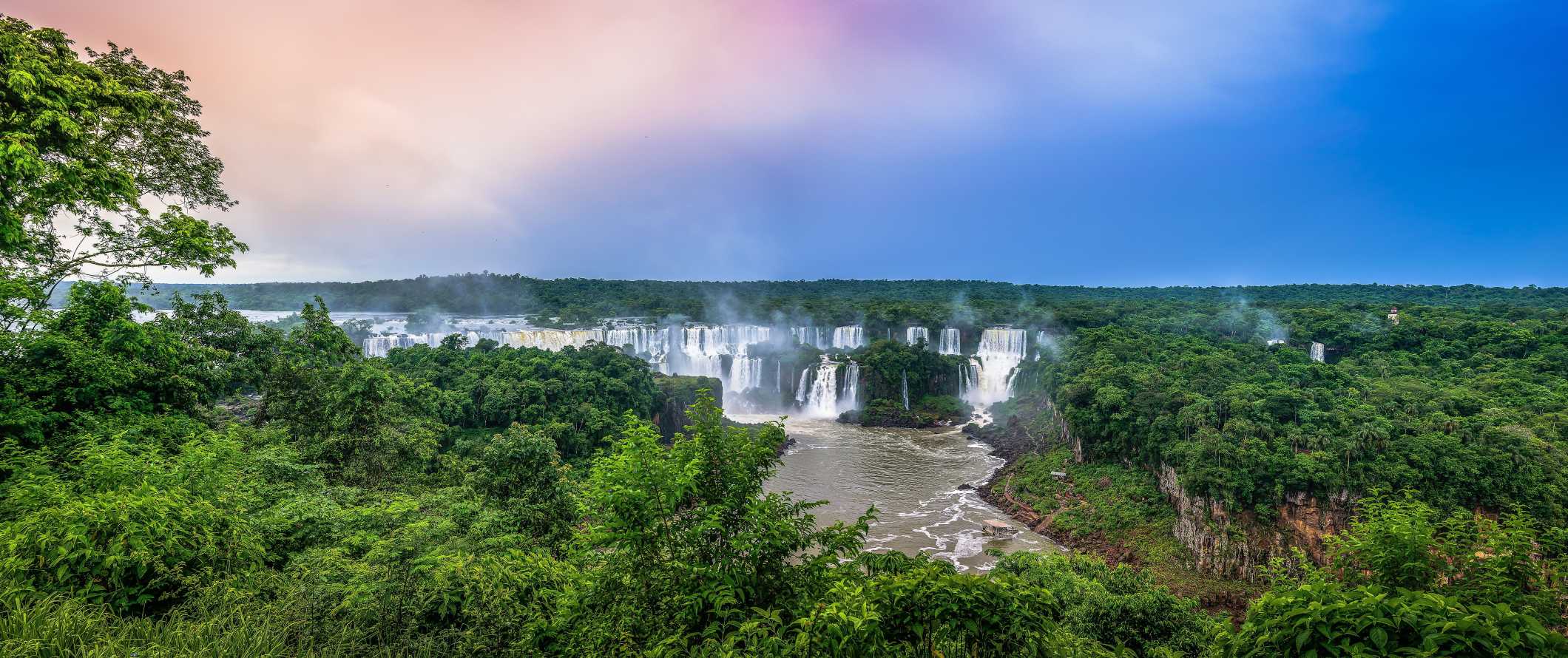
1. Visit Rio de Janeiro
Home to over 12 million people, Rio de Janeiro has dozens of museums, the world-famous sandy beaches of Copacabana and Ipanema, countless party spots, the towering Christ the Redeemer statue (a New Wonder of the World), Sugarloaf Mountain, Tijuca National Park (the largest urban rainforest in the world) right in the city’s backyard, and so much more. No visit to Brazil is complete without a stop here. It’s fun personified, especially if you come during Carnival!
2. Visit Florianópolis
Florianópolis is one of Brazil’s most popular coastal cities, (especially for surfers taking advantage of big waves). Brazilians love to vacation here, and it’s a big spot for backpackers too, thanks to its powdery beaches, cheap seafood, fantastic hiking, and awesome nightlife. Come here to party, lounge, hike, and enjoy the sunshine!
3. Spend time in the Amazon
The Amazon covers 8% of the earth’s surface and is home to 50% of its biodiversity. There are so many ways to experience it: take a jungle cruise down the Amazon River, do a guided multi-day trek , or join a wildlife tour. You can also visit indigenous communities and learn how they live in such a unique place.
4. Go to Fernando de Noronha
Fernando de Noronha was Brazil’s first national marine park and a UNESCO World Heritage Site. The sandy beaches with turquoise waters and excellent snorkeling (there are lots of dolphins here) will take your breath away. 70% of the island is protected, and less than 500 people are permitted at a time, meaning the island is largely empty. It’s one of the most gorgeous places in South America, though be prepared to pay for it in higher accommodation and food costs, as well as a daily visitor tax (87 BRL per day, plus a 330 BRL 10-day visitor pass).
5. See Iguazú Falls
Other things to see and do in brazil, 1. attend a fútbol match in rio.
Fútbol (soccer) is a religion here, and the chaos and excitement during a match are contagious! Maracanã in Rio de Janeiro is one of the largest stadiums in the world, and it seats 100,000 supporters. The best games are the local teams (Flamengo, Vasco, Botafogo, and Fluminese) because you’re guaranteed a game full of singing, cheering, and insult-slinging. You can buy tickets through the teams’ websites or the FutebolCard site. Tickets can be as low as 20 BRL. To learn even more about the sport and stadium, you can take a stadium tour for 77 BRL.
2. Enjoy Rio Carnival
The Rio Carnival is an epic festival of music, samba, and revelers dressed in elaborate, colorful regalia as they take to the streets by the thousands. It’s one of the biggest celebrations in the world (2 million people hit the streets every day during Carnival). The entire celebration is one last hurrah before the start of Lent’s quiet period. Prices for accommodations triple during Carnival (held every February) so be sure to book far in advance for the best deals. You can reserve your 2024 Carnival tickets in advance here (highly recommended – they sell out quickly)!
3. Visit Brasilia
Brasilia is the often-overlooked capital of Brazil. This futuristic city was established in 1960 and is a hub for modernist architecture, including the National Congress, with its odd bowl-shaped structures, and Santuário Dom Bosco church which boasts long, narrow windows made of blue-colored Murano glass that represents a starry sky. Visit the 60,000-acre Parque Nacional de Brasilia and walk the trails between tall Cerrado trees while looking for wildlife like anteaters and pampas deer.
4. Explore the Pantanal
Located in Western Brazil, the Pantanal is the largest wetland in the world, stretching into parts of Bolivia and Paraguay. Over 11,000 species of animal live here, including the rare marsh deer, the giant anteater, and the hyacinth macaw. The two main access points are Cuiabá and Campo Grande. I recommend the latter as it tends to offer more affordable accommodations and tour options. Most wildlife and sightseeing tours are multi-day and cost a minimum of about 1,325 BRL per day.
5. Relax in Recife
Located on the eastern tip of the country, Recife is the place to be if you want to relax and enjoy some of Brazil’s scenic beaches. Boa Viagem, the 7-kilometer (4-mile) stretch of sand between Pina to Piedade, is very developed with cabanas and sun chairs for rent. Piedade is equally as beautiful but less touristy, lined with restaurants and bars where the locals hang out. For an even more low-key beach area, head south to Porto de Galinhas, where the beach is virtually empty.
6. Visit Salvador
Salvador was Brazil’s first capital city, and today it remains the country’s cultural capital, thanks to its vibrant Afro-Brazilian community. Located down the coast from Recife, Nosso Senhor do Bonfim is a perfect example of this community’s unique spirit: it’s a church that peacefully combines Catholicism and Candomblé (a religion originating from West Africa). Furthermore, the pastel-painted colonial buildings and cobblestone scenes of the Pelourinho neighborhood are extremely photogenic, and if you stay in this area, you’ll have easy access to shopping, restaurants, bars, and live music. Local tour operator Your Tour Brazil offers many different tours to help you dig deeper into Salvador’s culture, including their African Heritage & Acarajé Tasting tour .
7. See São Paulo
São Paulo, the fourth-largest city in the world and the largest in South America, is home to over 23 million people. This sprawling metropolis is for anyone who loves wild nightlife, great museums, interesting street art, live samba music, and fine dining. Every area is like its own micro-city and it’s a completely different vibe than Rio (taking a walking tour is one of the best way to get a handle on this gigantic city). São Paulo also has a flourishing art community, which you can discover through its many experimental theaters and art-house cinemas (including CineSala, an independent street theater founded in 1959).
8. Try capoeira
Capoeira is a combination of dance, music, and martial arts created nearly 500 years ago by enslaved West Africans to disguise their combat training. It kind of looks like breakdancing, emphasizing flow over specific stances. In Brazil’s larger cities you can sign up for intro classes, including in Rio de Janeiro, where classes start from 70 BRL. Angola N’Golo is an affordable school to check out.
9. Unplug in Ilha Grande
You’d never know from the look of it that the tropical island paradise of Ilha Grande was once a pirate’s hideout, a leper colony, and a high-security prison. Nowadays people (especially locals from nearby Rio) come here on the weekends to hang out on the pristine beaches, like Aventura Beach and Palmas Cove. There are a handful of hostels and accommodations here, but mostly the island is made up of undeveloped jungles and beaches. Come here to lounge, disconnect, and chill out.
10. Visit Ouro Preto
Ouro Preto, a 17th-century colonial town, is one of Brazil’s most picturesque towns for its brightly painted houses, Baroque churches, and large leafy plazas. Located around 400 kilometers (250 miles) north of Rio, Ouro Preto sits in a valley at the foot of the Serra do Espinhaco, and up in the hills surrounding the town are 23 churches you can hike to visit.
11. Learn samba
Samba is a musical genre and dance born in Rio de Janeiro’s Afro-Brazilian communities in the early 20th century. Today, it’s an important Brazilian cultural symbol, but Rio remains one of the best places in Brazil to learn how to dance. Rio Samba Dancer is my favorite for its all-levels group classes, especially for the classes combined with social outings to samba clubs. Classes start from about 105 BRL.
12. Admire the Azorean fishing villages
Brazil has 7,400 kilometers (4,500 miles) of coastline with many historic fishing villages to explore. Florianópolis has a number of particularly beautiful ones, including Santo Antonio de Lisboa and Ribeirão da Ilha, where you can indulge in delectable oyster and seafood dishes and enjoy secluded beaches, cobbled streets, and jellybean-colored houses. Sights in Ribeirão da Ilha include the Acoriano Casario Church and museum Ecomuseu do Ribeirão da Ilha, where you can learn more about the natural and Azorean cultural history of the area. Museum admission is 5 BRL.
13. Hike in Tijuca National Park
Tijuca National Park is the largest urban rainforest in the world, stretching across 8,300 acres. The area is home to over 350 different species of mammals, birds, and reptiles, including howler monkeys, which only came back to the park recently after a 100-year hiatus. The Corcovado (Christo) hike through Parque Lage to the top of Corcovado is a steep climb, but it’s shaded and only takes about three hours. Another scenic hike is to Tijuca Peak, starting in Rio’s North Zone and going past waterfalls and through dense rainforest. This hike only takes about two hours, and you’ll be rewarded with views over Niteroi and Guanabara Bay. Entrance to the park is free. This is a place where it’s really worth it to go with a tour though. You’ll not only have a more in-depth experience, learning history of the rainforest as well as how to recognize native flora and fauna, but get round-trip transportation to/from your accommodation as well. There are tons of tours available, from the popular jeep tours to full-day adventure hikes that go to lesser visited sections of the rainforest.
14. Visit Paraty
This incredibly well-preserved Portuguese colonial town and UNESCO World Heritige site is located almost halfway between São Paulo and Rio, making it an excellent place to stop and unwind for a few days as you travel between Brazil’s two largest cities. The picturesque cobblestone-lined streets of the 16th-century town are lined with handicraft shops, bars with live music every night, and great restaurants (go to family-run Vinicius for a superb homecooked meal). Located on Brazil’s Costa Verde (Green Coast), there’s a lot of adventure activities to be had here too, including jungle tours of the Atlantic Forest (usually with stops to visit historic cachaca distilleries, as the area is famous for brewing Brazil’s most popular spirit), and boat tours with snorkeling and beach stops. You’ll be able to see and enjoy all the main things to do in about three days here.
For more information on specific cities in Brazil, check out these guides:
- Fernando de Noronha Travel Guide
- Florianópolis Travel Guide
- Sao Paulo Travel Guide
- Rio de Janeiro Travel Guide
Brazil Travel Costs

Accommodation – Brazil is a huge country (it’s the 7th-largest in the world) and accommodation prices fluctuate from city to city and from season to season (with huge increases during Carnival). Prices in places like Rio de Janeiro and Salvador are pretty consistent, but for beachy destinations like Florianópolis, prices change dramatically depending on the time of year.
A 4-6 person dorm costs about 75-85 BRL per night, while a bed in a 8-10 person dorm costs 60-70 BRL. More remote places like Fernando de Noronha have higher prices, with dorms costing up to 150 BRL per night.
A private double room in a hostel costs about 225-300 BRL, but sometimes you can find rooms for as low as 150 BRL per night.
A budget two-star hotel room in the center of town costs 200-300 BRL per night with air-conditioning and breakfast included. If you’re willing to leave the city center, you can sometimes find rooms for as low as 150 BRL per night.
Airbnb is another great budget option, with private rooms averaging around 100-150 BRL per night, while entire apartments or homes start around 275 BRL.
Campgrounds are plentiful by the beaches and national parks. Expect to pay around 40-70 BRL per night for a basic plot. Amenities generally include free Wi-Fi, bathroom facilities including hot showers, and charging stations.
Food – Brazilian cuisine — like the country itself — is a mix of many cultures, with European, Amerindian, African, and Japanese influences. As such a large country, food varies per region, with seafood plentiful on the coastlines and Brazilian barbeque dominating in the south. Rice and beans are a staple no matter where you are.
Common vegetables include tubers like cassava and yams, tomatoes, red peppers, okra, and more. Being a subtropical country, there’s a huge variety of fruits, with the most famous being the superfood açaí, though cupuaçu, mango, papaya, guava, orange, passion fruit, and pineapple are all common as well.
Feijoada , Brazil’s national dish, is a meaty bean stew that is traditionally eaten for Wednesday or Saturday lunch. Other popular dishes include moqueca (fish stew), polenta, and vatapá (a stew of bread, shrimp, coconut milk, and peanuts) among countless others.
Some popular street food snacks include pão de queijo (cheese bread rolls), acarajé (black eyed pea and shrimp fritters), coxinha (chicken croquettes), and pastéis (savory fried pies with assorted fillings).
All of this is to say that Brazil has such a variety of food and flavors that you never have to go far to find an affordable meal.
Street food like pastel (a deep-fried pastry with filling) or coxinha costs around 8-10 BRL. An açaí (served pureed and frozen, with toppings you can choose from) from a street stand or takeaway spot is 15-20 BRL. A sandwich and drink at a juice bar should be no more than 35-40 BRL, while a combo meal at a fast-food restaurant (think McDonald’s) is around 30-35 BRL. A meal at a Chinese takeout restaurant costs about the same, at 35 BRL for a dish like fried rice. Burgers cost 25-30 BRL and pizzas are around 50-60 BRL.
Buffets, where you pay by weight, are very common throughout Brazil. You usually pay around 65-80 BRL per kilo.
A meal at an inexpensive restaurant serving typical Brazilian dishes costs about 20-40 BRL, depending on the region and city. A meal with two courses at a casual restaurant starts from 60 BRL, though prices at restaurants along the beach can go much higher, often starting at 80 BRL for a dish.
If you want to splash out, a three-course meal at a mid-range restaurant costs about 150-180 BRL, but you can expect to pay nearly double this price at some places in Rio de Janeiro or São Paulo.
Dishes at higher-end seafood restaurants cost 150-225 BRL and up. At many restaurants in coastal areas, seafood dishes and platters are meant for two (often served with an entire fish) – it’s a huge portion of food that could easily be split between three people.
A domestic beer costs about 10-15 BRL, while a cocktail is 15-25 BRL. Wine is expensive (and not very good) in Brazil, so expect to pay at least 15-20 BRL per glass. A soda or juice is 5-8 BRL, and a cappuccino is 9-11 BRL.
Grocery shopping costs about 100-200 BRL per week for basic staples like fresh veggies, pasta, rice, and some meat or fish.
Backpacking Brazil Suggested Budgets
If you are backpacking Rio de Janeiro, expect to spend about 215 BRL per day. This covers staying in a hostel dorm, eating street food, cooking some of your meals, limiting your drinking, using public transportation to get around, and doing mostly free activities like enjoying the beach and hiking.
On a mid-range budget of about 420 BRL per day, you can stay in a private hostel or Airbnb room, eat out for all your meals at cheap local restaurants, take the occasional taxi to get around, take buses between destinations, enjoy a few drinks, and do more paid activities like surfing or samba lessons.
On a “luxury” budget of about 750 BRL per day or more, you can stay in a hotel, eat out for all your meals, enjoy more drinks, take taxis everywhere, fly between cities, and enjoy all the tours and activities you want. This is just the ground floor for luxury though. The sky is the limit!
If you’re coming during Carnival, expect prices for accommodations and activities to increase significantly (sometimes triple or even quadruple) — especially if you’re booking last minute.
If you’re staying in Fernando de Noronha, budget double the above suggestions.
You can use the chart below to get an idea of how much you need to budget daily, depending on your travel style. Keep in mind these are daily averages – some days you’ll spend more, some days you’ll spend less (you might spend less every day). We just want to give you a general idea of how to make your budget. Prices are in BRL.
Brazil Travel Guide: Money-Saving Tips
Brazil is one of the most expensive countries in South America, but prices depend on where in the country you are and what kind of activities you’re doing. Brazil’s main cities like Rio de Janeiro and Sao Paulo are more expensive than rural areas (unless you’re seeking out less touristy locales, like Fernando do Noronha). Here are some money-saving tips to help you get started:
- Agree on taxi prices – Agree on the price for your journey with the taxi driver before setting off. Many drivers refuse to use their meters and try to rip you off. It’s much better to take a bus most of the time.
- Stay with a local – Couchsurfing connects you with locals who can give you a free place to stay and share their insider tips and advice. It’s the best way to meet locals and save money.
- Visit off-season – December to March is a pretty busy time as people from the Northern hemisphere escape the winter. Try to avoid these dates if you want to keep prices low.
- Skip Carnival – Carnival might be fun, but it’s also super expensive. If you’re on a budget, avoid visiting during Carnival.
- Get an Airpass – If you book your domestic flights in advance, the Airpass can save you money on flights. It’s the cheapest way to fly around the country (more on this below).
- Cook your meals – Eating out here can easily blow your budget so try and stay somewhere with a kitchen so you can do some cooking. It’s not glamorous, but if you live like the locals you’ll save a fortune.
- Pack a water bottle – The tap water here isn’t safe to drink so bring a water bottle with a filter to save money and reduce your single-use plastic usage. My preferred bottle is LifeStraw as it has a built-in filter to ensure your water is always clean and safe.
Where to Stay in Brazil
Hostels are widespread all over Brazil. You’ll also find a ton of B&Bs and cool Airbnbs. Basically, there are a lot of budget options here. My suggested places to stay in Brazil are:
- Joy Hostel (Brasilia)
- Barra Beach Club Oceanfront Hostel (Florianópolis)
- Submarino Hostel (Florianópolis)
- The Search House Beachfront Hostel (Florianópolis)
- Tucano House Summer Hostel (Florianópolis)
- Hostel e Pousada El Shaddai (Iguacu)
- Hostel Bambu (Iguacu)
- Books Hostel (Rio)
- Selina Lapa Rio de Janeiro (Rio)
- Mango Tree Hostel Ipanema (Rio)
- Bamboo Rio Hostel (Rio)
- O de Casa Hostel Bar (São Paulo)
- Hostel Galeria 13 (Salvador)
How to Get Around Brazil
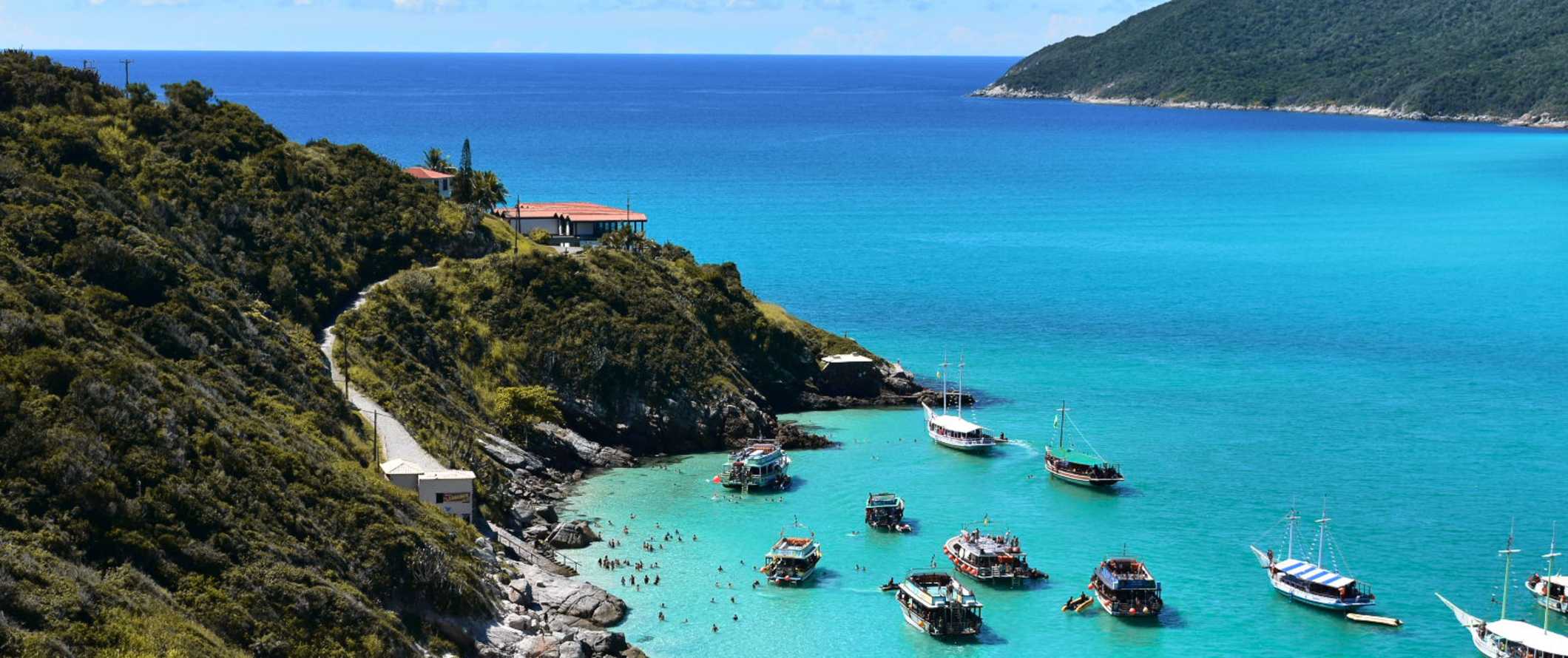
Public transportation – City transportation in Brazil is efficient and modern. Many places (like Rio and São Paulo) have an extensive subway system. Fares cost around 5 BRL per one-way ticket. In most places, you can pick up a multi-day metro card to save money.
Buses are everywhere. A one-way ticket costs about 3-5 BRL, and as with the subway, there are usually multi-day metro cards available.
Taxis – Taxis are recommended in the evening when public transportation may not be as safe. Fares start at 6-8 BRL and then go up to about 3-6 BRL per kilometer. Use an app like 99 (formerly 99Taxis) to ensure you get a licensed taxi. Ridesharing like Uber is also available and common here.
Bus – Long-distance buses are a convenient, economical, and comfortable way to travel in the country. There are hundreds of routes. You can use Brazil Bus Travel to check schedules and book your tickets.
A bus from Rio to São Paulo takes 6.5 hours and costs about 180 BRL, or you can book a sleeper bus with a bed for 420 BRL. Rio to Florianópolis is a 20-hour journey that costs about 520 BRL for a regular seat or 1,050 for a bed.
To find bus routes and prices, use BusBud .
Train – Train service is limited to the tourist-oriented steam train that offers transport in between São Joao del Rei and Tiradentes. It’s expensive, so I don’t recommend doing this.
Flying – Air travel is useful if you’re trying to get around the country on limited time (especially if you’re traveling between the big cities, or between places like Rio and the Amazon). The country’s major airlines are:
If you’re booking a flight two months in advance from Rio de Janeiro to Manaus (the easiest way to reach the Amazon), you can find airfare for as low as 1,700 BRL (round-trip). Rio to Salvador is about 360 BRL (one-way), while flights between Brasilia and São Paulo can be as little as 155 BRL (one-way).
An Airpass is a practical option if you’re going to take a lot of flights within 30 days (especially if you’re going to the Amazon, which is far and expensive to get to). With GOL you can get a 90-day pass with four domestic flights in its network for 2,600 BRL. Azul offers something similar with four flights within three weeks for the same price. Brol.com can help you find the right pass.
Just keep in mind that you have to book in advance for these passes so this doesn’t allow for flexible travel. You also cannot use these passes during popular time periods, like during Carnival and Christmas/the New Year.
Car rental – Car rentals cost around 65-90 BRL per day for a multi-day rental. However, the road conditions aren’t great here and drivers are aggressive. Moreover, since break-ins and carjackings are common, I’d likely skip the rental here just to be safe.
When to Go to Brazil
Brazil covers such a large territory that the country is broken up into different climate areas. The “coldest” part is in the far south and southeast, with the winter season lasting from June to September. Brazilians will complain about the cold here, but it rarely dips below freezing. The summer months from December to March are hot.
If you’re sticking to Brazil’s coastal areas, the weather is warm year-round. During the winter (December to March), the temperature is always higher than 25°C (77°F). There’s near-constant sunshine, but there is also a rainy season, which lasts from October-January. The rainy season often starts earlier in Salvador and Recife.
The northeast (around the Amazon) is always hot, with temperatures often climbing to 40°C (104°F). There’s no real winter season. In Manaus and the central Amazon, the dry season is from July-October. This period is also the best time to visit wildlife in the Amazon as the water recedes and animals gather at watering holes. The same goes for the Pantanal.
If you come during the Brazilian winter, you’ll find much fewer crowds and lower prices. I consider this the best time to be here, but only if you’re not trying to escape the North American winter.
If you’re super budget-minded, don’t come during February when it’s Carnival and prices skyrocket!
How to Stay Safe in Brazil
Travelers need to be vigilant in Brazil . Pick-pocketing and other petty crimes are common here, especially in Rio. Don’t flash expensive belongings and always keep your phone and wallet secure and out of reach. Don’t bring anything valuable to the beach either. Be sure to lock up your valuables before leaving your accommodation, whether you’re staying in a hostel dorm or in a private hotel/Airbnb room.
Avoid going out alone in the evenings after dark. If you do need to travel at night to get back to your accommodation, take a taxi (use the 99 app to call one) or an Uber.
Solo female travelers will want to exercise caution here. Avoid walking around alone when possible and definitely avoid walking around at night. Always keep an eye on your drink (even when it’s being poured) and never accept drinks from strangers.
Use ATMs inside a bank or have a friend with you to keep an eye out while you withdraw cash.
To learn which scams to be on the lookout for, read about this post about common travel scams .
Carjacking and break-ins are common, so I’d probably avoid renting here just to be safe.
When hiking, always bring a lot of water and sunscreen. Be sure to check the weather before you depart and dress accordingly. Don’t pick fruit off a tree and eat it without knowing what it is (it might be poisonous). There is also a risk of the Zika virus and/or Malaria in certain areas. Carry bug spray and use it often.
Always trust your gut instinct. Make copies of your personal documents, including your passport and ID. Forward your itinerary along to loved ones so they’ll know where you are.
If you experience an emergency, dial 190 for assistance.
For more in-depth coverage of how to stay safe in Brazil, check out this post that answers some frequently asked questions and concerns.
The most important piece of advice I can offer is to purchase good travel insurance. Travel insurance will protect you against illness, injury, theft, and cancellations. It’s comprehensive protection in case anything goes wrong. I never go on a trip without it as I’ve had to use it many times in the past.
Brazil Travel Guide: The Best Booking Resources
These are my favorite companies to use when I travel. They consistently have the best deals, offer world-class customer service and great value, and overall, are better than their competitors. They are the companies I use the most and are always the starting point in my search for travel deals.
- Skyscanner – Skyscanner is my favorite flight search engine. They search small websites and budget airlines that larger search sites tend to miss. They are hands down the number one place to start.
- Hostelworld – This is the best hostel accommodation site out there with the largest inventory, best search interface, and widest availability.
- Booking.com – The best all around booking site that constantly provides the cheapest and lowest rates. They have the widest selection of budget accommodation. In all my tests, they’ve always had the cheapest rates out of all the booking websites.
- Get Your Guide – Get Your Guide is a huge online marketplace for tours and excursions. They have tons of tour options available in cities all around the world, including everything from cooking classes, walking tours, street art lessons, and more!
- SafetyWing – Safety Wing offers convenient and affordable plans tailored to digital nomads and long-term travelers. They have cheap monthly plans, great customer service, and an easy-to-use claims process that makes it perfect for those on the road.
- LifeStraw – My go-to company for reusable water bottles with built-in filters so you can ensure your drinking water is always clean and safe.
- Unbound Merino – They make lightweight, durable, easy-to-clean travel clothing.
- Top Travel Credit Cards – Points are the best way to cut down travel expenses. Here’s my favorite point earning credit cards so you can get free travel!
Brazil Travel Guide: Related Articles
Want more info? Check out all the articles I’ve written on backpacking/traveling Brazil and continue planning your trip:
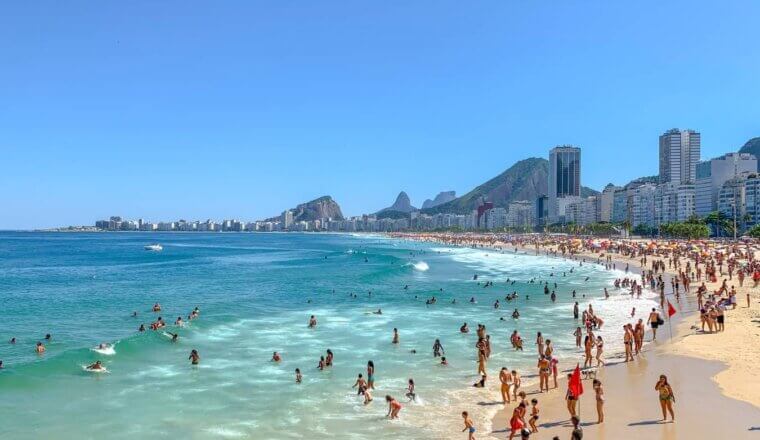
The 6 Best Hostels in Rio de Janeiro
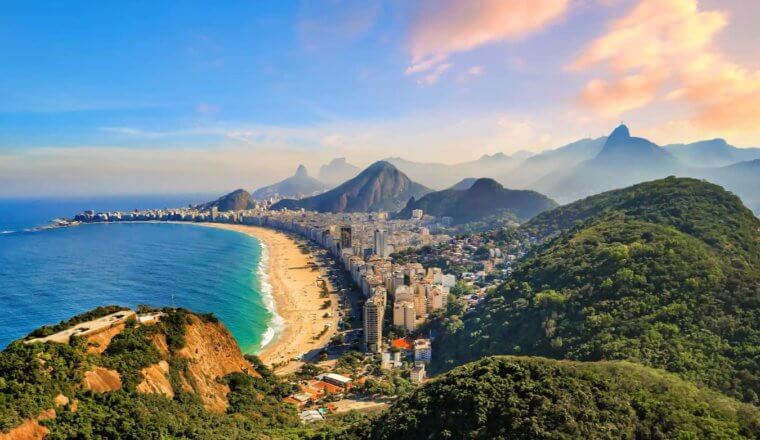
Is Brazil Safe to Visit?
Get your free travel starter kit.
Enter your email and get planning cheatsheets including a step by step checklist, packing list, tips cheat sheet, and more so you can plan like a pro!

- Where To Stay
- Transportation
- Booking Resources
- Related Blogs
- Travel Guides Plan your adventure
- Destinations Our favourite places
- Tours Book a trip
- Travel Companies Independent specialists
- Travel Guides
- Destinations
- Travel Companies
- South America
Samba rhythms and wild landscapes
James Lowen
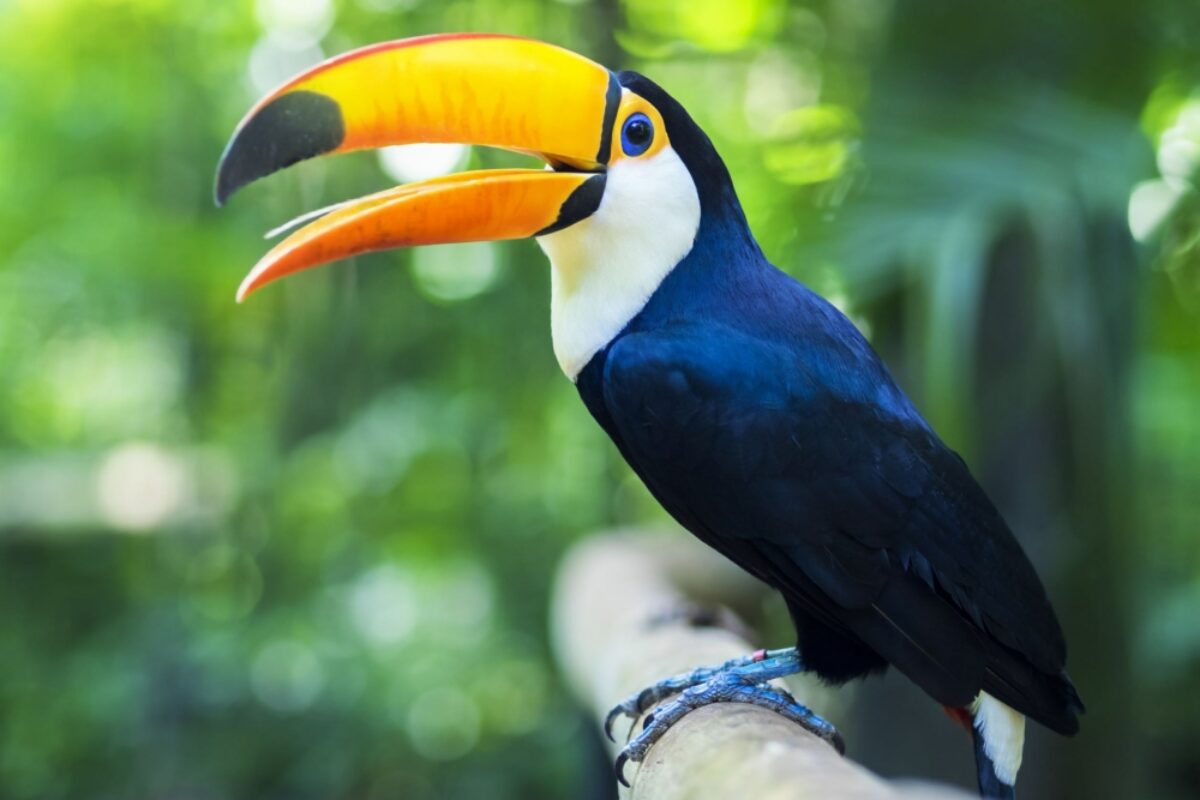
- Itineraries
Home of the Amazon rainforest, samba and O Joga Bonito (the beautiful game – football), Brazil is one of the world’s most fascinating places, with travel experiences to match any adventurer’s needs.
Such is Brazil’s vastness (it covers half of South America and its people make up half the population of the continent), that it’s hard to pinpoint what makes it so special. There are powdery white-sand beaches, thundering waterfalls at Iguacu and a biodiversity of creatures that borders on the ridiculous. Nearly four million species call Brazil home, from toucans to howler monkeys, pink dolphins to sea turtles.
Underpinning this natural beauty is the awe-inspiring Amazon river and rainforest. Home to more than 390 billion trees and covering more than 8 million sq/km, the Amazon Basin contains more than 60% of the world’s remaining rainforests, with half of this lying in Brazil. Visitors to the Amazon region can encounter some of Brazil’s most remote communities, as well as learning about the problems facing the region – between 2017 and 2018, an area five times the size of London was lost to deforestation.
Finally, there are Brazil’s cities: rhythmic Rio de Janeiro, sprawled between ocean and mountain; charming Old Town Salvador; and enormous Sao Paulo, a centre of business and culture to name but a few. In each, you’ll find that legendary, laidback Brazilian sense of fun. So pull up a chair at the bar, order a caipirinha and dive into Brazil – this is a country that has everything.
Wildlife in the Pantanal
A guide to wildlife watching in the pantanal.
Move over Amazon, the watery world of the Pantanal is hands-down the best place for wildlife watching in all of South America. The aquatic environment nurtures a bewildering range of plant and animal species. Visitors stand a fine chance of watching the world’s largest parrot (hyacinth macaw), the largest rodent (the pig-sized capybara), the longest snake (green anaconda) and greatest gathering of crocodilians (yacaré caiman), as well as the New World’s biggest cat (jaguar) and South America’s heaviest land mammal (South American tapir)... read more
Brazil Travel Guides
Available as a free 79 page pdf, south america by bus, highlights and recommended routes.

Rio To Lençóis Maranhenses And Beyond
Nine day beach, lagoon and lake itinerary.

Amazon and Pantanal itinerary
10 day itinerary to brazil's natural wonders.
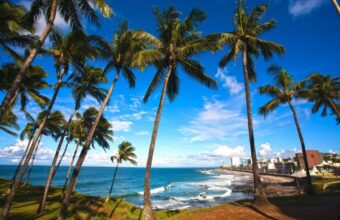
Afro-Brazilian Bahia and Rio
The best of bahia with rio stopover.
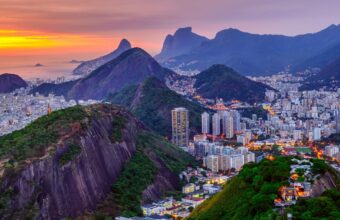
Big city Brazil
Explore the bright lights of cosmopolitan brazil.
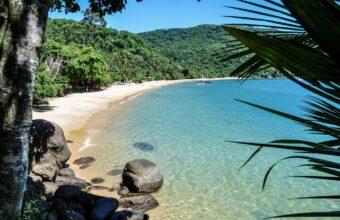
Rio de Janeiro, Beaches & Island Hopping
10-day itinerary to rio and its nearby islands & beaches.
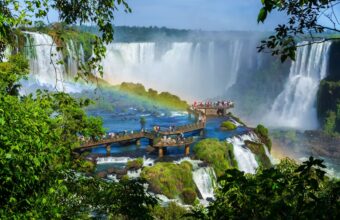
Iguazu Falls and Bahia beaches
Natural wonders and beautiful beaches.

The Brazilian Amazon and Iguazu
Wildlife and waterfalls in brazil.
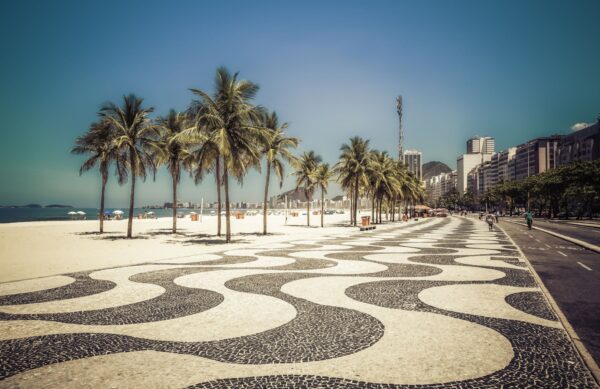
Rio de Janeiro
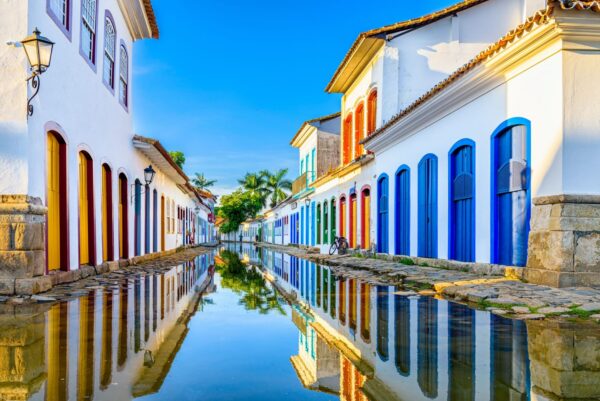
São Luís de Maranhão

Brazilian Amazon
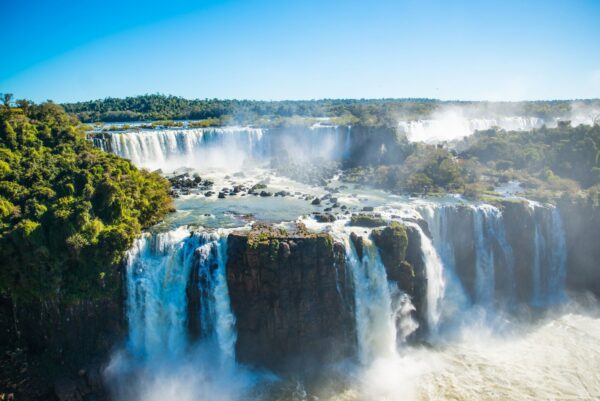
Iguassu Falls
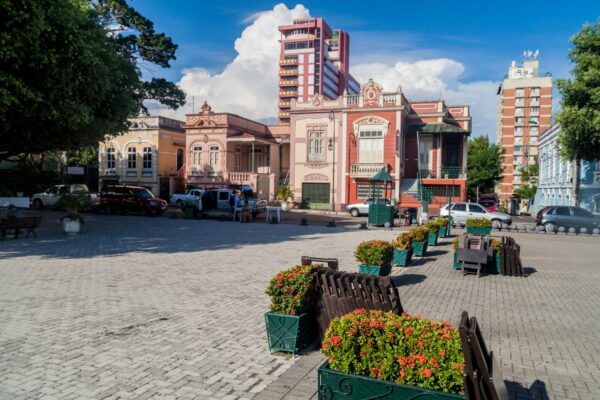
Lençóis Maranhenses National Park

Jericoacoara
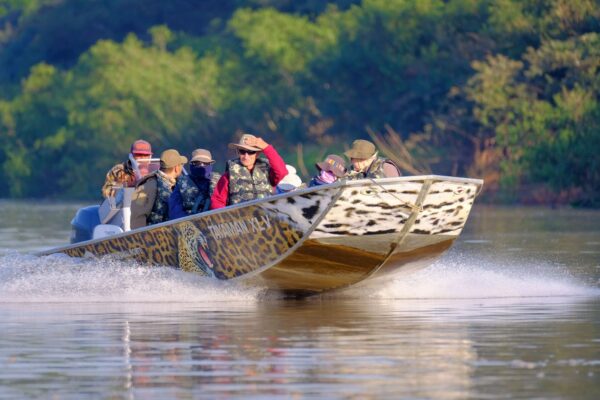
Barra Grande
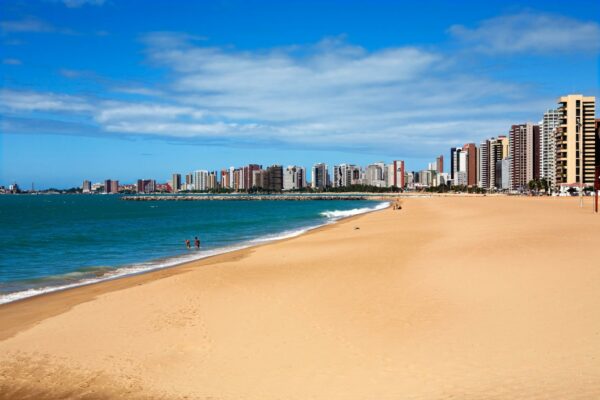
Ilha de Boipeba
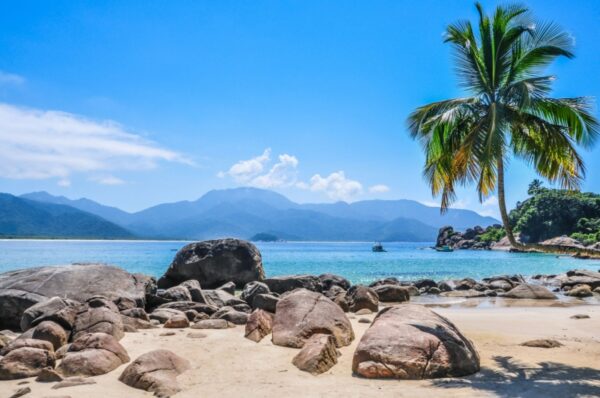
Ilha Grande
Places to go in brazil.

Brazil Tours

Rio de Janeiro, Iguazu Falls, and the Pantanal
Brazil's culture, natural attractions, and wildlife.
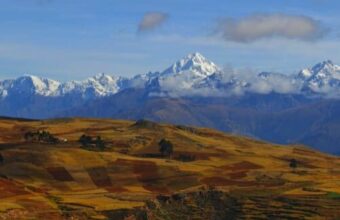
South America Explorer from Peru
Journey across south america from lima to rio.

Best of Brazil
The highlights of brazil in one trip.

Classic Brazil & Northern Argentina
All the best of brazil & the argentinian winelands.
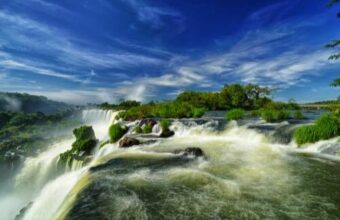
Best of Argentina & Brazil
See the highlights of both in one trip.
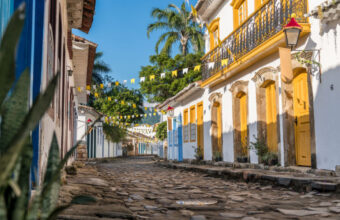
Explore Brazil's Green Coast
Brazil travel companies.
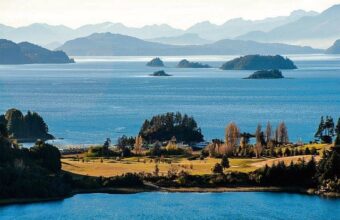
SA Vacations
Personalised travel experiences since 2002.
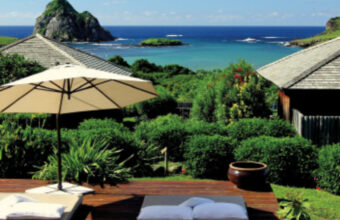
Brazil Green Travel
Luxury travel designed by locals.
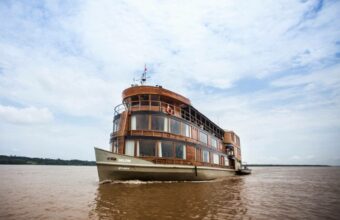
Rainforest Cruises
Exotic riverboat & small ship cruises.

The Latin America Travel Company
Guided tours to latin america, your adventure awaits, speak to an expert about this trip, why horizon guides.

Impartial travel guides
Our guides are written by the leading experts in their destinations. We never take payment for positive coverage so you can count on us for impartial travel advice.


Expert itineraries
Suggested itineraries and routes to help you scratch beneath the surface, avoid the tourist traps, and plan an authentic, responsible and enjoyable journey.

Specialist advice
Get friendly, expert travel advice and custom itineraries from some of the world's best tour operators, with no spam, pressure or commitment to book.
Our guides are 100% impartial and are written by independent, professional travel journalists. We make money by charging carefully-screened travel companies to list their business on our website. Our advertisers have no influence on our editorial content and we never accept payment for positive coverage.
Read more about how we work and what we believe in here .
- Travel guides
- Work with us
Sitemap , Privacy Copyright © 2024 Horizon Guides

18 Top-Rated Tourist Attractions in Brazil
Written by Michael Law , Lana Law , and Barbara Radcliffe Rogers Updated Mar 29, 2024 We may earn a commission from affiliate links ( )
The largest country in South America, Brazil occupies almost half the continent. Nearly all of it is in the Southern Hemisphere, and much of it is tropical, with vast stretches of rainforest filled with exotic plants and wildlife.
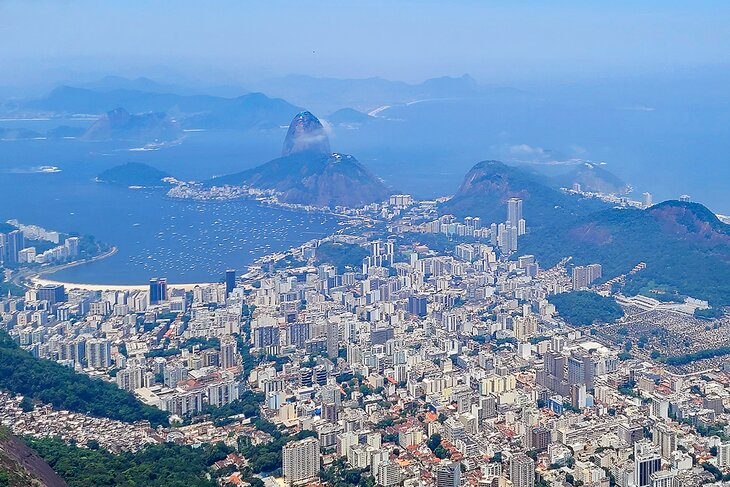
Brazil's 7,400-kilometer Atlantic coast is lined with golden-sand beaches , and its interior is filled with mineral resources. Gold from Brazil's mines still lines the churches of Portugal, the colonial power that ruled Brazil until 1822. This strong Portuguese influence is evident in Brazil's colonial architecture , in decorative arts such as the glazed tiles in its churches and convents, and in the language.
For tourists, Brazil is both a tropical paradise and an exciting cultural destination with attractions for all tastes, from idyllic beach holidays and jungle explorations to world-class art museums and the pulsing rhythms of Rio's Carnival.
To discover the best places to visit and things to do, use this handy list of the top tourist attractions in Brazil.
1. Cristo Redentor and Corcovado, Rio de Janeiro
2. sugar loaf, rio de janeiro, 3. iguaçu falls, 4. copacabana, rio de janeiro, 5. amazon rainforests, 6. carnaval, rio de janeiro, 7. brasília's modernist architecture, 8. jericoacoara, 10. salvador's pelourinho, 11. ouro preto, 12. museu do amanhã (museum of tomorrow), 13. ibirapuera park, são paulo, 14. museu oscar niemeyer, curitiba, 15. botanical garden of curitiba, 16. porto de galinhas & pernambuco beaches, 17. art museums of sao paulo, 18. belo horizonte.
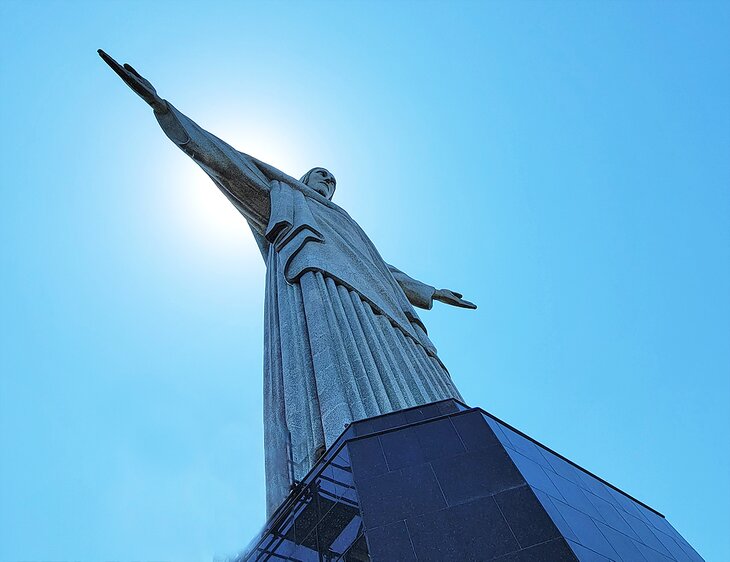
With arms outstretched 28 meters, as if to encompass all of humanity, the colossal Art Deco statue of Christ, called Cristo Redentor (Christ the Redeemer), gazes out over Rio de Janeiro, Sugar Loaf, and the bay from the summit of Corcovado. From here, you have possibly the best view in the city .
The 709-meter height on which it stands is part of the Tijuca National Park, and a railway climbs 3.5 kilometers to the top , where a broad plaza surrounds the statue. Completed in 1931, the 30-meter statue was the work of Polish-French sculptor Paul Landowski and Brazilian engineer Heitor da Silva Costa, and is constructed of reinforced concrete and soapstone.
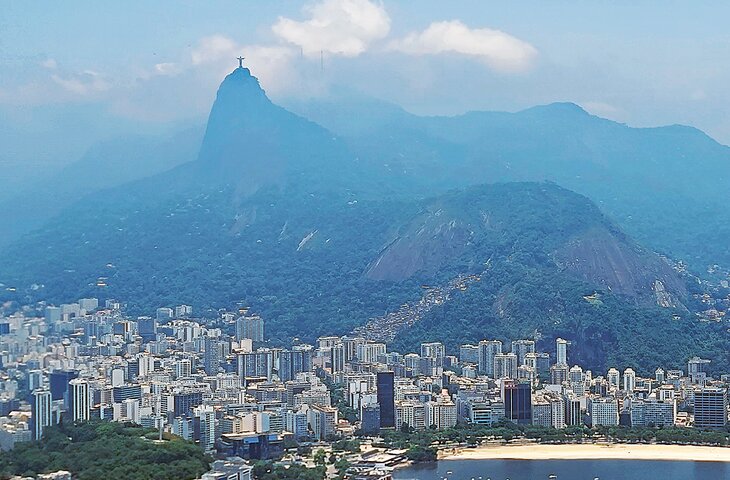
The steep ride up to the statue on the railway is part of the attraction as it passes through a lush forest, home to a wide variety of tropical birds, butterflies, and plants.
- Read More: Top Attractions & Things to Do in Rio de Janeiro
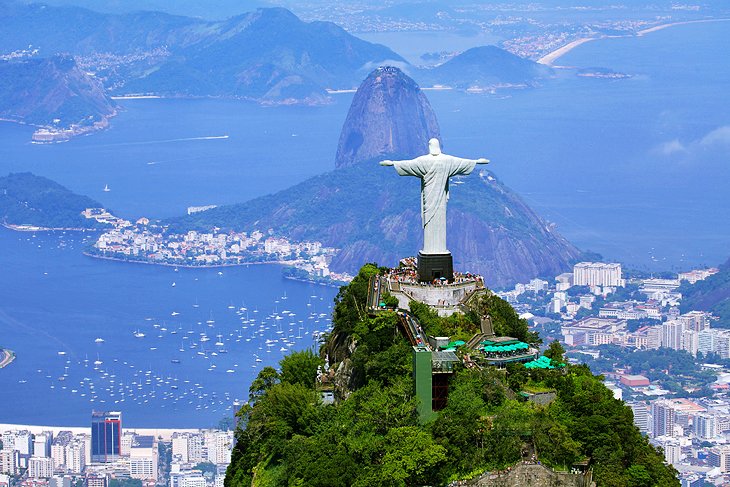
The easily recognized emblem of Rio de Janeiro, the rounded rock peak of Sugar Loaf juts out of a tree-covered promontory, rising 394 meters above the beaches and city. From the summit are outstanding views of Rio and the harbor , as well as a stunning view of Christ the Redeemer. This is an absolute must-do when visiting the city but plan to do this on a clear day and preferably in the morning.
Part of the attraction is the thrill of riding the cable car between Sugar Loaf and the Morro da Urca , a lower peak from which a second cableway connects to the city.
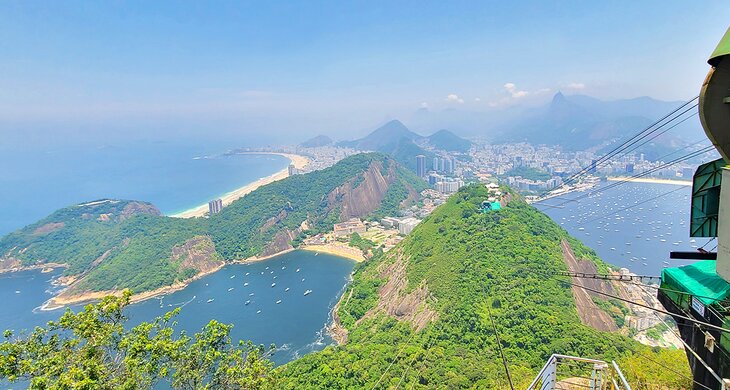
Rio's first settlement began below these peaks, near the long Praia da Urca beach, and you can tour one of the three early forts there, the star-shaped Fort São João .
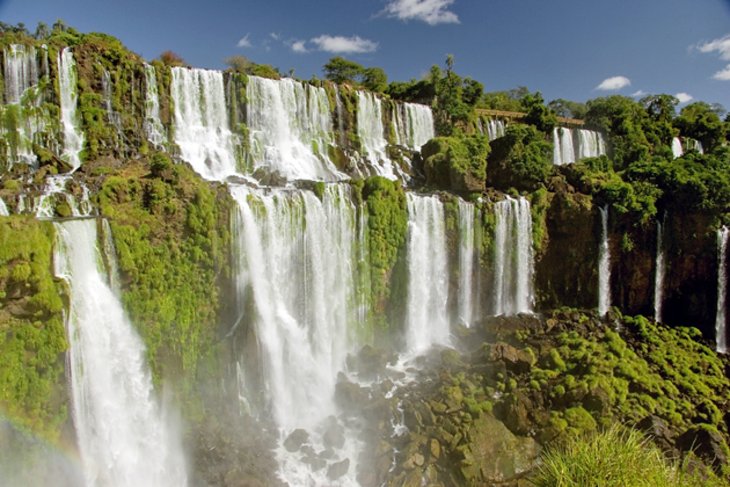
Iguaçu Falls is one of the most spectacular waterfalls in the world. At the point where Brazil, Paraguay, and Argentina meet, the Iguaçu river drops spectacularly in a semicircle of 247 waterfalls that thunder down into the gorge below. Just above the falls, the river is constricted to one-fourth of its usual width, making the force of the water even stronger.
Some of the falls are more than 100 meters high and they cover such a broad area that you'll never see all of them at once, but you do get the broadest panorama from the Brazilian side. Catwalks and a tower give you different perspectives, and one bridge reaches all the way to one of the largest falls, known as the Garganta do Diabo (Devil's Throat).
You can cross to the Argentinian side for closer views from catwalks that extend farther into the center of the falls. The two sides offer different perspectives and views, so most tourists plan to see both.
The falls are protected by the UNESCO-acclaimed Iguaçu National Park , where subtropical rainforests are home to more than 1,000 species of birds and mammals, including deer, otters, ocelots, and capybaras.
In early November 2023, water flows that were ten times normal levels caused significant damage to many of the walkways in and around the falls. The most famous, the Devil's Throat, has reopened but the Garganta del Diablo will be closed for quite some time with no reopening date announced as of writing.
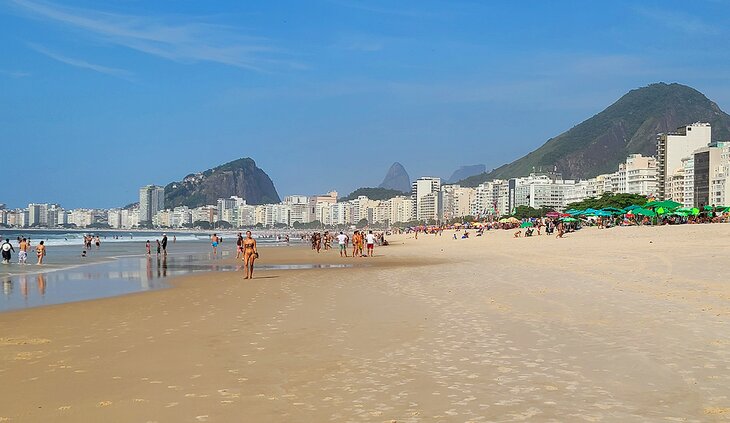
It's hard to think of Rio without conjuring up an image of Copacabana. This is Rio's playground, a popular escape from the heat filled with sun-worshipers, swimmers, and kids building sand castles. A seemingly endless assortment of beach shacks offer chair and umbrella rentals, snacks, drinks, and even free showers.
Downtown Rio's most famous section follows Avenida Nossa Senhora de Copacabana and is bordered all along one side by four kilometers of white sand and breaking surf .
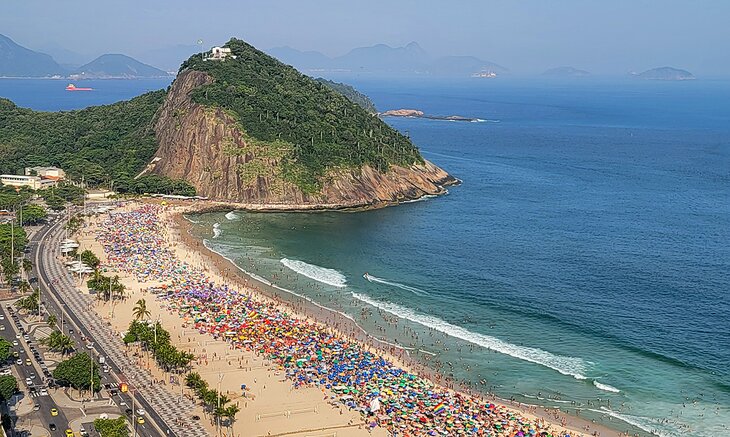
The beach is separated from the buildings and traffic by a broad promenade paved in black and white mosaic in an undulating pattern reminiscent of streets in Lisbon, Portugal. Along this promenade, the famed Copacabana Palace is protected as a national monument. Inside this hotel's lobby, you can easily imagine seeing the royalty and film idols who have stayed here.
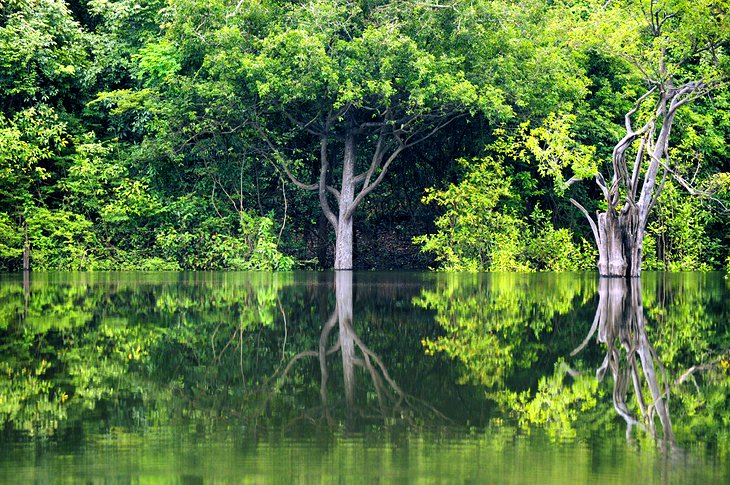
About 20 kilometers southeast of Manaus, the dark Rio Negro waters meet the light muddy water of the Rio Solimões, flowing side by side for about six kilometers before mixing as the Amazon. Boat trips from Manaus take you to this point, called Encontro das Aguas , meeting of the waters.
Other boat trips take you into the heart of the rainforests and the network of rivers, channels, and lakes formed by the three rivers. In the Rio Negro, the Anavilhanas Islands form an archipelago with lakes, streams, and flooded forests that offer a full cross-section of the Amazonian ecosystem.
You can see monkeys, sloths, parrots, toucans, caimans, turtles, and other wildlife on a boat trip here. Also close to Manaus, the 688-hectare Janauari Ecological Park has a number of different ecosystems that you can explore by boat along its narrow waterways.
An entire lake here is covered with giant water-lilies found only in the Amazon region. While in Manaus, be sure to see its famous Teatro Amazonas , the Italian Renaissance-style opera house, designed to put Manaus on the map as South America's great center of culture.
- Read More: Top-Rated Tourist Attractions in Manaus
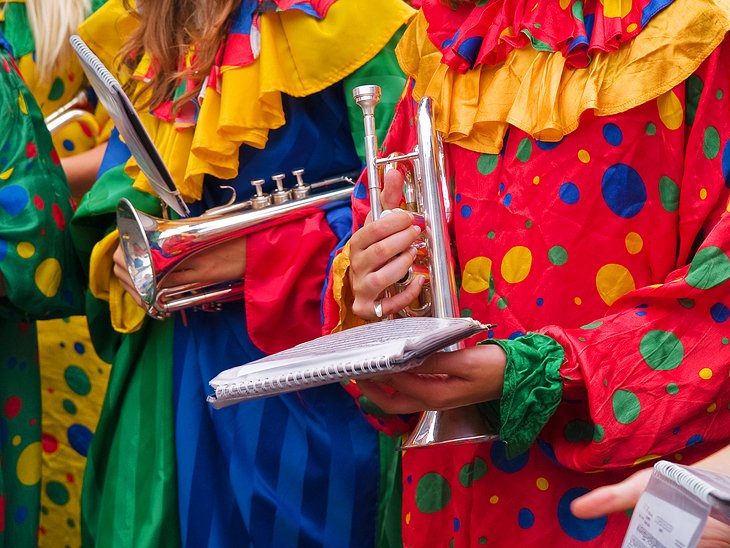
Few shows match Rio's pre-Lenten Carnaval (Carnival) extravaganza for color, sound, action, and exuberance. Make no mistake, this is not just another rowdy street party, but a carefully staged showpiece, where spectators can watch the parades of competing samba dancers from a purpose-built stadium designed by none other than Brazil's best-known architect, Oscar Niemeyer.
Called the Sambódromo , this long series of grandstand boxes provides ringside seats to a 700-meter parade route where dancers and musicians from the competing samba schools strut their stuff in a dazzling explosion of brilliant costumes.
If mob scenes are less appealing to you than more spontaneous celebrations (that are equally riotous and colorful), you'll also find Carnivals in Salvador , Bahia, Recife, and other Brazilian cities.
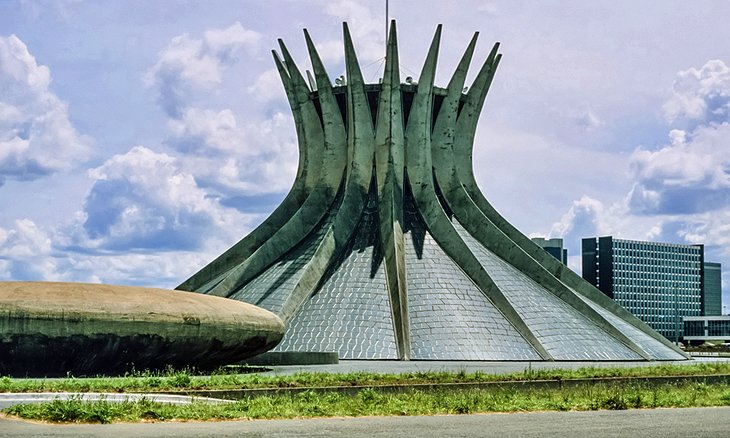
Brazil's new city of Brasília was carved out of the wilderness and completed in less than three years to replace Rio de Janeiro as the country's capital in 1960. The ambitious plan by Lúcio Costa and Oscar Niemeyer became a showpiece of city planning and avant-garde architecture, and it remains today as one of the world's few cities that represent a completed plan and a single architectural concept.
Without the normal mix of residential and business districts, the entire governmental section is composed of major architectural highlights, which are the city's main tourist attractions . Some of the most striking surround Praça dos Tràs Poderes : the presidential palace, supreme court, and the two sharply contrasting congress buildings, plus the Historical Museum of Brasília and the Panteão da Liberdade (Pantheon of Freedom), designed by Oscar Niemeyer.
That architect's best-known building in the city is the circular Catedral Metropolitana Nossa Senhora Aparecida , whose curved concrete columns rise to support a glass roof. Another of Niemeyer's landmark works is the Palácio dos Arcos , surrounded by beautiful gardens designed by Brazilian landscape architect Roberto Burle Marx, who worked with Niemeyer on several projects throughout Brazil.
The round Memorial dos Povos Indígenas (Museum of Indigenous People) is patterned after a traditional Yąnomamö round house. But many consider Niemeyer's finest work to be the Monumento JK , a memorial to President Juscelino Kubitschek, the founder of Brasilia. Brasilia has been named a UNESCO World Heritage city.
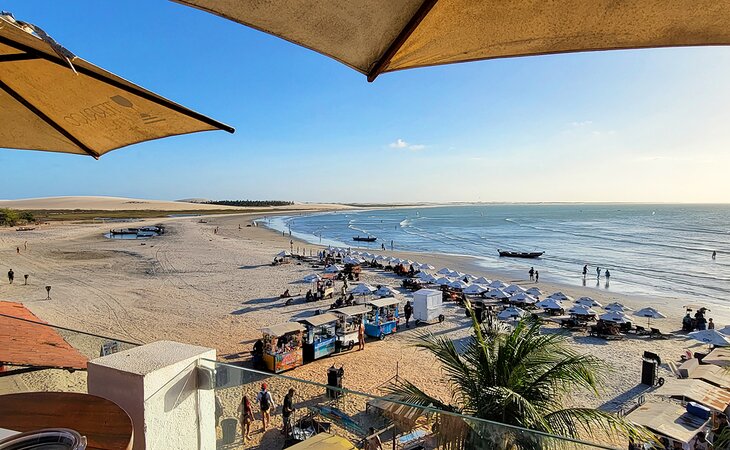
If you've ever dreamed of a beachside village where all the streets are sand and like with good restaurants, decent hotels, and the odd donkey wandering around, Jericoacoara is the place for you. Jeri, as it's commonly referred to is, located within the confines of the spectacular Jericoacoara National Park , access is only through a huge expanse of massive sand dunes in a 4WD vehicle or, for the more adventurous, on the back of a beach buggy.
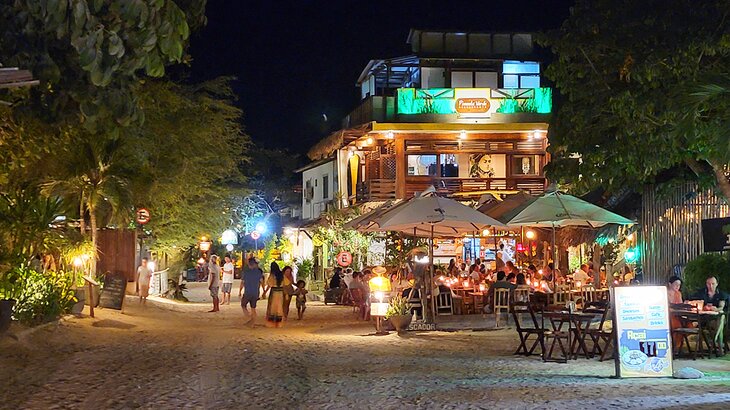
Each night the town comes alive when the mobile vendors set up shop on the sand and the band starts to play. Grab a bite from one of the small BBQ stands and catch the sunset as it sinks into the expanse of the Atlantic Ocean, or even better secure a rooftop patio seat. Later on wander the sandy, pedestrian-only streets and enjoy a dinner with your toes in the sand. After dinner, check out one of the many boutiques featuring a variety of beach and resort clothing.
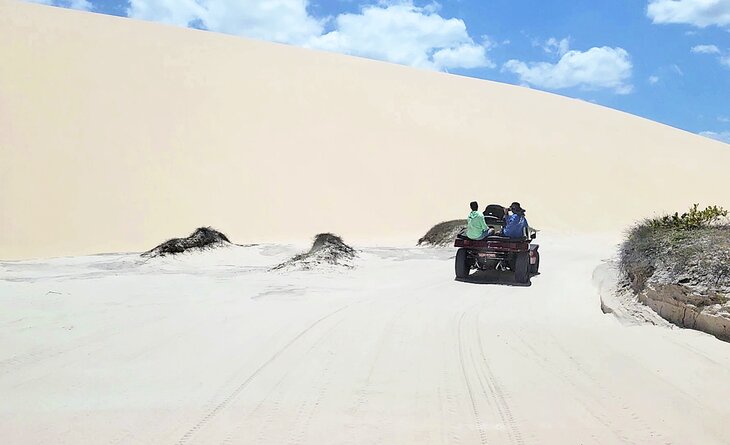
Windswept beaches run for hundreds of miles north and south of Jeri and this draws wind sport enthusiasts from around the world. Jeri is considered by many to be the best place in the world to go kiteboarding and as a result, draws a diverse set of participants from across the globe.
To experience the dunes or explore freshwater lagoons, where you can set up beachside at a restaurant and go for a swim, hire a buggy for the day , and go on an excursion. You can also head down towards Guiru or further along to Tatajuba to see or enjoy more kiteboarding. It's a fun trip that involves a river crossing on a small, flat barge.
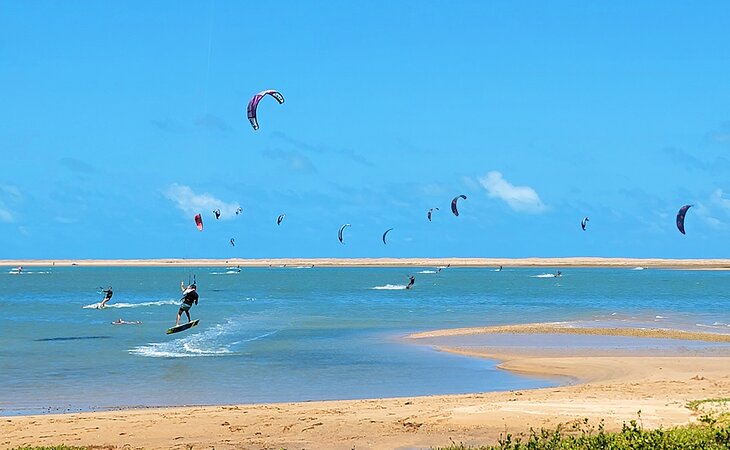
You can fly directly to Jericoacoara . As an alternative, you can fly into Fortaleza and hire a car and driver to run you up the coast, which is about a five-hour drive . The best option is to stop off for a night or two along the way in some of the other beach towns like Cumbuco or Guajiru , both of which are popular kiteboarding areas.
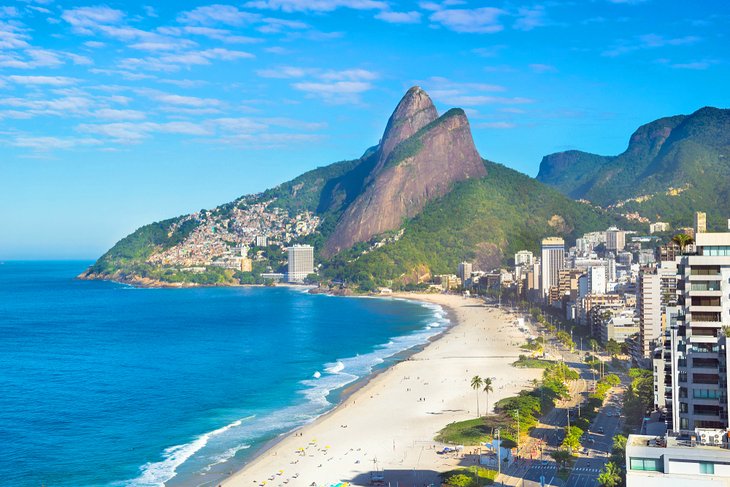
Beyond the beaches of Copacabana, the glorious white sands merge into the just-as-famous beaches of Ipanema. The same wave design of Copacabana's wide promenade continues here, separating the sand from the line of hotels, restaurants, cafés, art galleries, and cinemas that make this a popular social zone year-round.
Farther along, beyond the Jardim de Alá Canal, which drains Lagoa Rodrigo de Freitas lagoon, are the beaches of Leblon . With more locals and fewer tourists, these beaches are favorites for families. Sunday is especially busy, with an antiques market at Praça de Quentaland and the Feira de Artesanato de Ipanema , alive with music, art, handicrafts, and street food.
The waves at Ipanema and Leblon can be very strong and unpredictable, so be careful where you swim. Follow the locals and stay out of the water where you don't see others swimming. If surf is what you're looking for, head to the stretch between Copacabana and Ipanema, where the surfers hang out.
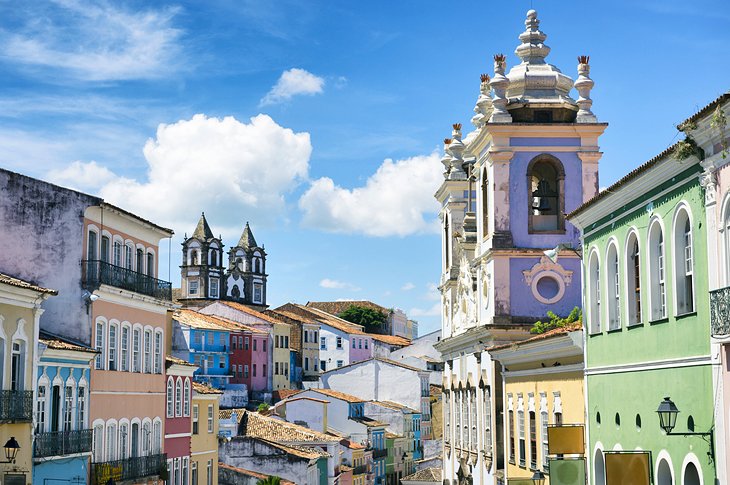
The Cidade Alta (Upper Town) of Brazil's former colonial capital has been named a UNESCO World Heritage site for its exceptional collection of 17th- and 18th-century colonial buildings, the finest such ensemble in South America.
Called the Pelourinho, this old quarter is where you'll find Salvador's most beautiful churches and monasteries, built at a time when Brazil was the source of Portugal's riches, and the plentiful gold was lavished on the colony's religious buildings.
The finest and most opulent of the city's churches is São Francisco , built in the early 1700s and filled with intricate carvings covered in gold. In the choir and cloister, you can see excellent examples of Portuguese tile panels, called azulejos.
This was the friary church, and next to it is the church of the Franciscan Third Order. It's impossible to miss the riotously carved façade covered in statues and intricate decoration. The interior is just as ornate, surpassing even the Portuguese Baroque in its opulent detail.
- Read More: Top-Rated Attractions & Things to Do in Salvador
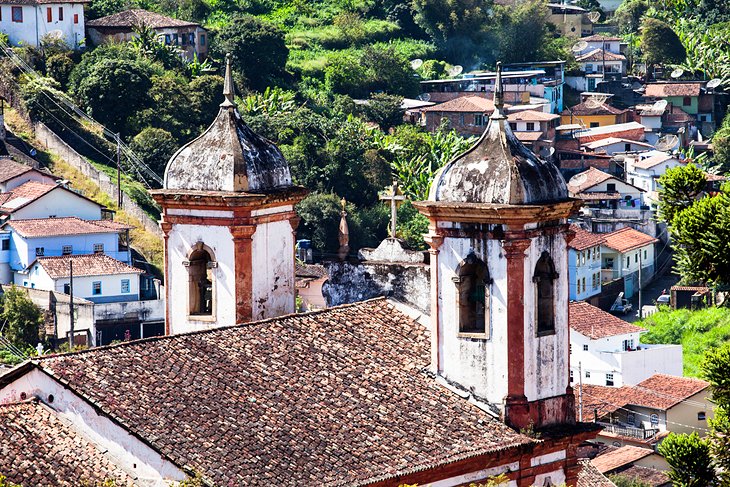
The wealth of Brazil's state of Minas Gerais in its glory days of the colonial period is easy to imagine from the interiors of the churches in its old capital, Ouro Preto. Entire walls are washed in gold that flowed – along with diamonds – from the mines surrounding the city in the 17th and 18th centuries.
Cascading down the sides of a steep valley and surrounded by mountains, Ouro Preto is a jewel of a colonial town, but its steep narrow streets and mountain setting – however captivating for tourists today – didn't meet the needs of a growing provincial capital. The government moved to the newly built capital of Belo Horizonte, leaving Ouro Preto in its time capsule.
The 17th-century Baroque and Rococo churches of São Francisco de Assis and Matriz de Nossa Senhora do Pilar are the best examples, but the entire town is so rich in colonial architecture that Ouro Preto has been named a UNESCO World Heritage Site. The steep streets, so precipitous in places that they become stairways, are lined by gracious colonial mansions, and white churches crown its hills with Baroque bell towers.
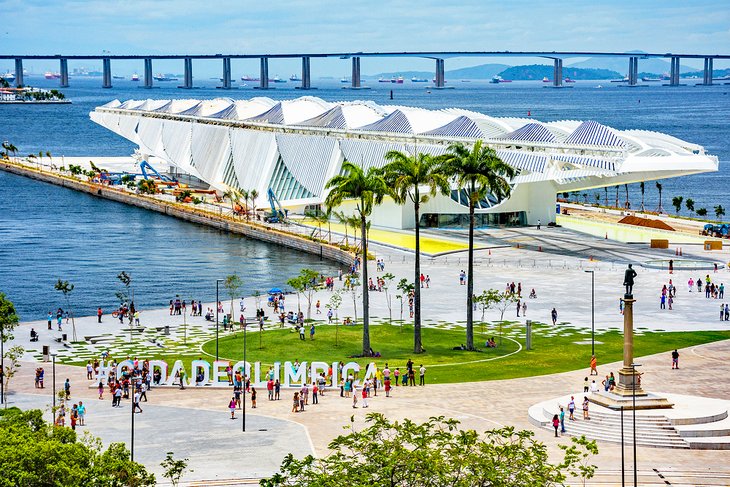
The futuristic architecture of the Museum of Tomorrow in Rio de Janeiro gives a clue about its contents. Thought-provoking exhibits invite visitors to think about what the world might be like in the future, exploring scenarios of how our planet may change in the next half-century.
Examining these times of fast-moving changes in society, technology, and the physical world, the museum prompts viewers to consider various paths into the future, and how each opens up based on the choices made every day as individuals and as a society.
This eye-catching science museum overlooking the waterfront was designed by Spanish architect and artist, Santiago Calatrava.
Address: Praça Mauá 1, Centro, Rio de Janeiro, Brazil
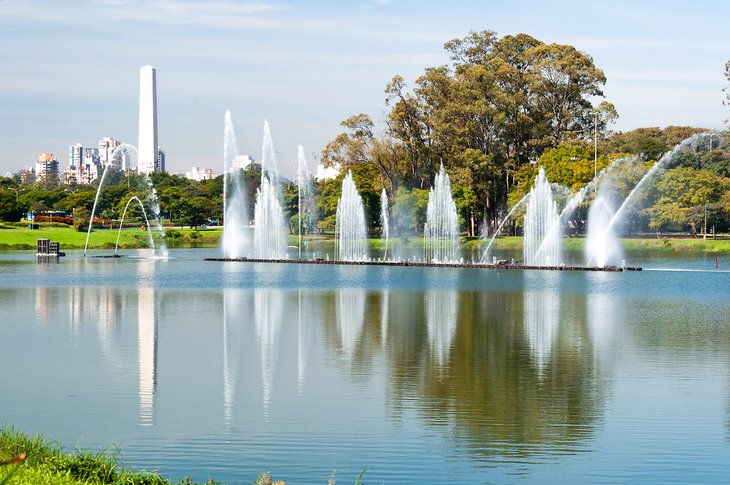
The most visited park in South America, Ibirapuera Park is a vast green space designed by Brazilian landscape architect Roberto Burle Marx, with buildings designed by Oscar Niemeyer. The park is a showcase for modern architecture and a center for Brazilian culture.
Amid its monuments, gardens, playgrounds, trails, and lakes are museums and performance spaces that include Oscar Niemeyer's Auditório Ibirapuera , one of São Paulo's best concert venues. A Japanese Pavilion with sculptures, clothing, and traditional crafts is set in rock gardens with a fishpond.
The Museu da Aeronáutica e do Folclore , the Aeronautics and Folk Art Museum , features thousands of examples of folk arts and exhibits on traditional cultures from across Brazil. The lower floor is devoted to aeronautical equipment and model airplanes. A separate museum, the large Museu Afro-Brasil , features the culture and history of Afro-Brazilians and their contributions.
Address: Avenida Pedro Alvares Cabral, São Paulo
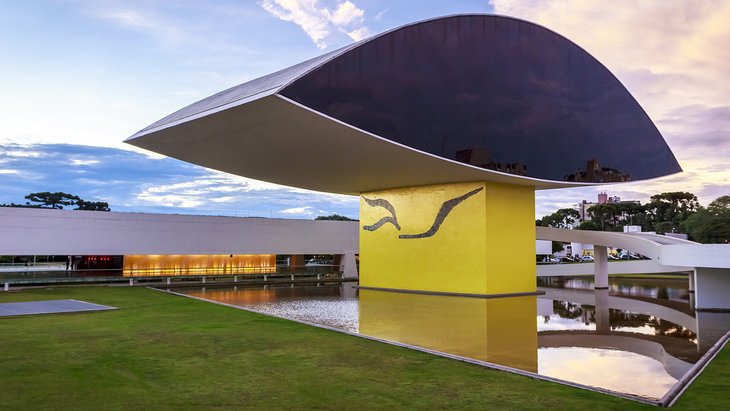
Paving the way for the unconventional building shapes created by later futurist architects such as Frank Gehry and Santiago Calatrava, Oscar Niemeyer left his native Brazil with a treasury of his most iconic buildings. One of these was built as the New Museum, completed in 2002 when Niemeyer was 95 years old, and renamed in tribute to him in 2003.
Balanced on a massive 60-foot pillar, the gallery is formed by a pair of joined arcs that resemble the shape of the human eye, hence its popular name, Museu do Olho – Eye Museum. Access to this raised structure is by a series of curved ramps. Inside the eye, the 2,000-square-foot gallery focuses on architecture, design, and the visual arts, and displays many of Niemeyer's works.
Niemeyer added a later rectangular gallery on the grounds to display changing exhibitions of works by contemporary Brazilian artists. In addition to visiting during its daytime open hours, try to see the Museu Oscar Niemeyer after dark, when it is spectacularly lighted.
Address: Rua Marechal Hermes 999, Curitiba
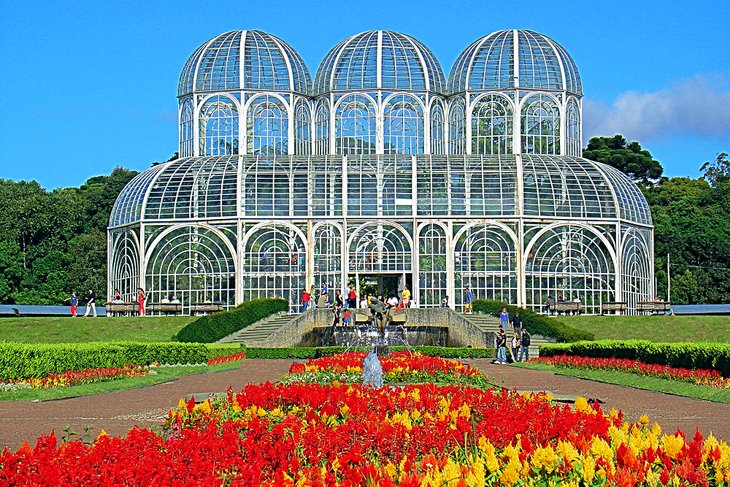
Reflecting the style of 17 th - and 18 th -century French palace gardens, Curitiba's Botanical Garden was opened in 1991. Formal beds are outlined by low sculpted hedges, in a geometric design inspired by the city's flag. The landscape is enlivened by fountains, waterfalls, and ponds, and in the park surrounding the gardens are forests of native trees, with walking paths.
The focal point of the botanical gardens is the main greenhouse, an Art Nouveau-style conservatory made of glass and white metal, reminiscent of the Crystal Palace in Victorian London. Its unusual shape includes three domes that merge into the rectangular base. Inside are plants native to the region.
Even the grass in the Garden of Native Plants of Curitiba is a native variety, and its flowers are especially attractive to butterflies and other pollinators. The Garden of the Senses (Jardim das Sensações) is a 200-yard path through a wisteria tunnel, where more than 70 plant species are chosen for their fragrance or tactile appeal. Visitors are invited to try walking through it blindfolded to fully appreciate the garden by using their other senses.
Behind the main greenhouse is the Frans Krajcberg Cultural Space, displaying more than 100 large sculptures created from the remains of trees that were burned or illegally cut, calling public attention to the destruction of Brazil's native forests.
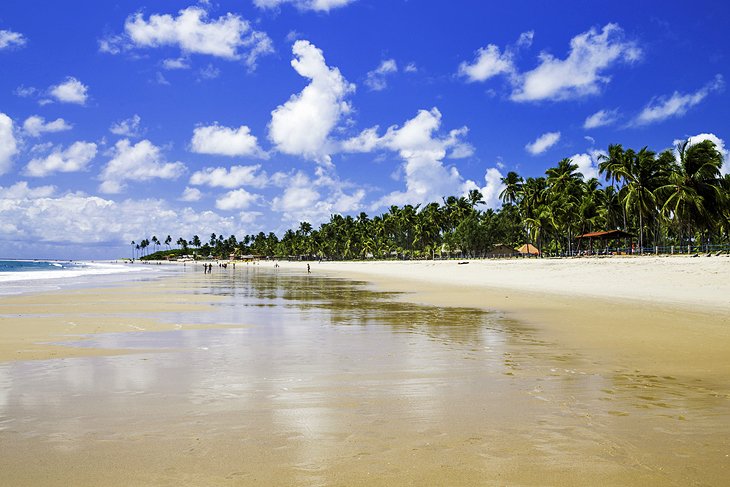
The crystal waters, tall palm trees, and broad stretches of silver sand are only a few of the reasons why Porto de Galinhas is frequently cited as Brazil's best beach. For a country with more than 7,000 kilometers of Atlantic coast, much of it sandy beaches, that's saying a lot.
The town stretching along the beach is laid-back, colorful, and just the right blend of old-fashioned beach town fun and chic boutiques. Its hotels and resorts lie close to the land instead of soaring in high-rise blocks.
Jangadas, picturesque sailboats, will take you out to reef-top pools where brilliant tropical fish swim around your feet in ankle-deep water. You can also take a boat to a lagoon where tiny seahorses swim, and you can scuba dive to explore impressive coral reefs or shipwrecks, kayak in the lagoons and estuary, or buy a fanciful kite from a beach kiosk to fly in the steady breeze. Nearby Maracaipe is popular with surfers.
Porto de Galinhas is just one of the beautiful beaches on Pernambuco's 187-kilometer coast. Closer to Recife, 17th-century Olinda is a UNESCO World Heritage Site overlooking a popular beach. The main beaches in Recife itself are Praia da Boa Viagem, São José da Coroa Grande, and the Carne De Vaca.
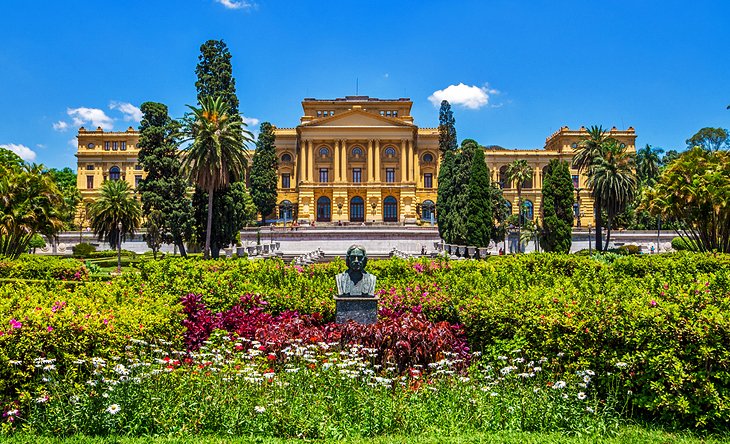
São Paulo holds some of the best collections of fine arts in Latin America, and the buildings in which they are housed are architectural landmarks as well. The Museu de Arte, MASP, displays the continent's most comprehensive collection of western art, with representative works by artists from the Renaissance through modern masters.
There are 73 bronze sculptures by Degas and works by Renoir, Manet, Van Gogh, Matisse, Picasso, and Miró. From its beginning, the museum has concentrated on works of mid- to late-20th-century artists, and the building designed by architect Lina Bo Bardi is a Modernist landmark.
Oscar Niemeyer designed the Pavilhão da Bienal de Artes in Ibirapuera Park , home to the Museu de Arte Contemporânea. More than 8,000 works of art - one of Latin America's largest collections of 20th-century Western artists - includes Picasso, Chagall, Kandinsky, Miró, and Modigliani along with major Brazilian painters.
Set above Versailles-inspired formal gardens, Museu do Ipiranga houses paintings and decorative arts.
For another kind of art, don't miss Batman's Alley , an open-air gallery of street art by local and international artists. It is in the bohemian Vila Madalena neighborhood, where you'll also find art galleries showing the works of well-known and rising Brazilian artists and craftspeople.
- Read More: Top-Rated Attractions & Things to Do in São Paulo
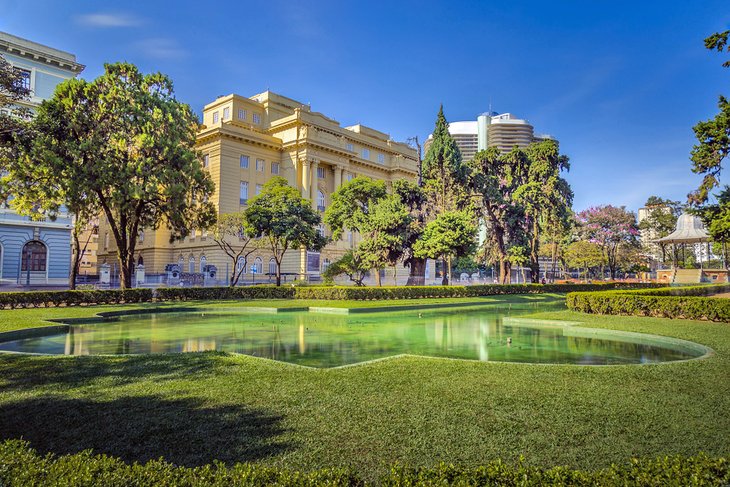
The capital of the state of Minas Gerais gave the pre-eminent Brazilian architect Oscar Niemeyer his first commissions, and today, these early Niemeyer buildings draw tourists and fans of Modernist architecture to the city.
His first major work, which immediately set him apart from conventional architects, was the parabolic-curved São Francisco de Assis church, beside a lake in the Pampulha neighborhood. On the hillside above it, and connected by gardens designed by landscape architect Roberto Burle Marx, is Niemeyer's earlier casino building, now an art museum.
Overlooking the large Praça da Liberdade in the city center is the sinuous apartment building, Edificio Niemeyer , one of his most famous early works. The clean geometric lines of his later Palácio das Artes mark the edge of the Municipal Park, housing the Minas Gerais Craft Center featuring works of contemporary craftsmen.
The postmodern Rainha da Sucata – Queen of Scrap Iron – is another landmark building in Belo Horizonte, this one the work of Éolo Maia and Sylvio Podestá. It now houses the mineralogy museum.
Read More: Top Attractions & Things to Do in Belo Horizonte & Easy Day Trips
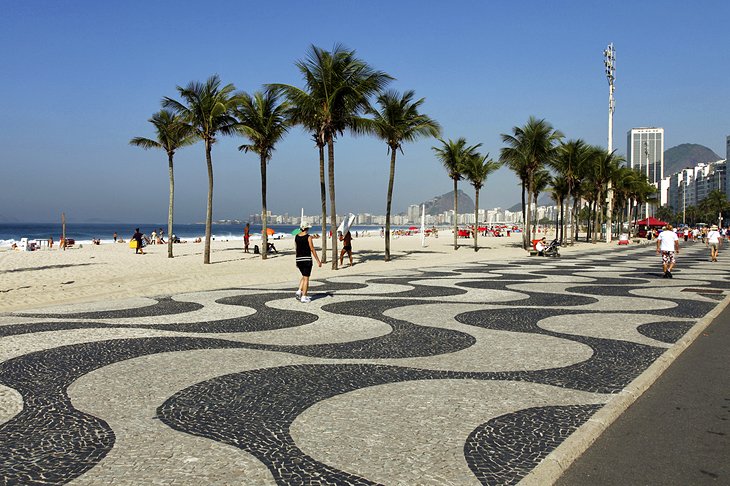
More on Brazil
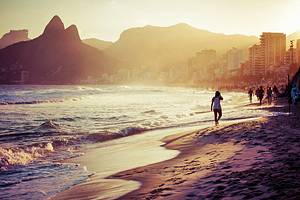
Our local experts can design your trip based on your preferences
Warning - You are using an outdated browser. Please upgrade your browser to properly view this website.

- Destinations
- South america
- Travel guide
Brazil travel guide
Brazil is a giant package with a multitude of gifts, of which the warm waters, white sand and tropical beauty of the stunning coastline are but the beginning of the story.
Read more about the people, culture and history of Brazil...

Places to visit in Brazil
In the north and northeast, colonial monuments dot the state capitals, most of which are beside the sea. Salvador and Recife offer the best combination of beach and history.
The succession of beautiful beaches continues south to the all-time leading beach city of the Americas, Rio de Janeiro . By contrast, São Paulo is the most dynamic city in South America.
The further south you travel, the more European are the influences, culminating in the Southern States , where Italian, German, and Polish settlers have left their mark.
Inland travelers will discover some of the world’s most remarkable natural wonders. Occupying one-third of the nation’s territory is the Amazon rainforest, and below it the Pantanal , a natural wildlife sanctuary.
In the south, the wildly beautiful Iguaçu Falls are considered by many to be the greatest natural attraction of Brazil.
See all of our recommended places in Brazil...
Average customers rating

{{_ "pagesAdmin.destinations.overviewCulturalFeaturesIn"}} {{currentName}}
{{_ "pagesAdmin.destinations.overviewViewAllFeatures"}} {{currentName}}
{{_ "pagesAdmin.destinations.overviewHistoricalHighlights"}} {{currentName}}
{{_ "pagesAdmin.destinations.overviewViewAllHighlights"}} {{currentName}}
- Minas gerais
- Rio de janeiro state
- Rio de janeiro
- So paulo state
- Iguau falls
- Southern states
- The far northeast
- The pantanal
See all places in Brazil
Read more from the travel guide to Brazil
- Top attractions
- Historical highlights
- Cultural features
- Plan your trip
- Top restaurants
- Useful phrases


- Major destinations
- Rio de Janeiro region
- Sao Paulo region
- Iguassu Falls
- Bahia & Salvador
- Fortaleza, Ceará
- Recife region
- Lençois Maranhenses
- Fernando Noronha
- Florianopolis
- Other destinations
- Tours-Packages
- Jan, Feb, Mar, Apr, May, Jun, Jul, Aug, Sep, Oct, Nov, Dec
- Amazon Forest
- Bahia, Salvador
- Rio Janeiro
- Best Time to Visit
- Rain, Temperatures
- Seawater temperatures
- Brazilian Maps List
- Nightlife Fun
- Scuba Diving
- African Culture
- Facts about...
- Health Vaccination
BRAZIL travel guide & TRULY LIFETIME HOLIDAYS
Brazil offers excellent and unique travel features.
Brazil has the world’s largest rainforest and river (the Amazon), the most spectacular waterfalls of the world (Iguassu), the greatest American concentration of wildlife (the Pantanal), the world's longest stretch of tropical beaches and the most popular street festival (the Brazilian Carnival).
Besides, Brazilians have a truly amazing way of facing life, especially in the northeast and in the Rio de Janeiro region. The intensity with which way of facing life and their sympathy is truly remarkable.
TOP BRAZILIAN TRAVEL DESTINATIONS
Amazon and Manaus If you want to enjoy the immense green of the rainforest, with its aquatic environment and wildlife, you should consider Manaus, at the centre of the Amazon basin.
For more information: Amazon tours & Manaus
The Iguassu Falls The world's most spectacular waterfalls are situated along the border between Brazil and Argentina. As Eleanor Roosevelt allegedly said, when confronted with their magnificence: Niagara compared to Iguassu is just like a water drop. Besides, they are bordered by a luxuriant tropical forest, which can be explored by boat, bike or by plane.
For more information: The Iguassu Falls
Tropical year round beaches Many of the most amazing beaches of the world are Brazilian – some are near Rio de Janeiro, but most of them are in the northeastern and north coastline.
For more information: Brazilian beaches Beaches as Rio, with cosmopolitism, night life, animation Tropical beaches as Bahia
The Brazilian Pantanal A rather unknown animal reserve, sized larger than France and with floods every year, the Pantanal is a key travel destination for those who do not fear the mud and adventure in order to watch bird and wild life like nowhere else in America.
For more information: Pantanal
Unique cities Rio de Janeiro has a unique mixture of beach life, music, nightlife and astonishing natural landscape. Salvador da Bahia, with its strong African culture, is another unique city; exoticism, music, dance, cuisine, optimism, companionship and a permanent parade of ceremonies and events in a blend of Catholicism and African religions are Salvador da Bahia's trademark.
For more information: Entertainment, night life, cuisine and shopping in Rio de Janeiro Entertainment, night life, cuisine and shopping in Sao Paulo Entertainment, night life, cuisine and shopping in Bahia
Back to top
Amazon vacations
Traveling into the Brazilian Amazon rain forest is an unique experience. Nobody is immune to feeling small and wonder at the immensity of green and water of the world's biggest rainforest.
Just take into account when to go and where (Manaus would be a good idea) to go.
For more information: Amazon tours: Manaus, Safety, Climate Amazon river cruises and tours
Fun and Nightlife in Brazil
For entertainment and nightlife, Rio de Janeiro is the number one choice.
But Bahia (Salvador), with its exoticism and unique musical traditions, or even Sao Paulo (a big metropolis of over 15 million people, with lots of restaurants, clubs, bars and night clubs and discos), are also places to consider.
For more information, see: Entertainment, night life, cuisine and shopping in Brazil
Best time to go to Brazil
Brazil is a large country with several climate zones. It's usually helpful to consider a two-season pattern for the North and the Northeast coast, or for te Amazon, that is, a rain and dry season.
But that's not the case in Sao Paulo, or further south. Here we should consider a four season weather pattern (though cold weather spells are uncommon, and restricted).
These and other factors, should be considered when visiting Brazil. The most popular times are not necessarily the best time to go. An example: the best time to visit the Amazon Is the the driest months (June to September, in Manaus) though most people visit the Amazon during the hotter and rainiest time: January, February and March.
For more information: Best weather seasons and months: visiting Brazil in in Jan, Feb, Mar, Ap, May, June, July, Aug, Sep, Oct, Nov, Dec Best time to go to Brazil Brazil's Climate and weather
Maps and distances
Maps of Brazil, cities and regions Distances between the main brazilian travel destinations
Partner site: Pandemic Economics
©2013 Brazil-Travel-Guide.com

Photo © Tim Mossholder

World’s greatest biodiversity and cultural melting pot.
Home to the AMAZON FOREST and many other important ecosystems, such as the ATLANTIC FOREST and the Pantanal, BRAZIL is a perfect destination for your green holidays. More than that, Brazil is also ethnically and culturally diverse, which is seen in its architecture, festivals, music, and food. Being the 5th largest country in the world, Brazil differs a lot from north to south, and east to west, so one visit will probably not be enough. Brazil is a place that captures you and makes you feel that there is still so much more to explore!
Not sure where to go?
Explore the options for a responsible trip
GOOD PLACES TO VISIT
Explore destinations that were certified for their sustainability efforts
GOOD BUSINESSES
Discover accommodations, restaurants, shops and activities that are committed to sustainability. their efforts are summarised in a scorecard (click on the picture). for the good travel seal, the higher the level, the more things are checked by an independent auditor..
- Accommodations
- Restaurants
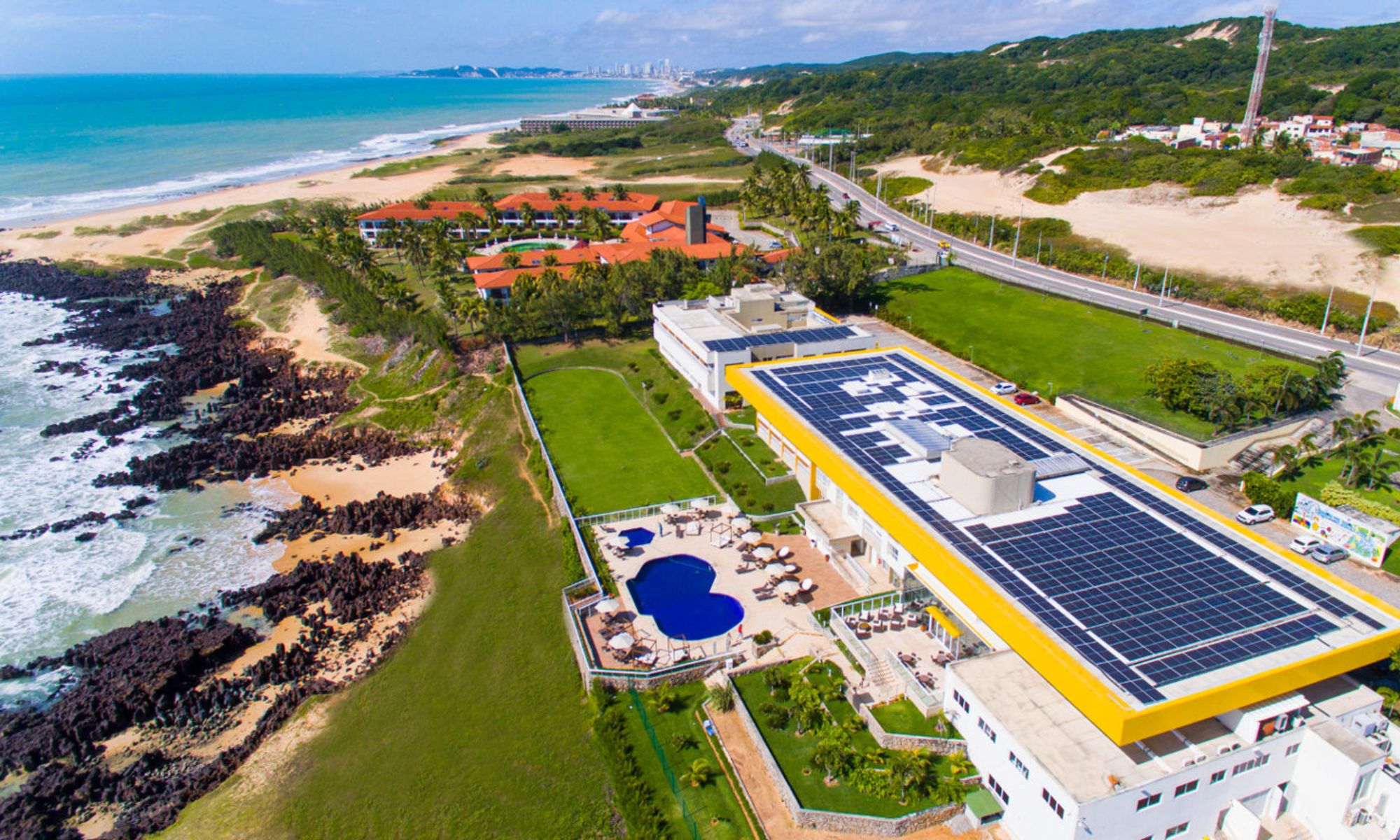
Hotel Senac Barreira Roxa
GTS 3 Star & VAS Certified

Posada Xamã
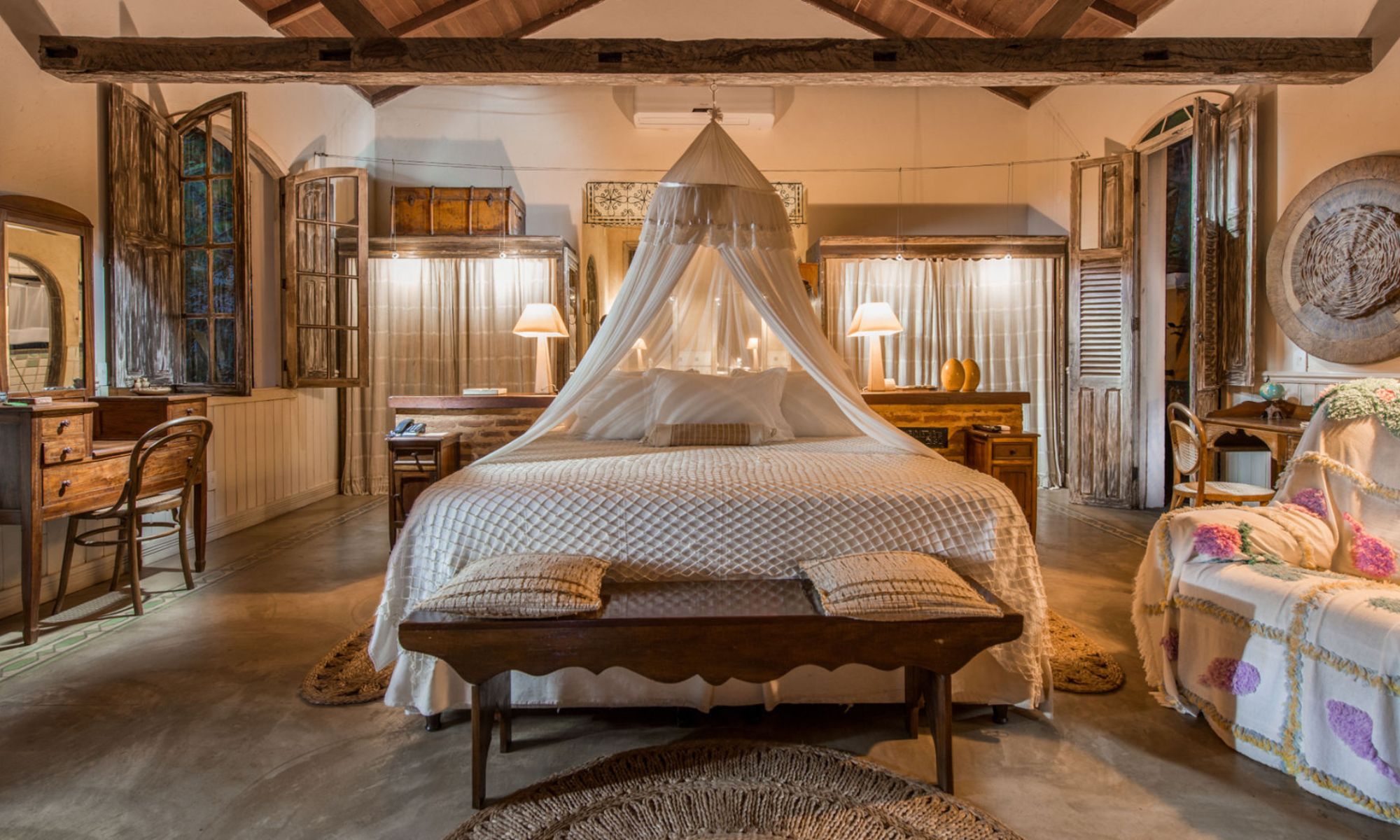
Pousada Toca da Coruja
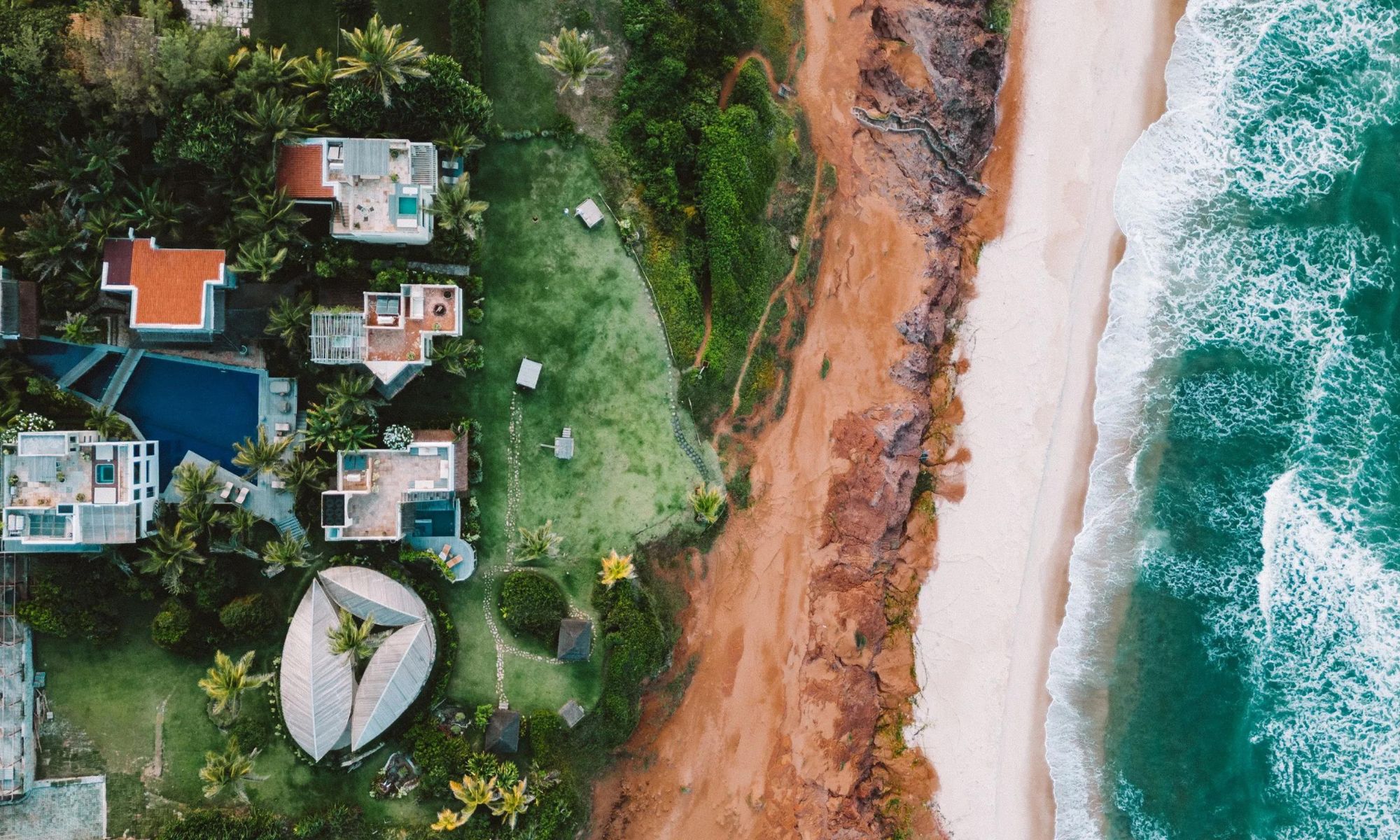
Kilombo Villas
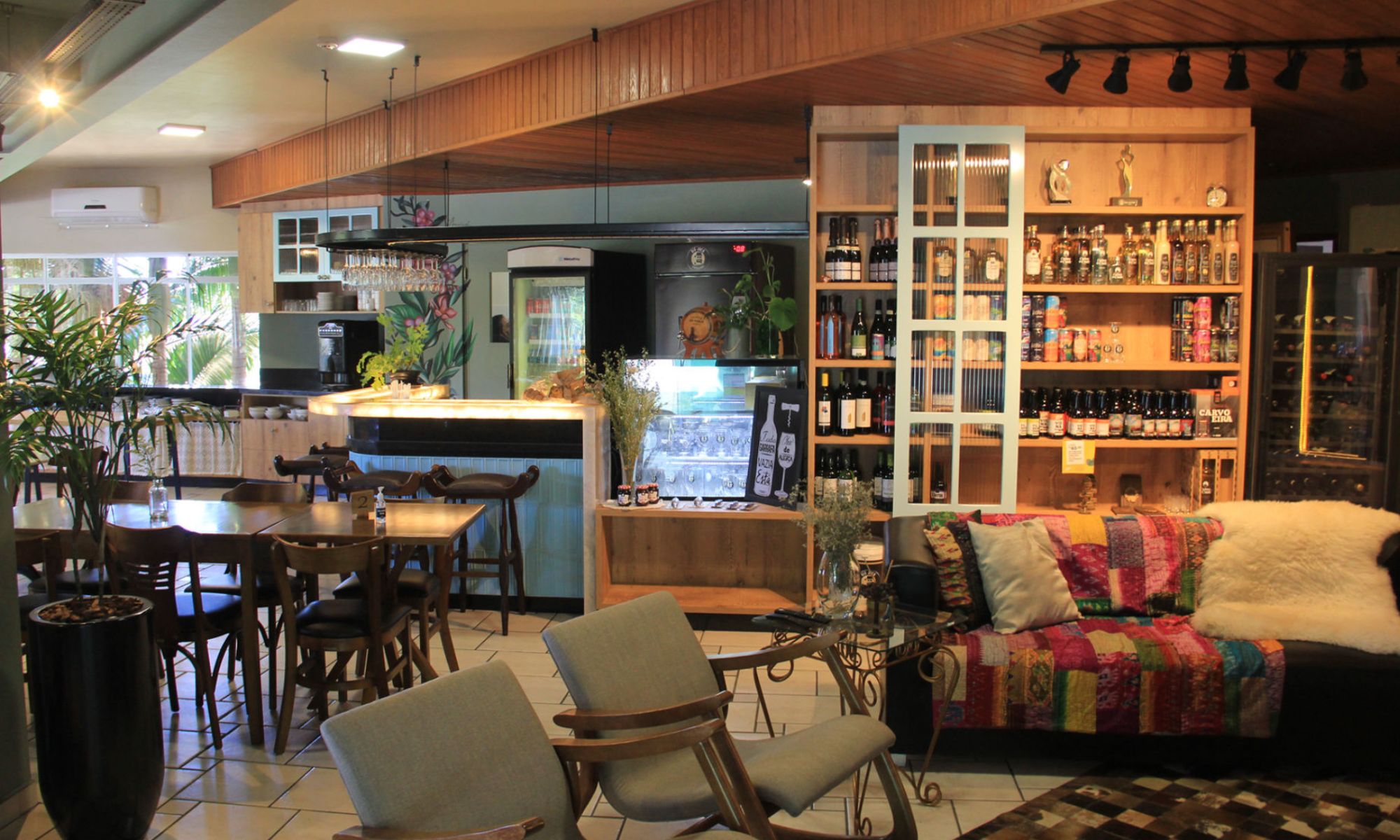
Hotel Real Nob
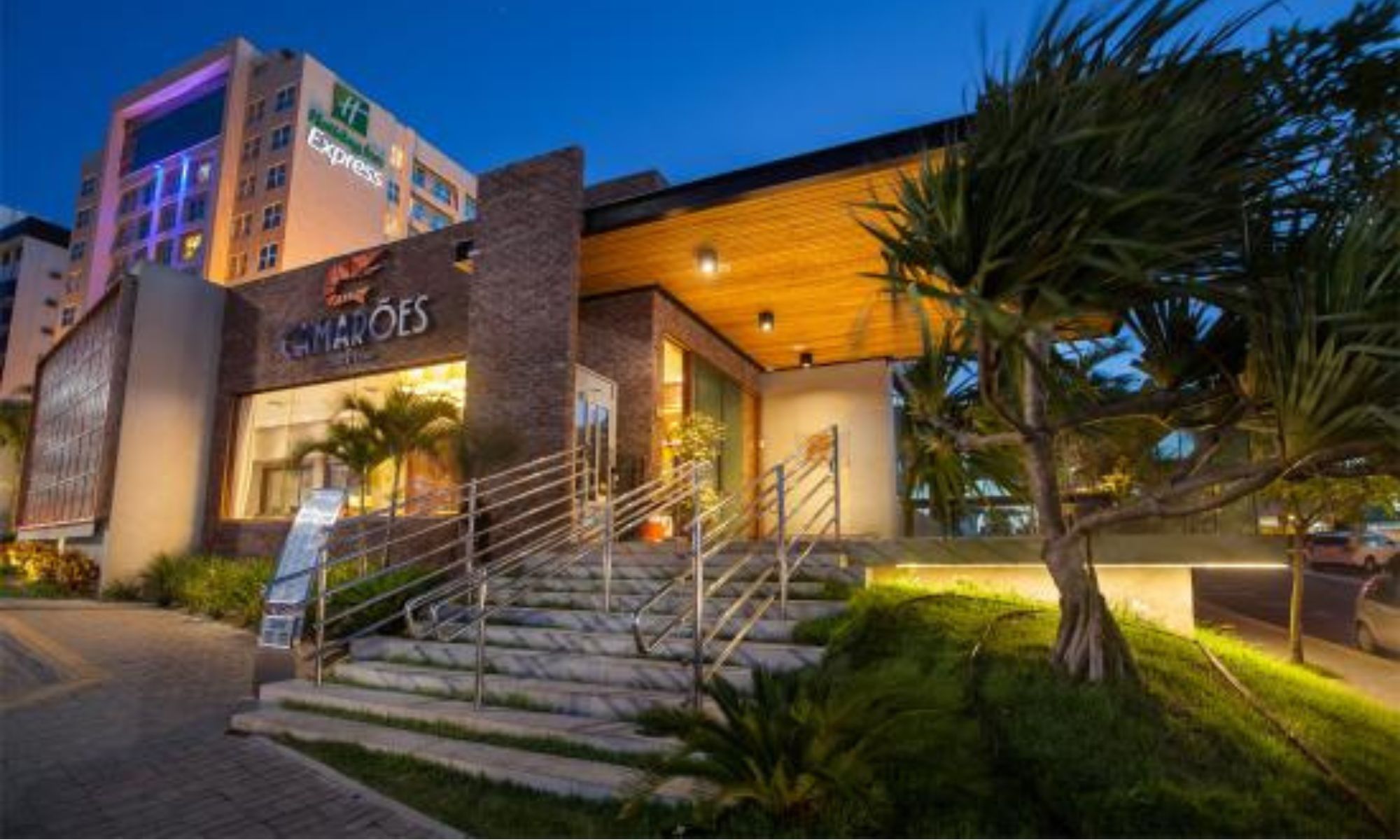
Restaurante Camarões
Sustainability
Brazil has significant initiatives and programs for promoting green practices and is engaged in developing more sustainable tourism destinations. The Ministry of Tourism and Braztoa (Brazilian Association of Tour Operators) are responsible for creating the Braztoa Sustainability Award, the country’s largest award on sustainable tourism and recognised by the UNWTO.
These organisations also developed the Map for Sustainable Tourism in Brazil . , in which the awarded initiatives are presented and promoted. The map aims to give visibility to businesses and destinations committed to increasing sustainability in the country’s tourism industry.
Photo © Thiago Japyassu
GOOD PRACTICE STORIES
Get inspired with stories from places and people that are acting for a fair and responsible tourism

The proposal of the Pedagogical Tourism project is to promote environmental awareness among students through pedagogical practices in tourism, providing a direct interaction with the theme of tourism in schools, as well as working on Environmental Education in a continuous and permanent manner, as stipulated by the PNEA – National Policy for Environmental Education (law 9795/1999). Additionally, it aims to stimulate Environmental Education as a cross-cutting theme through a comprehensive set of actions, as it cannot be addressed in isolation. Sensitization provides the locals with knowledge and a sense of belonging to the tourist attractions in the area.
KNOW THEIR STORY
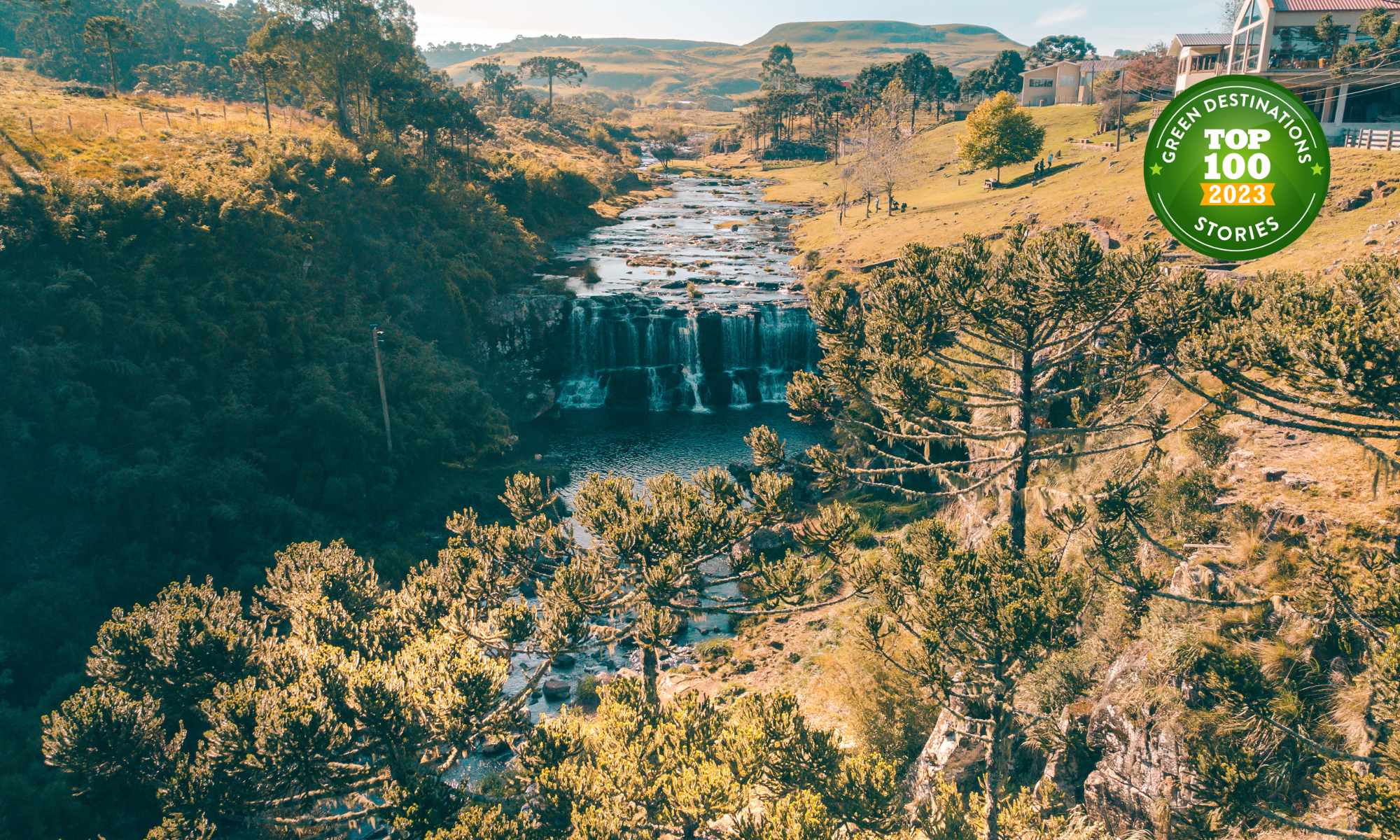
Bom Jardim da Serra
When tourism began to be developed in Bom Jardim da Serra, two accommodation projects were pioneers in structuring this sector: the Santa Rita farm and the Serra do Rio do Rastro Ecoresort. Structured in the late 1980s and early 1990s, the hotels in the mountains began to gain prominence and contribute to the development of a new local economic activity, further boosting the region. In that cycle, other economic segments feared that new ventures would displace labor, especially in fruit growing. The local community was not fully convinced of the benefits of tourism for the city, however, over time, there was a gradual change in perception. The great challenge of the projects was aimed at consolidating the city as a destination sought after by tourists, requiring great efforts from entrepreneurs for proper management, integration for the search for financing alternatives and other adaptations to market fluctuations, especially in the periods of seasonality.

The Sea School is a program of the Municipal Department of Education of Bombinhas, aimed at public school students, during after-school hours. Since 2017, the ecological and tourist aspects of Bombinhas have been explored as part of the pedagogical proposal of the Sea School. Children and teenagers, from the fifth year of elementary school on, participate in a broad, creative, and engaged training, which includes the main local socioeconomic aspects, including artisanal fishing, mariculture, and tourism. This is stitched with ancestral knowledge through the presence of masters in various arts and crafts, such as the making of fish nets and baskets, and gastronomy. Swimming classes, environmental education, and alternative income generation complete the teaching-learning process focused on sustainability.
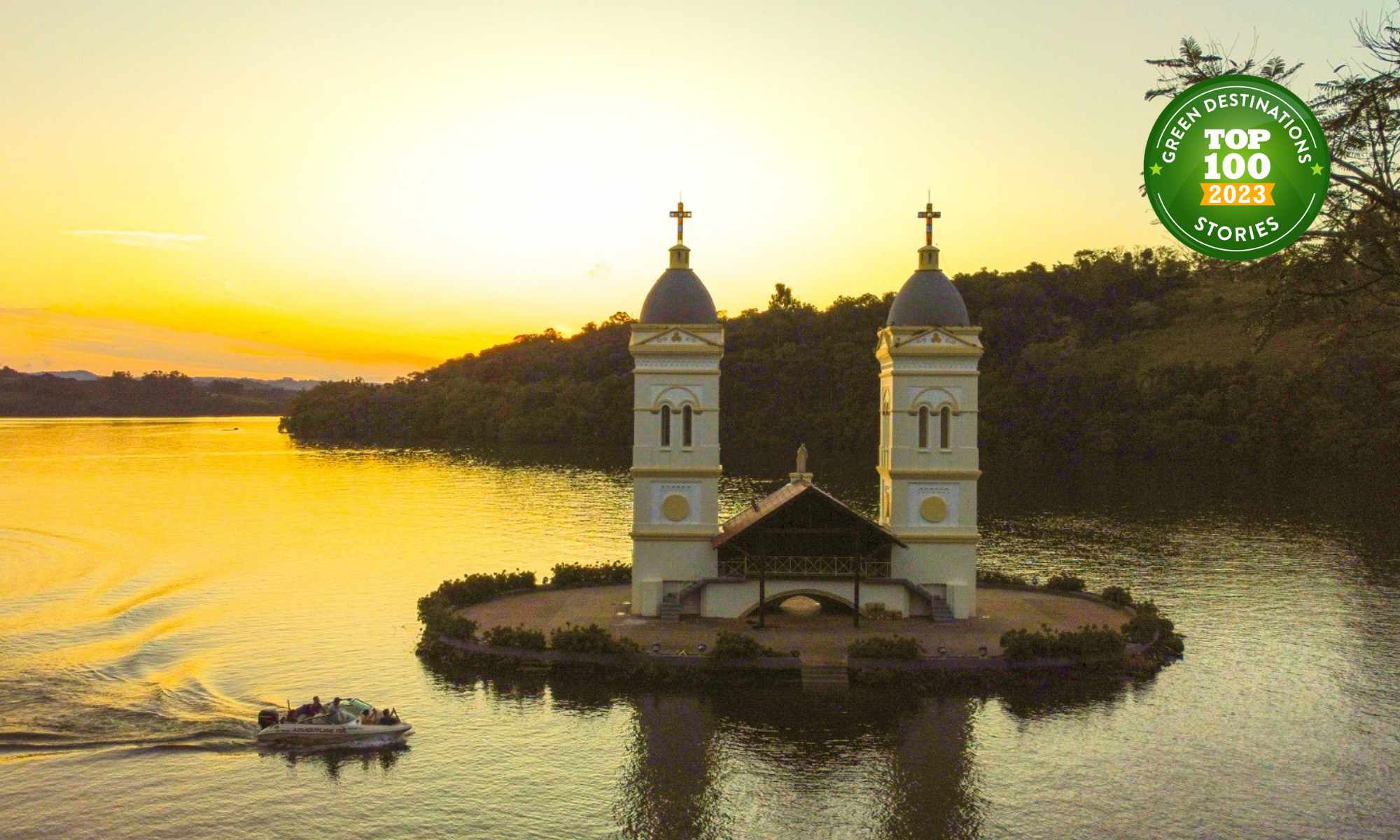
São Miguel do Gostoso
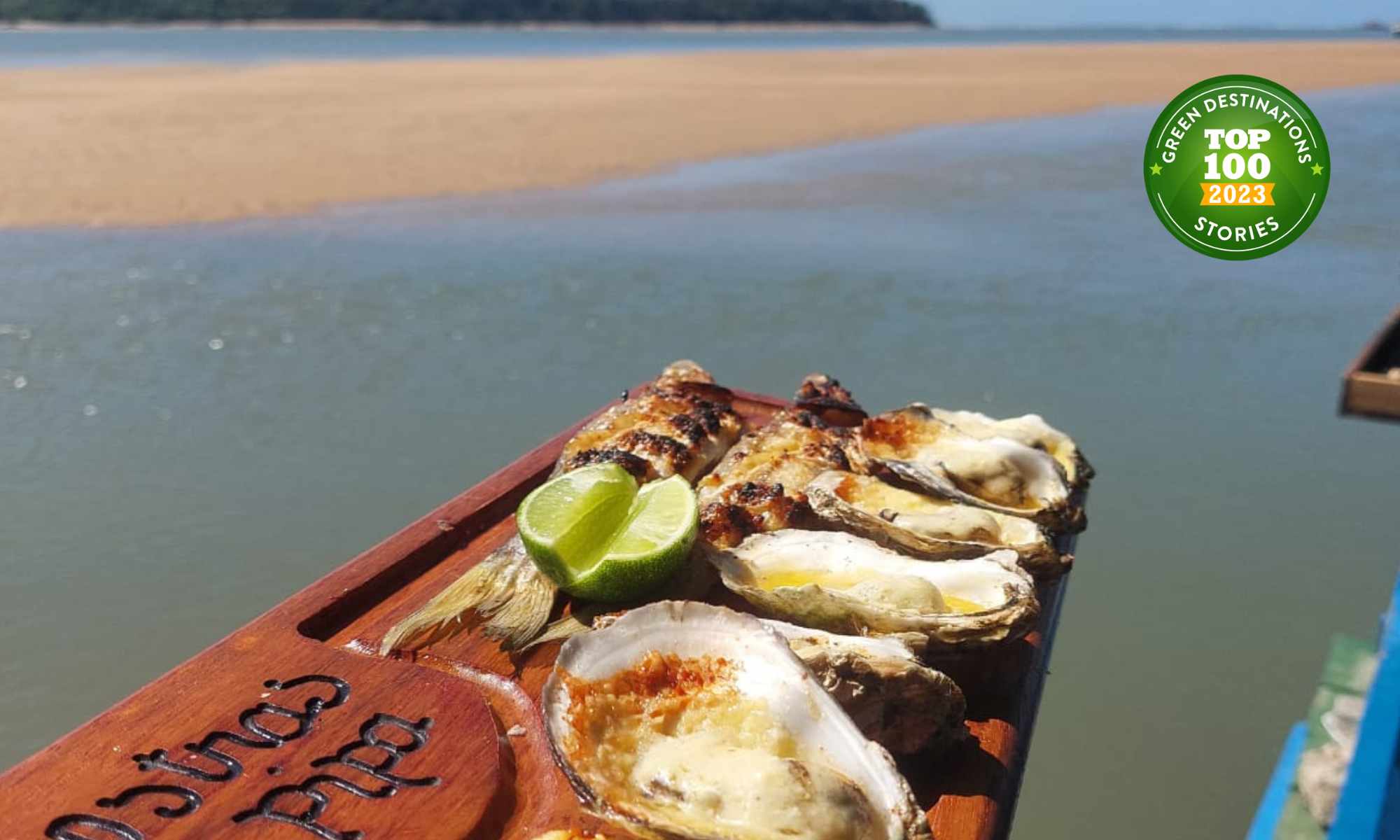
Tibau do Sul
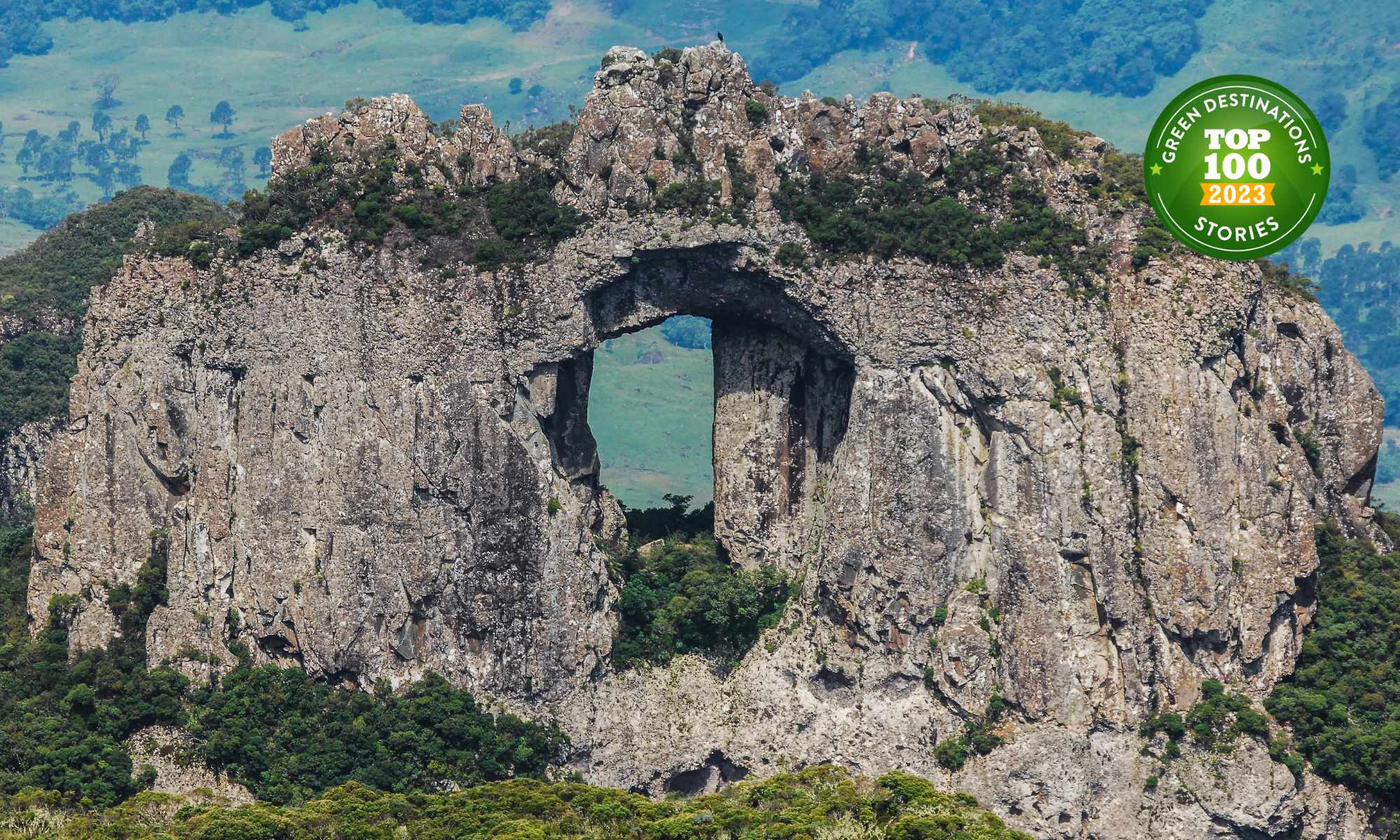
Tourism & People
Tourism in Brazil is mostly domestic and regional (56% of international tourists are South Americans), but nevertheless of great importance for the country’s GDP. Popular destinations – especially beach ones – may experience overtourism during summer holidays, New Year’s Eve and Carnival; however, given the size of the country, there are countless alternative destinations to choose from when trying to avoid these very touristic areas.
Brazilians are very open and friendly to foreign visitors, and if you know a few words in Portuguese, this will be very helpful, as English is not commonly spoken here. Photo © Vinicius Pontes
Travel tips from our editors

Try Local Food and Products
Brazilian cuisine is highly underrated! While Mexican food conquered the world (for good reasons!), most people are not familiar with Brazilian dishes and never had the chance to try. So, if you are in Brazil, take this opportunity to explore the immense variety of local fruits, legumes and vegetables, many only found in South America! The cuisine changes drastically from region to region in Brazil, but some ingredients are loved and used daily by all Brazilians, such as rice, beans and mandioca (cassava). Also, if you have a sweet tooth, our desserts will definitely not disappoint!

Enjoy the Rich Culture
Festivals, celebrations, crafts, music and dances in Brazil are diverse, authentic and just fascinating – and you are more than welcome to take part! We love sharing our culture, making new friends and having fun. Supporting local artisans and artists, going to restaurants and bars with live music, visiting museums and galleries, taking walking tours, eating at local markets and participating in community-based tourism (such as in Araribá ) are all very good ways to help us preserve our traditions and a key aspect of being a responsible traveler.
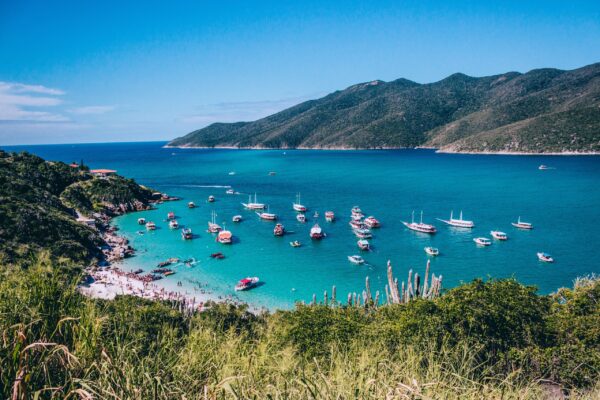
Getting around
Depending on the location of the places you wish to visit, it is often more convenient to fly, after all Brazil is huge! All capital cities and major destinations are served with national (and sometimes international) airports. Renting a car or travelling by bus, nevertheless, are also very good options for a more slow-paced travel. Buses are affordable and comfortable, but renting your own vehicle is more suitable for reaching more secluded places and for having more freedom to enjoy the landscapes and cities. Travelling by train is not an option, as railways are used only for the transportation of goods. There are, however, a few exceptions of scenic train routes for tourists, such as the one in Rio Negrinho , one of our featured sustainable destinations.
Nature & Wildlife
Brazil is a nature lover’s paradise, boasting unparalleled biodiversity and stunning landscapes. The Amazon Rainforest, the world’s largest tropical rainforest, is a sanctuary for countless species, from jaguars and macaws to vibrant poison dart frogs. The Pantanal, the world’s largest tropical wetland, is an incredible birdwatching destination and home to capybaras, caimans, and giant otters. The Atlantic Forest is rich in endemic species, such as the golden lion tamarin. Brazil’s diverse ecosystems offer an array of experiences, whether you’re exploring the Amazon’s jungle, trekking in the highlands, or lounging on pristine beaches, making it a true haven for nature enthusiasts.
Sustainability Recognitions
Brazil has 9 destinations featured in the Top 100 Sustainable Destinations 2021.

Other sustainability certifications can be seen here (English) and here (Portuguese).

Fernanda Rodak | Page Editor
“Brazil is a worldwide known hotspot for biodiversity as well as home to a multitude of cultural expressions. The natural and cultural heritage and immense variety of tourism experiences in the country are valuable assets for its competitiveness. Yet, as we envision a post Covid-19 era, sustainability in tourism becomes crucial to build resilience and guarantee the long-lasting health of Brazil’s ecosystems and well-being of the hosting communities. This would also ensure an active contribution of the country’s tourism sector to the Sustainable Development Goals.”
Visit other destinations nearby?
Get in touch Sign up to our newsletter About Contact Internships Privacy Policy
Support We are a multicultural, creative and dedicated team working to promote sustainable tourism. Join us in our fight against the climate crisis, single-use plastics and over-tourism!
Newsletter sign up
Matador Original Series
Trending cities, rio de janeiro.
Frank Sinatra once famously crooned, “They’ve got a lot of coffee in Brazil,” and while Old Blue Eyes definitely wasn’t wrong, he barely scratched the surface of what the fifth-largest country in the world has to offer.
Rio de Janeiro got its close-up to the world when it hosted the Olympics in 2016, and Rio’s beaches and legendary nightlife make for a blissfully hedonistic vacation. But don’t sleep on Sao Paulo either — we can show you how to find the best restaurants, bars, and day trips there too.
Brazil is also famous for its rainforest, the most biologically diverse place on the planet. We’ll take you inside Novo Airao and other little-known Amazonian jumping-off points. We’ll also give you tips on the best places to spot wildlife and even lead you to hidden swimming holes, where locals will be amazed at how you ever found what you were looking for.
Brazil also has a food scene reflective of the international diversity in the country, and you can learn all about its thriving Japanese community here too. Come along and explore Brazil, and see why coffee and caipirinhas are only the beginning.
Editors' Picks
Where to find the clearest waters in brazil's chapada dos veadeiros national park.
There's plenty to see in Brazil's Chapada dos Veadeiros National Park
How to Have the Perfect Day in Bonito, Brazil's Ecotourism Paradise
There's no question that Bonito is bonita
This Remarkable Suspended Bridge Is the Most Epic Way to See Brazil's Lush Landscapes
DO look down
This Copacabana Beach Hotel Has The Most Epic Rooftop Pool
Rooftop party? Yes, please.
All of the Incredible Animals You Can See at the World's Largest Tropical Wetland
The pantanal wetland is teeming with diverse wildlife
Beach Access and Ocean Views Await at This Boutique Rio de Janeiro Hotel
This is the best place to his the Rio beach
The 10 Most Romantic and Convenient Rio de Janeiro Hotels
Copacabana, anyone?
These Rio de Janeiro Airbnbs Put You Near Beach, Music, and Culture
These Rio de Janeiro Airbnbs are the best in the city.
National Parks
Chapada dos veadeiros is a natural paradise hidden in the brazilian highlands, brazil is full of stunning beauty, but lençóis maranhenses is next level, in brazil, planting trees to save the planet is really, really difficult work, freshwater snorkeling in ethereal bonito is brazil’s best-kept secret, novo airão in brazil is the perfect gateway to a remote amazonian adventure, there’s a crystal-clear swimming hole in the middle of this brazilian desert, food + drink, brazil’s bright red dendê oil is the key to its afro-brazilian cuisine, brazil’s mouth-numbing jambú plant is a taste sensation you’ve never had, bahia is the best place to eat in brazil. here are 9 dishes that prove it., 8 sweet, fruity, and savory brazilian desserts you need in your life, 10 food experiences you need to have in rio de janeiro before you die, the top 9 street food dishes of são paulo and where to find them, sustainability, more brazilians are giving up meat, and that’s great news for the planet, this rainforest-protecting brazilian distillery is a model for sustainability, brazil's new president is a threat to the environment. here’s what you can do about it., the pantanal in brazil is the best wildlife-watching spot in south america, rio's polluted waters won't be clean for the olympics. here are the staggering health precautions us boaters must take., your sustainable travel guide to the wild and remote brazil atlantic forest, 15 stunning natural areas in brazil, 11 most incredible instagrams from carnaval in rio, 14 legendary natural wonders of south america, the world's largest religious statues, 33 places to swim in the world's clearest water, 18 scenic places to teach esl, this villa in brazil has a glass-bottomed floor above a private aquarium, these airbnbs give you a cozy escape near rio's carnival action, 10 são paulo airbnbs with rooftop pools, serene gardens and bohemian vibes, airbnb now has a towers category. these 9 will climb your bucket list, the 20 funniest expressions in brazil (and how to use them), 11 things brazilians say when they're pissed, can't go abroad to learn a language skype with the elderly instead, 10 extraordinarily useful brazilian portuguese phrases, your handy language guide to extremely dirty portuguese, slang and idioms from around the world.
We use cookies for analytics tracking and advertising from our partners.
For more information read our privacy policy .

- Work With Me
- SEO Services
- All Destinations
- Philippines
- Timor-Leste
- United Arab Emirates
- Czech Republic
- Netherlands
- Switzerland
- ALL Oceania
- New Zealand
- ALL North America
- United States of America
- ALL South America
- South Africa
- Adventure Travel
- Budget Travel
- Nature Travel
- Digital Nomad Life
- Australia – Sydney
- Colombia – San Andres
- Costa Rica – Tamarindo
- Czech Republic – Prague
- England – London
- Guatemala – Antigua
- Labuan Bajo
- Nusa Penida
- Japan – Tokyo
- Puerto Escondido
- New Zealand – Queenstown
- Netherlands – Amsterdam
- Spain – Barcelona
- Thailand – Bangkok
- UAE – Dubai
- Atlanta, Georgia
- Los Angeles, California
- Miami, Florida
- Orlando, Florida
- Vietnam – Ho Chi Minh
- Plan Your Trip
- Blogging Tips
- Boost Your Traffic For Free!
What You Need to Know To Travel To Brazil In 2024: A Complete Guide
Planning a trip to Brazil in 2024? Whether you’re enticed by the vibrant city life of Rio de Janeiro , the awe-inspiring Amazon rainforest, or the breathtaking beaches of Salvador, it’s crucial to have a comprehensive understanding of what awaits you in this diverse South American country.
Adequate preparation is key to ensuring a smooth and enjoyable travel experience. In this complete guide, I’ll provide you with all the essential information you need to know before embarking on your Brazilian adventure.

Throughout this guide, we’ll provide you with invaluable Brazil travel tips, insider insights, and recommendations to make your trip as enjoyable as possible. From navigating transportation options to exploring the country’s rich cultural heritage, we’ve got you covered.
So, get ready to immerse yourself in Brazil’s vibrant tapestry of sights, sounds, and flavours. By arming yourself with the knowledge and preparation outlined in this guide, you’ll be well-equipped to embark on an unforgettable adventure across one of South America’s most captivating destinations.
At A Glance
What To Expect When You Travel To Brazil
Best time to visit brazil, visa requirements, passport validity, travel insurance and essential documents, vaccinations, covid-19 protocols, travel restrictions and safety, 1. embark on a wild amazon rainforest expedition, 2. hike to christ the redeemer, 3. samba in rio de janeiro, 1. research your destination, 2. blend in, 3. stay informed, 4. use reliable transportation, 5. be aware of your surroundings, 6. watch out for fraud, 7. atm pink flags, 8. favelas – urban hood vibes, 9. big bashes like carnival, 10. dive safely, 6. share your itinerary, 7. stay connected and informed , holafly esim: your ticket to unlimited internet access.
Now, let’s delve into what you can expect when you travel to Brazil. First and foremost, it’s crucial to be aware of any travel restrictions that may be in place.
As of the current situation, please stay updated with the latest guidelines and regulations, as travel restrictions to Brazil may vary due to global circumstances. Always consult official sources such as your local embassy or consulate for the most accurate and up-to-date information.
Safety is a common concern for travellers, and Brazil is no exception. While the country offers incredible experiences, it’s important to exercise caution and remain vigilant, especially in crowded tourist areas and urban centres.
Familiarise yourself with the local customs and be mindful of your surroundings. By taking common-sense precautions, you can greatly reduce any potential risks and enjoy a safe and memorable journey.
When it comes to timing your visit, Brazil offers a variety of climates and experiences throughout the year. The best time to travel depends on your preferred activities and destinations within the country. From December to March, you’ll find Brazil in its summer season, with warmer temperatures and vibrant festivals like Carnival.
However, if you’re planning to explore the Amazon rainforest, it’s advisable to visit during the drier months from June to November to make the most of your wildlife encounters and trekking adventures.

Rio de Janeiro, Brazil
Travel Requirements for Visiting Brazil
For U.S. citizens planning to travel to Brazil in 2023, it’s important to understand the visa requirements. As of the latest updates, Brazil requires U.S. passport holders to obtain an entry visa before their arrival .
However, it’s worth noting that there have been discussions of visa exemption for U.S. citizens in the future, so it’s advisable to stay updated with the latest information from the Brazilian embassy or consulate.
To enter Brazil, your passport must be valid for at least 6 months beyond your planned departure date. It’s essential to check your passport’s expiration date well in advance and renew it if necessary. This precaution ensures smooth entry and avoids any potential travel disruption.
While not mandatory, it’s highly recommended to have travel insurance when visiting Brazil. Travel insurance provides financial protection in case of unforeseen events such as medical emergencies, trip cancellations, or lost baggage. For long-term travellers like myself, I always fall back on either Safetywing or PassportCard Nomads .
Be sure to review the policy coverage carefully to ensure it meets your specific needs and covers any activities you plan to engage in during your trip.
In addition to a valid passport and travel insurance, it’s essential to carry certain documents with you during your visit to Brazil. These include your flight tickets, hotel reservations, a copy of your travel itinerary, and contact information for your embassy or consulate in case of any emergencies or unforeseen circumstances.
Although there are no mandatory vaccinations for entry into Brazil, it’s recommended to be up-to-date on routine vaccines .
Additionally, it’s advisable to consult with a healthcare professional or travel medicine specialist regarding any recommended vaccinations based on your specific travel plans and personal health circumstances.
Due to the ongoing pandemic, Brazil has implemented specific COVID-19 protocols for travellers. These may include pre-travel testing, quarantine measures, or presenting a digital health declaration form.
It’s essential to stay informed about the latest requirements by checking the official websites of the Brazilian government, your airline, and the local health authorities in your departure country.
As a digital nomad, I know how important to travel safely during this pandemic , so make sure you do your best to prioritize your health!
While Brazil is a captivating destination, it’s important to stay informed about any travel restrictions that may be in place. Travel advisories and restrictions can vary depending on the global situation and may be subject to change.
Stay updated with information from reliable sources such as your local embassy, the Brazilian embassy, and official travel websites.
What To Do In Brazil
When it comes to jaw-dropping destinations and thrilling experiences, Brazil reigns supreme. Brace yourself for a whirlwind of adventure as we unveil the top 3 must-do activities that’ll make your trip to Brazil an unforgettable journey of a lifetime!
Prepare to be mesmerised by the enchanting allure of the Amazon rainforest . Immerse yourself in the heart of the world’s largest tropical rainforest, where vibrant wildlife and lush vegetation create a symphony of nature’s wonders.
Explore the mighty Amazon River on a captivating boat tour , witness exotic creatures in their natural habitat, and discover hidden gems tucked away in this ecological paradise.
Brace yourself for thrilling encounters with pink river dolphins, playful monkeys, and colourful birds, all while basking in the mystical ambience that only the Amazon can offer.
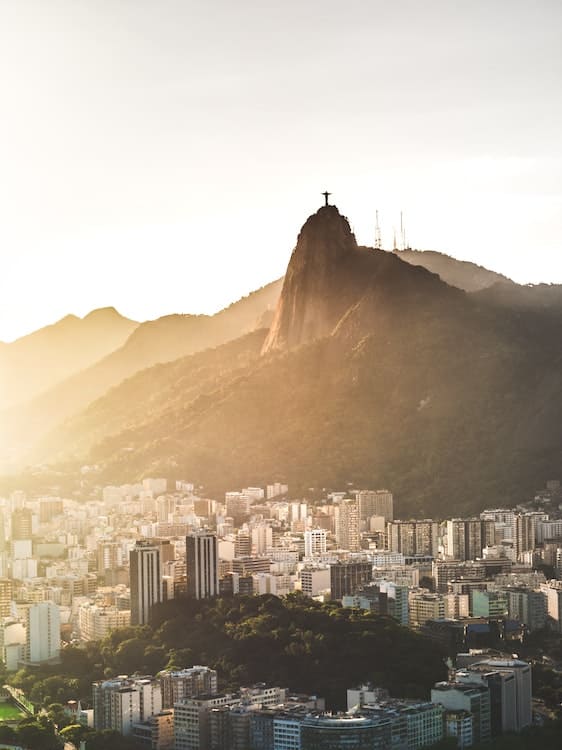
Elevate your travel experience with an epic hike to one of the New Seven Wonders of the World – Christ the Redeemer .
Brace yourself for an exhilarating journey to the pinnacle of Corcovado Mountain , where the colossal statue of Christ stands, arms outstretched, offering a breathtaking panoramic view of Rio de Janeiro.
As you ascend, feel the rush of adrenaline and the awe-inspiring beauty of the surrounding Tijuca Forest National Park .
Reach the summit, stand in awe before the iconic figure, and let the sheer magnitude of the moment take your breath away. Capture the perfect Instagram-worthy snapshot and create memories that’ll forever be etched in your heart.
No trip to Brazil is complete without experiencing the pulsating energy and vibrant nightlife of Rio de Janeiro . Brace yourself for a kaleidoscope of colours, pulsating rhythms, and the infectious joy of samba.
Join the revellers at the legendary Carnival, where streets come alive with extravagant costumes, captivating floats, and electrifying music. Dance the night away in the bustling samba clubs, where the infectious beats will sweep you off your feet.
Feel the rhythm in your soul as you sway to the music and become part of the vibrant tapestry that’s the essence of Rio’s party scene.
With these extraordinary adventures awaiting you, Brazil beckons you to unleash your wanderlust and dive into a world of unforgettable experiences. So, pack your bags, embrace the spirit of exploration, and get ready to create memories that’ll last a lifetime in the captivating land of Brazil!

Pelourinho, Salvador, Brazil
Safety Tips for Travellers in Brazil
When travelling to Brazil, it’s essential to prioritise your safety to ensure a pleasant and worry-free trip.
While Brazil offers a wealth of incredible experiences, it’s important to be aware of certain safety considerations and take necessary precautions. By following these safety tips, you can mitigate potential risks and enjoy a memorable visit to this vibrant country.
Here are some general safety considerations.
Before travelling to Brazil, familiarise yourself with the specific safety situation of the regions you plan to visit. Stay updated on travel advisories and avoid areas with a high crime rate or political unrest.
It’s advisable to consult official sources such as your country’s embassy or consulate for the most accurate information.
Dress modestly and avoid wearing expensive jewellery or flashing valuable items. By blending in with the local culture and not drawing unnecessary attention to yourself, you can reduce the risk of becoming a target for theft or scams.
Stay up-to-date with the latest news and developments in the areas you’re visiting. Follow local news sources or reputable international news outlets to stay informed about any potential risks or safety concerns.
For personal security, there are measures for you to take into consideration for a smooth and amazing experience.
Opt for registered taxis or rideshare services rather than unmarked or unofficial vehicles. Avoid hailing taxis on the street, especially at night, and instead, ask your hotel or restaurant to arrange transportation for you.
Stay vigilant in crowded places, tourist attractions, and public transportation. Keep an eye on your belongings, particularly in crowded areas where pickpocketing may occur. Avoid displaying expensive electronic devices or large amounts of cash in public.
Be on guard against bank and credit card trickery, which is pretty common here. That includes sneaky stuff like card cloning at ATMs or shops. Keep a close eye on your card, and if something feels off at an ATM, don’t use it. Oh, and do your bank a solid by giving them a heads-up about your trip beforehand, so they don’t freeze your card unexpectedly.
If you hit up an ATM and spot any pink marks, don’t hesitate – chat up the bank (or the police) ASAP to swap that cash. Those pink stains could mean the cash is messed up or fake, and nobody wants that.
Favelas are like these informal, unplanned neighbourhoods – you’ll find them in big Brazilian cities. They can be tiny pockets or sprawling areas. Sometimes they’re near tourist hotspots. Just be in the know about where you’re heading.
Hitting up a massive party like Carnival? Keep your radar on. Crooks might target folks who seem loaded or a little out of it. Look after yourself, stay sharp, and be careful if some random person tries to pull you away from the crowd.
If you’re taking a dip, be water smart. Some beaches have gnarly currents that can be tricky. Listen up to local advice, watch those warning flags, and spot where the lifeguards are hanging.
Sharks are a real thing, especially around Recife in the northeast. Pay attention to those warning signs and chat up lifeguards if you’re not sure. Stay out of the water if you see those signs – sharks don’t mess around, even in waist-deep water.
Inform a trusted person, such as a family member or friend, about your travel plans and itinerary. Check in with them regularly and provide updates on your whereabouts.
Having a reliable internet connection during your trip to Brazil is crucial for staying connected and informed. With an internet data plan, you can enjoy the convenience of unlimited internet access, ensuring you have vital information and communication at your fingertips.
Remember, the key to a safe journey in Brazil is being prepared, informed, and alert. By following these safety tips and staying connected with a reliable internet connection, you can make the most of your travel experience while ensuring your personal well-being throughout your adventure in Brazil.
In the age of connectivity, staying connected while travelling has become a necessity. Enter Holafly eSIM, your passport to seamless and unlimited internet access during your adventure in Brazil.
Say goodbye to the hassle of purchasing local SIM cards or relying on public Wi-Fi hotspots. I can attest to that first hand having to travel around different parts of Europe in the same trip. With Holafly eSIM, you can stay connected wherever you go, ensuring you have the world at your fingertips.
So, how does eSIM technology work, and why is it advantageous? Unlike traditional physical SIM cards, eSIM is embedded directly into your device, eliminating the need for a physical swap.
This means no more searching for SIM card vendors or dealing with compatibility issues. With a few simple taps, you can activate Holafly eSIM on your device, allowing you to enjoy high-speed internet without any limitations.
Holafly eSIM offers a myriad of benefits that’ll enhance your travel experience. Firstly, it provides you with reliable and high-speed internet coverage throughout Brazil, even in remote areas.
From the bustling streets of Rio de Janeiro to the breathtaking landscapes of the Amazon rainforest, you can stay connected and share your adventures in real time.
Not only does Holafly eSIM provide extensive coverage, it also offers cost-effectiveness. With competitive pricing plans tailored to suit various travel durations and data needs, you can select the package that best aligns with your requirements.
No more worrying about excessive roaming charges or limited data allowances. Holafly eSIM ensures you have the freedom to explore, connect, and share without breaking the bank.
Getting started with Holafly eSIM is a breeze. Simply visit the Holafly website , select your desired plan, and follow the easy steps to purchase and activate your eSIM.
Whether you’re an experienced traveller or embarking on your first international trip, Holafly eSIM makes staying connected effortless and convenient.
As we conclude this complete guide to travelling to Brazil in 2023, let’s recap the key points that’ll ensure your journey is nothing short of extraordinary. Adequate preparation is paramount, from meeting travel requirements to prioritising your safety.
Brazil is a country brimming with diverse landscapes, vibrant culture, and thrilling experiences. Whether you’re exploring the Amazon rainforest, conquering heights to reach Christ the Redeemer, or immersing yourself in the electric atmosphere of Rio de Janeiro, Brazil promises unforgettable memories at every turn.
The wonders of this magnificent country await you—so pack your bags, chase your dreams, and embark on a journey that’ll leave an indelible mark on your soul. Brazil is calling. Will you answer?
Isabel Leong
Full-time travel blogger at Bel Around The World and SEO coach roaming the world at a whim, Isabel helps aspiring content creators and brands get the most out of their online presence by attracting organic leads/traffic and achieving financial freedom with her Skyrocket With SEO course. She's closely involved in and has been featured as a speaker in other travel & digital nomad networks & podcasts such as Traverse, Travel Massive, The Nomadic Network and Location Indie.

Hi! I'm Isabel, a full-time traveller and digital nomad from Singapore. In the past 10 years, I've lived in New Zealand , Japan , Kauai Hawaii , Mexico , Costa Rica and Bali . Pulling from my own world travel adventures and blogging lessons, I share my tried and tested tips, so that I can get YOU to work LESS and play MORE!

Previous Post How Much Data Do You Need to Travel in Europe? A Comprehensive Guide
Next post costa rica vs mexico - choosing the perfect tropical escape.
Comments are closed.
- Destinations
- Privacy Policy
- Skyrocket Your Site Traffic!
Join the newsletter and get exclusive travel tips, giveaways and more!
There are times to stay put, and what you want will come to you. And there are times to go out into the world and find such a thing for yourself. – Lemony Snicket
© 2024 Bel Around The World. All Rights Reserved. Website design by Hello Pomelo .

Best sellers
Regional plans
- North America
- Latin America
- United Kingdom
All destinations
- Bosnia and Herzegovina
- Central African Republic
- Democratic Republic of Congo
- Dominican Republic
- Czech Republic
- El Salvador
- Faroe Islands
- Isle of Man
- Ivory Coast
- Liechtenstein
- New Zealand
- Papua New Guinea
- Philippines
- Puerto Rico
- Republic of Congo
- Saudi Arabia
- South Africa
- South Korea
- St. Pierre and Miquelon
- Switzerland
- The Netherlands
- Trinidad and Tobago
- Turks and Caicos
- United Arab Emirates

You haven't added products to the cart
Total: EUR € 0,00
Continue shopping
Choose a currency
Suggested languages
iPhone XS Max
iPhone 11 Pro
iPhone 11 Pro Max
iPhone SE (2020)
iPhone 12 Mini
iPhone 12 Pro
iPhone 12 Pro Max
iPhone 13 mini
iPhone 13 Pro
iPhone 13 Pro Max
iPhone SE (2022)
iPhone 14 Plus
iPhone 14 Pro
iPhone 14 Pro Max
iPad Pro (2018 and onwards)
Watch series 3
Watch series 4
Watch series 5
Watch series 6
Pixel 6 Pro
Pixel 7 Pro
P40 Pro (not including the P40 Pro +)
Mate 40 Pro
Galaxy Z Flip
Galaxy Z Flip 5G
Galaxy Z Flip3 5G
Galaxy Z Flip4
Galaxy Fold
Galaxy Z Fold2 5G
Galaxy Z Fold3 5G
Galaxy Z Fold4
Galaxy S21+ 5G
Galaxy S21 Ultra 5G
Galaxy S22+
Galaxy S22 Ultra
Galaxy Note 20 Ultra 5G
Galaxy Note 20
Galaxy S23+
Galaxy S23 Ultra
Galaxy S20 Ultra 5G
Rakuten Mini
Find X3 Pro
Find X5 Pro
Xperia 10 III Lite
Xperia 10 IV
Xperia 1 IV
Xperia 5 IV
Magic 4 Pro
Aquos Sense6s

Check out our guide on how to find out if my device is eSIM compatible or contact us on our online chat
- Travel Guides
Travel Guide to Brazil (2024): Discover wonders
Know everything you need to travel to Brazil with our Travel Guide for 2024! Learn how to move around and how to remain connected!
January 1, 2024
In this article

Holafly saves you +30% compared to other roaming fees
Plans that may interest you

In today’s post, we’ve prepared the Brazil Travel Guide with everything you need to know to enjoy your stay in the main cities and tourist destinations of the fifth-largest country in the world and one of the most visited countries, thanks to its wide and diverse tourist, gastronomic and cultural offer.
In this guide, you will find plans and unmissable destinations, the best time to go to Brazil, what to bring in your suitcase, options to have internet, ideas for your travel itinerary, immigration requirements and other important issues that you cannot lose sight of. Let’s start!
Excited about traveling abroad?
Stay connected while in Brazil, exploring the vibrant cities and diverse nature, and with Holafly’s unlimited data eSIM, you do so without any hassle. With 5% OFF. Code: MYESIMNOW5
Best time to travel to Brazil
Before planning your trip, you should identify the best time to travel to Brazil, which is in this guide. For many travelers, summer is undoubtedly the ideal time to enjoy the iconic beaches of Copacabana, Ipanema, Praia do Forte, Fernando de Noronha, to name a few.
For other travelers, the best time is in the low season to enjoy a vacation without the crowds. Regardless of your choice, it is important to know the different seasons of the year to identify the best time for your next trip.
Spring in Brazil takes place from September to December. It is characterized by pleasant weather with mild temperatures and occasional rain in some regions of the country, although in destinations such as Rio de Janeiro and São Paulo, tropical weather predominates.
On the other hand, it is a low season, so you can find cheaper flights and accommodations. And, as for the tourist offer, you will be able to appreciate the flowering of different species of trees in different regions and enjoy a wide cultural agenda, but we will talk about this later.
Summer in Brazil starts at the end of December and lasts until March. The weather is quite hot with temperatures that can exceed 40°C. As mentioned above, this is the best time to enjoy the iconic Brazilian beaches, as well as the rainforests and national parks.
Autumn starts in the last days of March and lasts until June. Here you will have mild weather with temperatures above 20°C, making it ideal to visit the main cities and enjoy cultural tourism plans.
Finally, there is winter, which begins at the end of June and lasts until September. The weather is particularly cool, although with lower temperatures, especially in the south of the country, so it would be advisable to visit mountainous areas.
Guide to must-see plans and destinations in Brazil
In every season of the year, you will find unmissable plans and destinations to enjoy in different regions of the country. The choice is up to you, as it all depends on your lifestyle, preferences and travel budget. Below, we’ll give you some inspiration with these recommended cultural activities:
World-class activities in Brazil
Oktoberfest Date : October Destination : Blumenau
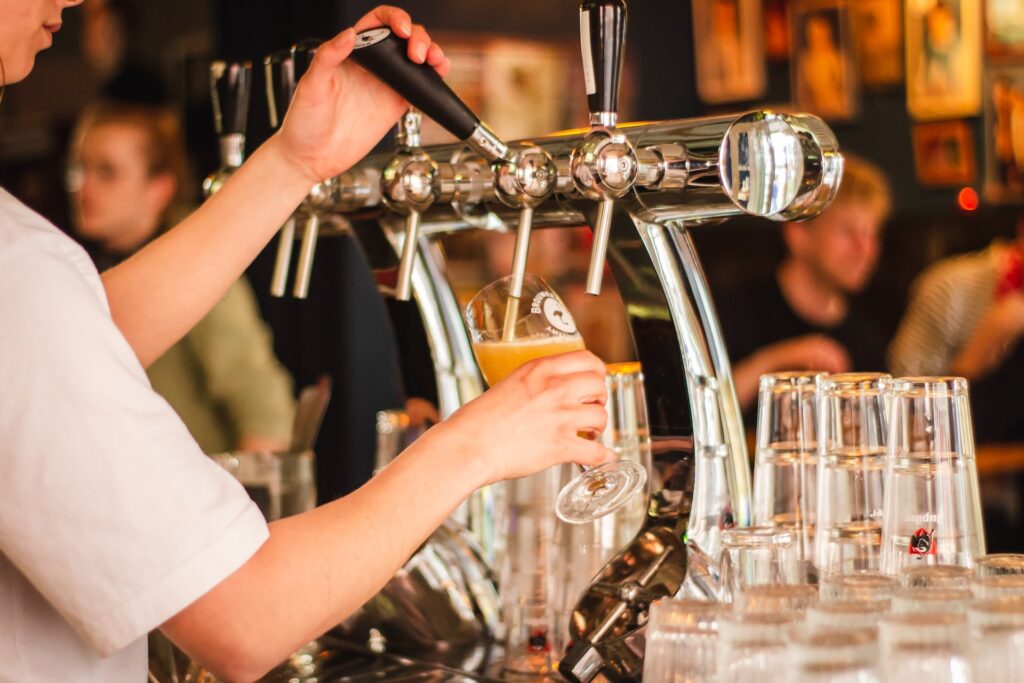
This festival is a tribute to the original version held annually in Munich, Germany. In Brazil, it is celebrated in several cities, especially in Blumenau, Santa Catarina and São Paulo . Beer is the great host of the event, which is also accompanied by a festive atmosphere with live music, dances, costumes and typical food, such as the famous German sausages.
Tomorrowland
Date : October Destination : São Paulo

The Tomorrowland Festival is the largest electronic music event in the world. It is held three times a year, thanks to its different venues in Belgium, France and Brazil. It is widely recognized for its incredible performance and staging, with the participation of the best exponents of this musical genre. if you want to go, check on the official website for your tickets and add them to your itinerary for Brazil and follow this travel guide for more!
São Paulo Comic-Con (CCXP)
Date : November 30 to December 03 Destination : São Paulo

It is the largest pop culture event in the world. It is characterized by bringing together thousands of fans of comics, movies, TV and video games, through the recreation of worlds that recreate their favorite productions to live a unique experience, meeting their favorite stars, in addition to enjoying many activities, including the famous contest, cosplay.
> You might be interested in the Comic-Con San Diego Guide <
Date : December 31 Destination : Florianópolis, Recife, Rio de Janeiro, São Paulo and Paraná

This is the most important New Year’s Eve event in Brazil, although it is also celebrated in other parts of the world. On this date, it is common for families and friends to gather to celebrate the arrival of the new year in public (and even private) spaces to enjoy multiple cultural activities, organized by the local governments of each city. This is a must-go on your itinerary and is a top recommendation in this travel guide to Brazil.
Rio de Janeiro Carnival
Date : February / March Destination : Rio de Janeiro

This travel guide to Brazil wouldn’t be complete with the Rio Carnival. This Rio Carnival is one of the most famous popular festivals in the world. For four days, thousands of people gather in the city to enjoy the parades of the Samba schools, parties and cultural activities that take place throughout the city, being one of the most anticipated celebrations by Brazilians and foreign tourists.
Lollapalooza
Date : March Destination : São Paulo

The Lollapalooza Festival is an event created to annually bring together lovers of music, art, food, fashion, among other categories, with world-class artists. It originated in the United States and quickly expanded to countries such as Chile, Argentina, Germany, France, Sweden and Brazil.
You may be interested in maintaining an internet connection with an eSIM for Argentina !
Brazil Flavor
Date : May / June Destination : All Brazil

Of course, food can’t be skipped in this travel guide to Brazil. For food lovers there is the Brazil Sabor Festival , an event that already has its 18th version for 2024. Every year, more than 900 restaurants participate in the main cities of the country, so it is a great opportunity to discover the flavors, recipes and gastronomic secrets of Brazilians.
Rock in Rio
Date : Held every two years Destination : Rio de Janeiro

The Rock in Rio music festival originated in Brazil and, thanks to its popularity, its celebration has expanded to cities such as Lisbon, Madrid and Las Vegas. It features the participation of world-class artists in different musical genres: rock, electronic, pop and Brazilian music.
Popular festivals in Brazil
In addition to the Rio Carnival, there are other popular festivals, declared as Intangible Cultural Heritage of the nation, such as the Festivities of the Divine Holy Spirit , held annually in Pirenópolis.
But there are also important celebrations such as the Congadas , which gather Catholic and African traditions; the Tiradents Day ; the Parintins Folklore Festival ; the Sâo Jôao Festivities ; the Junina Festival , among other religious representations.
Requirements to go to Brazil
The requirements to travel to Brazil as a tourist depend on your country of origin, continue reading this guide to find out more! In some countries, it is only necessary to present your passport to enter Brazil, while in other cases it is essential to have a visa. That is why in this section we will explain what you must provide:
Valid passport
This document must be valid for the length of your stay in Brazil. It must be in good condition and have a photo that allows clear identification of the holder.
Tourist Visa
A list of countries that can enter the country without a visitor’s visa (VIVIS) is published on the website of the Brazilian Ministry of Foreign Affairs , among them: Argentina , Colombia , Chile , Spain and Mexico .
To enter the country by car, in addition to the immigration requirements, you must present a valid driver’s license, vehicle ownership card, valid compulsory insurance and other documents proving the authorized exit of private and public vehicles from each country, in accordance with national laws.
Fact : If you are traveling as a Digital Nomad , we explain the requirements and how to apply for a special visa.
Entry and exit airfare ticket
Upon arrival at the airport, the Brazilian immigration authorities will ask for your passport and/or visa to verify your identification and at the same time will ask you to fill out a form to allow you to enter and leave the country.
Confirmed reservation with round-trip flights
For your trip, you must have an airline ticket with a confirmed round-trip reservation. You will also have to justify the purpose of your trip to the immigration authorities.
Vaccinations
Currently, there are no health restrictions for entering Brazil. Neither is the yellow fever vaccine required as a migratory requirement, nor the presentation of an international vaccination certificate; however, this vaccination schedule is recommended to protect the traveler’s health.
How to create a travel itinerary in Brazil
Another important aspect in planning your trip to Brazil is to dedicate time to create a travel itinerary that will help you optimize your time , regarding the destinations you plan to visit and the activities you can do. This way you can book flights and accommodations without leaving it to the last minute, but also create a route to visit the most emblematic places of each destination.
Surely, you are thinking of going to traditional travel agencies to take care of the planning and organization of the trip, but thanks to mobile technology, you can create your own travel itinerary with different mobile applications, such as the ones we will present below:
This app gives you the possibility to find free tours in Brazil’s main cities , with the support of a local guide who speaks different languages and will accompany you while you travel through different cultural tours to learn about important places and interesting facts about each destination.
Another free app that can be very useful when planning your trip is Passporter . With this app, you can get inspired by the experiences of other travelers, choose the destinations of your interest, create a personalized travel route, upload your reservations and invite other participants to contribute ideas to your trip planning.
Options to get internet in Brazil
Having the internet is another important issue to have all the control of your trip in one place. Fortunately, in Brazil, you will have multiple alternatives to secure your internet connection, but not all options are as convenient either for budget, security, practicality or compatibility reasons.
Below, we will share with you the alternatives most used by travelers so that you can choose the best option, take note!
eSIM International
If you have a smartphone compatible with eSIM technology , you can activate a prepaid data plan for your trip to Brazil, without depending on an operator or paying roaming fees. The purchase, installation and activation of this eSIM is at your own expense since the process is 100% virtual, although you have a 24/7 customer service team to resolve any issues related to your eSIM.
There are currently providers specialized in travel eSIMs; one of them is Holafly. Their online store has eSIMs for multiple destinations, with flexible plans and rates. For Brazil, you can find an offer of plans with Unlimited Data, starting at $19 . Any of these also includes 500 MB per day for data sharing.

Prepaid SIM cards
If you do not have a cell phone compatible with eSIM, the following alternative with SIM cards of the main local operators; in this case we are talking specifically about: TIM, Claro and Vivo. Each of these companies offers coverage in different regions of the country, so you should check the coverage you need before choosing any of these options.
These chips include data, minutes and SMS messages for local use with different plans and rates. However, keep in mind that to acquire a SIM and activate a package of mobile services you must meet the requirements indicated by each operator and therefore, it will take some time.
International roaming
The roaming service will allow you to continue using your cell phone in Brazil, as if you were at home. The activation of this service is done with the operator that manages your mobile service plan in your country, but keep in mind that the rates for each consumption you make abroad can be very high.
That is why we recommend other options such as Pocket WiFi, which are small pocket routers that you can take anywhere, but also have several associated costs that you must assume at the time of renting the equipment.
WiFi is the most practical alternative for many travelers, since it allows them to connect for certain periods of time in public establishments such as cafés, hotels, airports, libraries, among other places.
Although it is the cheapest option, it is not the safest and that is why we have left it for last. It is best to look for private connections to avoid putting your information at risk.
Guide to Public Transportation in Brazil
This is an important part of this travel guide for Brazil, so pay close attention. The country has several means of public and private transportation, available to everyone.
Buses : Each city has its own integrated transportation network and fares may vary, depending on the distance traveled. To use this service, you must purchase a card (cartão) at the main stations.
Metro : Cities such as Brasília, São Paulo and Rio de Janeiro have this transportation system, which is the fastest and most efficient in the country. Its fares are affordable and anyone can use it.
Trains : This means of transportation connects the metropolitan area of São Paulo and Rio de Janeiro with outlying neighborhoods, also known as suburbs. It is very convenient for traveling long distances, connecting cities and towns that are located in the interior of the country.
Streetcars : This transportation system is a bit more traditional and is found in cities such as Rio de Janeiro and Porto Alegre.
Cabs : Taxis in Brazil are available in various colors and provide different services. For example, in São Paulo, yellow taxis provide regular services, while white taxis provide special transportation.
- Fact : Before accepting the service, check to confirm the estimated fare as some drivers may charge you more money because you are a foreigner.
Where to exchange currency in Brazil?
When it comes to options for exchanging currency in Brazil there are exchange houses, banks and ATMs.
Currency exchange offices in Brazil
Travelex Confidence Casa de Cambio Cotação Western Union
Banks for currency exchange
Banco do Brasil Caixa Econômica Federal Itaú Unibanco Banco Bradesco Banco Santander
ATM electronic tellers (Caixas eletrônicos)
Banco24Horas 24 Hour Network Bradesco Expresso Fact : Remember that before making currency exchange operations with any of these companies, it is important to investigate the rates and commissions to get the best offer.
Exchange houses usually offer the lowest rates, since they are establishments dedicated to offering this type of service.
Things worth buying in Brazil
In Brazil, you will find a wide range of products that you can take home as souvenirs. In addition, it is a way to contribute to the local economy and employment with handmade products, here are some ideas:
Leather handicrafts
Brazilian handicrafts are characterized by materials such as straw, açaí fibers, feathers from different species of birds, leather, wood, ceramics and textiles with traditional embroidery techniques. Additionally, you will find folk art and decorative objects such as lamps, mirrors and carved wood.
Brazilian Coffee
Brazilian coffee differs from other coffees in the world for its flavor and smoothness, with notes of chocolate and nuts; also for its consistency and export quality. It is a very traditional drink that you can bring as a gift for your family or friends.
Cachaça is a local drink, made from fermented sugar cane and distilled to produce a clear and strong liquor. It is used as a base to prepare the famous caipirinha, one of Brazil’s most popular cocktails.
Jewels and precious stones
Brazil is home to the most valuable gemstones in the world. We are talking about the emeralds, diamonds, sapphire, tourmaline, amethyst, among other high-quality stones. Hence, many tourists choose this destination to buy jewelry and gemstones at more affordable prices, compared to other countries such as India and Thailand.
Brazilian sweets
The brigadeiros and chocolates are local products with worldwide recognition for their delicious taste. So if you are thinking of giving an authentic gift to someone who enjoys these preparations, it can be a very good alternative.
What to take in your suitcase to Brazil?
Knowing what to take in your suitcase is an excellent way to optimize space and leave aside the famous “just in case” that can lead you to have extra weight when boarding the plane and carry a lot of weight, which can cause physical discomfort.
So to avoid this kind of uncomfortable situations, the best thing you can do is to prepare your travel suitcase with what will really be useful on your trip. Here is a list of the basics:
- Travel documents such as passport, important documents, credit cards.
- Light, comfortable and appropriate clothing for the activities you plan to do.
- Comfortable walking shoes, sandals, beach shoes.
- Accessories to cover yourself from the sun: sunglasses, hat or cap, sunscreen.
- Electronic devices such as your laptop, cell phone, chargers, cameras.
- Toiletries and personal care products in the quantities indicated in the travel policy.
- Medications with their respective medical support that validates their consumption.
- First aid kit
Fact : What you should bring in your suitcase may vary according to the region you visit and the season of the year, so it is advisable to create your travel itinerary to take what you need.
What to do in case of emergency on your trip to Brazil?
At any time on your trip you may have an emergency, whether due to accidents, diseases, natural disasters, organized crime, among other examples. It is therefore essential that you follow the recommendations provided by the Ministry of Foreign Affairs of your country.
This information can be found on the website of each Ministry. For example, on the website of the Ministry of Foreign Affairs of Spain, there is a section dedicated to travel information to Brazil. Among the important aspects to consider, keep in mind:
General protection recommendations.
Purchase a travel insurance with medical and hospital coverage with sufficient coverage in Brazil. It is advisable to be vaccinated against yellow fever and use repellent to avoid dengue, chikungunya fever and zika virus.
If you are traveling with children, you should always carry the parents authorization if not present. Avoid visiting risk areas such as favelas, especially in Rio de Janeiro, Salvador, São Paulo and Brasilia. Caution in border areas and other places to avoid.
Keep this travel guide close or on your phone so you can quickly check it while in Brazil!
Useful telephone numbers in Brazil
Emergency number in Brazil: 190 Telephone number for violence against women: 180 Number to request an ambulance: 192
> You might want to read our Hawaii Travel Guide <
Frequently Asked Questions
Vaccination is not an immigration requirement for travel to Brazil. However, it is important to be vaccinated against yellow fever to protect the health of travelers.
The official currency in Brazil is the real (BRL) and its symbol is R$. Its denominations in coins are: 1, 5, 10, 25, 50 cents and 1 real. And, as for banknotes: 1, 2, 5, 10, 20, 50 and 100 reais.
The official language is Portuguese, although there are also indigenous and immigrant languages spoken in different regions according to their cultural representations.
Rio de Janeiro and São Paulo for their beaches, carnivals and festivals; Iguassu Falls, Salvador de Bahia, Brasilia, Florianopolis, Recife, Fernando de Noronha, Manaus, Curitiba, Fortaleza, among others.

Related reading
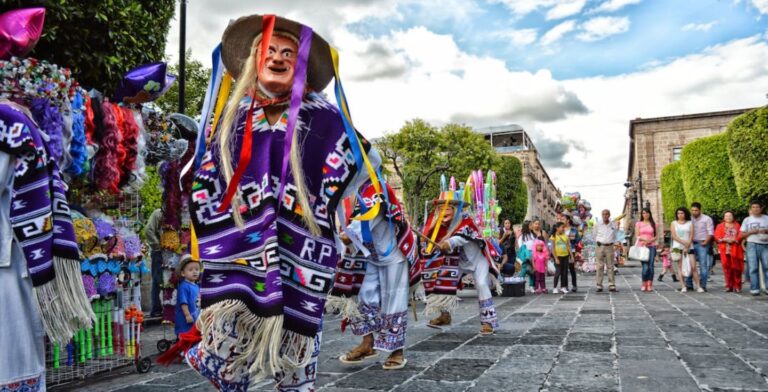
Mexico travel guide: adventure tips and more
Are you traveling to Mexico? Read tips and all the information you need to have an amazing experience during your trip....
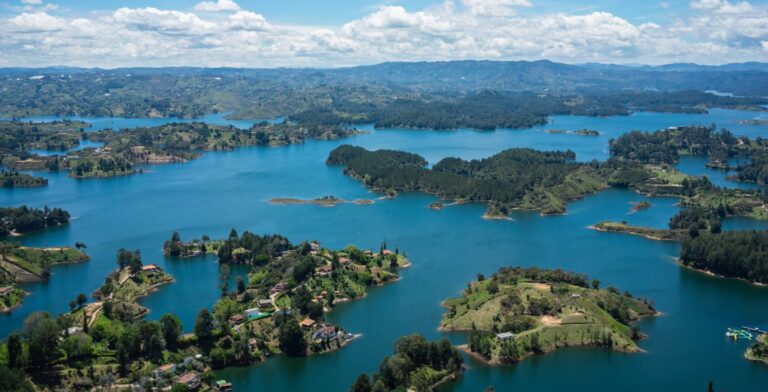
Travel guide for Colombia: Tips and unmissable destinations
Read all the information you need to travel to Colombia and have a great and unforgettable...
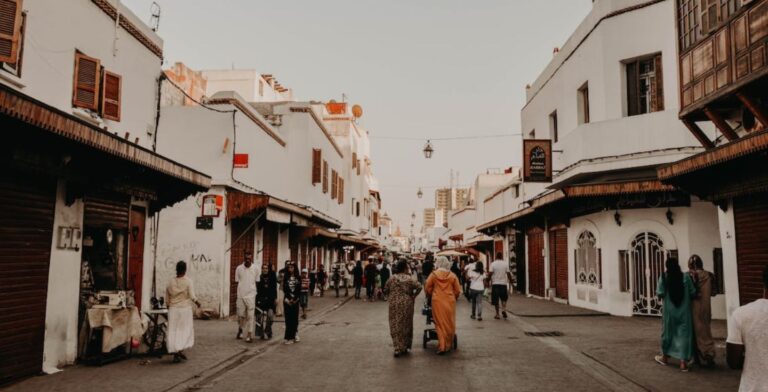
Morocco Travel Guide
Read about everything you need to know about going to Morocco in our travel guide. Learn about the things to do, stay connected and...

Cost of Traveling to Japan in 2024: Budget Guide
The cost of traveling to Japan varies depending on the activities, food, lodging, and season. They can range from $1,500 to $3,000 per person weekly....
- Privacy Overview
- Strictly Necessary Cookies
- Statistic Cookies
- Marketing Cookies
This website uses cookies so that we can provide you with the best user experience possible. Cookie information is stored in your browser and performs functions such as recognising you when you return to our website and helping our team to understand which sections of the website you find most interesting and useful.
Strictly Necessary Cookies should be enabled at all times so that we can save your preferences for cookie settings.
If you disable this cookie, we will not be able to save your preferences. This means that every time you visit this website you will need to enable or disable cookies again.
This website uses Google Analytics to collect anonymous information such as the number of visitors to the site, and the most popular pages.
Keeping this cookie enabled helps us to improve our website.
Please enable Strictly Necessary Cookies first so that we can save your preferences!
This website uses the following additional cookies:
(List the cookies that you are using on the website here.)
- Share full article
Advertisement
Supported by
On the Brazilian Coast, a Tropical Town Beloved by Artists and Makers
A guide to Paraty, on the Costa Verde, with tips on where to stay, shop and island hop from the artist Vik Muniz and four other insiders.

By Nora Walsh
T’s monthly travel series, Flocking To , highlights places you might already have on your wish list, sharing tips from frequent visitors and locals alike. Sign up here to find us in your inbox once a month, and to receive our weekly T List newsletter. Have a question? You can always reach us at [email protected] .
Roughly halfway between São Paulo and Rio de Janeiro, the coastal town of Paraty (population 45,000) isn’t the easiest place to reach. It requires a four-hour, mostly mountainous drive from either city, a 45-minute helicopter charter or arrival by sea. It’s that relative seclusion that keeps the tourist hordes and unbridled development at bay, despite the town’s obvious appeal. Set on Brazil’s Costa Verde, with mountains covered in rainforest on one side and the emerald green waters of Ilha Grande Bay on the other, Paraty (pronounced para-CHEE by locals), preserves more than 30 blocks as its historic quarter, a grid of pedestrian-only cobblestone streets lined with whitewashed 18th- and 19th-century facades, many of them remnants of the Portuguese colonial era.
Starting in the mid-1600s, the town grew prosperous as a seaport during the country’s gold rush (many of the biggest gold mines were in the neighboring inland state Minas Gerais) — and as a hub for the slave trade. African slaves not only worked in the mines but built much of the town’s early infrastructure, such as its roads. Once the gold stopped coming through Paraty for export in the early 1700s, the town continued to harvest sugar cane and produce cachaça, the national spirit, before shifting its economic focus to the coffee trade. At the end of the 19th century, Santos, 190 miles to the south, supplanted Paraty as the country’s primary coffee-exporting port, and the town began to languish. “It fell off the map,” says Luana Assunção, the owner of the Rio-based travel company Free Walker Tours. “It became isolated and poor. Many houses were abandoned.”
By the 1970s, a new highway and an influx of urban transplants had given Paraty an infusion of new life. Lured by the area’s affordability, a number of artists, designers and other creative types began renovating the old mansions and opening a handful of galleries, boutiques, cafes and small hotels, turning the long-forgotten town into an alluring vacation destination.
“I was worried that mass tourism would endanger the future of the culture and the nature in Paraty, but it didn’t happen,” says the nature photographer Dom João de Orleans e Bragança, who has been visiting Paraty since 1968 and now lives there most of the year. He credits the strict building codes for imbuing the town with a certain timeless quality, even after the pandemic when the area’s second-home owners began spending more time in Paraty. “You’ll never see a skyscraper, and we don’t have big resorts or hotels here.”
What Paraty does have is easy access to the dozens of small islands and sandy coves across the bay (local traineiras , renovated wooden fishing boats; large schooners; and speedboats are all available for visitors to rent for daylong outings), and the countless hiking trails, waterfalls and beaches that are part of the massive Serra da Bocaina National Park. Visitors can also make day trips to a handful of villages home to Indigenous and historic Black settlements that have maintained a strong cultural identity. “There’s layer upon layer here,” said Lena Santana, a Brazilian costume and fashion designer who has been living in Paraty for the last decade. “It creates a certain kind of depth that makes people want to stay.” Here, Santana and four other locals and longtime Paraty visitors share their recommendations for where to stay, eat and explore.
The Insiders
Silvia Furmanovich , a fine-jewelry designer based between São Paulo and New York City, has been traveling to Paraty every other year for the past three decades.
The artist and photographer Vik Muniz , who lives in Rio de Janeiro and New York City, has been visiting Paraty since 1999.
Diana Radomysler is a partner and director of the interiors and design department at the São Paulo-based architecture firm Studio MK27. She travels to Paraty annually with her family.
Lena Santana , who was born in Salvador, Brazil, and moved to Paraty a decade ago after 15 years in London, owns a boutique, Atelier Napele, in the historic center, and Bus Stop Paraty, a guesthouse, 12 miles outside of town in Playa Grande.
Gisela Schmitt , originally from São Paulo, is the chef and owner of Paraty’s Gastromar restaurant and a boat-catering company.
Illustrations by Richard Pedaline
“I love to stay at Casa Turquesa , built on the ruins of an 18th-century mansion in the old town. Everything in the Turquoise Suite is white and turquoise, from the fabrics to the artwork. One room has prints from the British botanical artist Margaret Mee, who spent decades traveling to the Amazon documenting flora, which have inspired my work in the past.” (Rooms from about $520 a night.) — Silvia Furmanovich
“I always suggest that friends stay at the Pousada Literária de Paraty, a cozy hotel within a cluster of historic mansions that surround a tropical garden — they return enchanted by both the hotel and its restaurant.” (Rooms from about $350 a night.) — Diana Radomysler
“The Brazilian travel company Matueté has a selection of villas. You can rent the interior designer Linda Pinto’s house in the historic quarter close to the waterfront. It has a beautiful courtyard, so the house is flooded with natural light.” (Rentals from about $1,500 a night, with a three-night minimum.) — Gisela Schmitt
Eat and Drink
“At Banana da Terra , the chef Ana Bueno cooks contemporary Caiçara [the main Indigenous community of the area] cuisine in a charming restaurant in the historic quarter. She offers things like mango and shrimp salad and a hamburger made with crab meat. After dinner, go to Gelateria Miracolo for ice cream and try the flavor made with cupuaçu, an Amazonian fruit that’s closely related to cacao.” — S.F.
“Head to Graúna [about 12 miles north of Paraty], a beautiful valley in the Atlantic Forest, for lunch at Le Gite d’Indaiatiba . The chef is like a wizard of the forest. She makes her ravioli with taioba, an edible plant from the jungle [similar to collard greens]. Call ahead and ask them to prepare the sauna, which is next to a swimmable waterfall on the property.” — G.S.
“ Fugu Japanese Food is a new restaurant that only serves fish that’s been caught fresh the same day, like sororoca [a white local fish] and prejereba [tripletail]. Don’t miss the tuna starter with locally grown shiitake mushrooms or the teishoku, a wooden box with 12 different small portions of menu items, including the day’s fresh catch. There’s also a great sake selection. For dessert, have the wasabi ice cream.” — D.R.
“Recently, one of my favorite designers from São Paulo, Flavia Aranha , opened a store in Paraty. Her pieces are timeless, produced in organic fabrics or natural fibers dyed with Brazilian plants and herbs.” — D.R.
“For handwoven baskets, go to Cestarias Regio Paraty in the historic center. They come in all sizes and are made by local communities. I love the ones made from covo, a fiber extracted from bamboo, that are used to go fishing.” — G.S.
“Visit the village of Cunha in the Paraíba Valley, where the Japanese couple Mieko and Toshiyuki Ukeseki started firing ceramics in a noborigama [a traditional Japanese wood-fired chamber kiln] in the 1970s. A small community of ceramists joined them, and you can buy their pieces at their ateliers or at the ceramics festivals that Cunha hosts throughout the year.” — L.S.
“To pick up authentic Indigenous arts and crafts, such as vases and musical instruments, go to Canoa Arte Indígena . I bought several baskets from there that now decorate my office in São Paulo.” — S.F.
“Paraty has some of the best cachaça in Brazil. My favorite brand is Cachaça Maria Izabel . [Maria Izabel] and her daughters own a sugar cane plantation in Sítio Santo Antônio, about six miles north of Paraty, where they still produce the spirit by hand. You can do a tasting at the distillery and buy bottles there, or at shops in town.” — V.M.
“The Livraria das Marés is a big-city bookstore in a small town. It’s a contemporary space designed by the architect Bel Lobo with black metal shelves and a wood-paneled floor and ceiling. There’s a delightful cafe at the back.” — D.R.
“Don’t miss Saco do Mamanguá, which is the world’s only tropical fjord. You can only get there by boat, and you’ll pass Caiçara villages along small beaches. From there, you can hike to the peak of Mamanguá’s Pão de Açúcar for dramatic views of the entire Ilha Grande Bay. Another option is to rent kayaks at one of the beaches and paddle deep into the mangroves at the very end of the fjord.” — G.S.
“ Fazenda Bananal is a great place to take children. It’s a nature preserve in the forest with a farmhouse. There are walking trails, farm animals and a restaurant called Ninho that’s absolutely incredible. Many of the ingredients come from the farm. I had the best slow-cooked pork of my life there.” — V.M.
“Visit Quilombo do Campinho [a settlement about 10 miles south of Paraty founded at the end of the 19th century by formerly enslaved people]. There’s a restaurant that serves fresh grilled fish and a shop with beautiful wooden animal sculptures, rugs made of straw, bamboo furniture and jewelry made from local tropical seeds. On the way home, stop at the village of Paraty-Mirim, where you can buy artisanal wares from the Guaraní tribe; then swim at its gorgeous beach, which is bordered by mountains and a river.” — L.S.
“One of the best ways to enjoy Paraty by sea is to book Gisela Schmitt’s Sem Pressa boat tour, which takes you to the surrounding coves and swimming spots (my favorite is Saco da Velha) while offering delicious local plates like cachaça- and beet-cured prejereba [tripletail fish], fresh oysters and mussels.” — V.M.
Practical Matters
“It’s fun to be in Paraty during one of its festivals. There’s FLIP [Festa Literária Internacional de Paraty], a large and influential literary festival [this year it will be held in October] and loads of other events throughout the town.” — L.S.
“The best time to visit is from May to August, when there’s less rain, the sky is beautiful and the sea is wonderful.” — G.S.
These interviews have been edited and condensed.
Explore T Magazine
A Forest Retreat in ‘Tokyo’s Backyard’: Here’s how the architect Terence Ngan and the interior designer Ed Ng made a home for themselves in the woods .
Artist Questionnaire: The artist Charles Gaines discussed his new work at the Freedom Monument Sculpture Park in Alabama, the development of his practice and taking drum lessons from Jimmie Smith.
Skin Care Routine for Adult Acne: Here is an expert-approved guide to the most effective products and techniques for dealing with stubborn breakouts at home.
An Antidote to Loneliness: Patrick Carroll began making textiles during lockdown . Last year, several of them appeared at a JW Anderson runway show.
The 25 Essential Italian Pasta Dishes: Two chefs, one cookbook author, a culinary historian and a food writer made a list of the country’s most delicious meals , from carbonara in Rome to ravioli in Campania.
How To Attend The Biggest Pride Event In The World
The Pride event in São Paulo, Brazil draws millions of people each year. Here's what to know and how to attend!
- Pride is a colorful celebration of love and acceptance for the LGBTQ+ community worldwide during the month of June.
- The biggest Pride event in the world is in São Paulo, Brazil, drawing around 3 million attendees and featuring a lively parade.
- São Paulo's Pride Parade is supported by the city through medical professionals, police, and funding for a safe and enjoyable event.
Is there anything more fun than Pride? If you're unfamiliar with Pride, the most important thing for you to know is that it's simply a celebration of love and acceptance and to affirm support for and with the LGBTQ+ Community. It's a colorful day that is celebrated around the world during the month of June, with multiple days of fun and festivities, and is a truly joyful event meant to spread love, joy, and community across the globe.
If you've yet to attend a Pride Event, just know that it's a space for all to come to, enjoy, be themselves, and celebrate together no matter if you're part of the community or a supporter of someone celebrating. Although Pride is celebrated around the world among millions of prideful people, there is one special place that hosts the biggest pride event in the world and has been since the early 2000s. Can you guess where it is?
You may assume it's in Los Angeles, New York, London, or maybe even Vancouver, but you'll be surprised to find out that the biggest pride event is in the fabulous city of São Paulo, Brazil , one of the most colorful and vibrant places to celebrate Pride this summer . Known for its culturally diverse city, eccentric culinary scene, unique music, and art communities, and last but not least, the home of some of the most popular soccer teams in the world. But in June, it's the birthplace of the biggest Pride Event in the world.
10 Most Colorful Places To Celebrate Pride This Summer
Welcome to the biggest pride event in the world, são paulo may be known for its epic beaches, but in june, it welcomes three million people to pride.
Also known as Parada do Orgulho LGBT de São Paulo or simply "Parada de São Paulo," the São Paulo Pride Parade began in 1997 and since then has drawn in millions of people from around the world — around 3 million — to come celebrate and enjoy one of the most colorfully festive events of the year.
- In case you were wondering, the parade is organized by the POGLBT, the Associacao da Parada do Orgulho de Gays, Lesbicas, Bissexuais e Travestis e Transexuais and has been since its foundation in 1999.
This year, the fun begins on May 30th with the LGBTQ+ Cultural Diversity Fair, until June 2nd when the Pride Parade officially begins, closing the weekend of pride and celebration.
The starting point of the parade is at Museu de Arte de Sao Paulo, in the middle of Avenida Paulista and the heart of the city of São Paulo. If you're curious, the fun typically begins around noon and ends around 10 pm. And if you're wondering about the length, the entire march is 2.6 miles long.
The Pride Parade is free, no cost of entry is required.
If you've never been to a Pride Event before, you can expect to see grand, colorful floats filled with people dancing and celebrating, cheerful attendees in the crowd marching along with the floats, and endless fun along the way. It's an event meant to be a safe space for all, no matter if you're there as part of the LGBTQ+ Community, or simply being a fantastic supporter.
Even more so, if you've yet to experience the liveliness of São Paulo, it's important you stay up to date on what to expect when visiting South America's largest city , especially during a popular event like Pride that draws large crowds.
São Paulo Prepares For Anything And Everything At Pride
The city has plenty of practice with prepping for a safe and enjoyable pride.
With any event drawing in crowds of millions of people, local and international, it's extremely important to have medical professionals close by in order to handle any situation that may pop up.
For the biggest Pride Parade in the world, the State and the City of São Paulo fully support the wonderful people participating in the parade by stationing thousands of police, a mobile police station, ambulances, nurses, doctors, and medical camps ready for whoever needs them.
A beautiful aspect of this parade, other than the millions of people, is the fact that it's supported by the mayor and Governor of São Paulo, so much so that businesses and business professionals help fund the event and allow for millions of people from around the world and every corner of the planet to fly to Brazil and celebrate together, hand in hand, year after year.
Portuguese is the official language spoken in São Paulo, so even though many visitors and locals will know and understand English, it's important to have a few phrases ready in Portuguese to help get you around.
There you have it, everything you need to know to visit São Paulo, Brazil this June for the biggest Pride Event in the world that brings in 3 million+ visitors from every corner of the earth.
If you can't make it to Brazil, there are still plenty of colorful Pride Parades to attend around the world , that are probably near you, and vastly underrated.
And don't forget, even if you're flying in for the joy of Pride, there are still so many things to see and enjoy in the adventurous city of São Paulo that every visitor must get a chance to experience.
Have you ever been to a Pride event? Share with us in the comments!
- Best overall
- Best for exotic trips
- Best for trip interruption
- Best for medical-only coverage
- Best for family coverage
- Best for long trips
- Why You Should Trust Us
Best International Travel Insurance for June 2024
Affiliate links for the products on this page are from partners that compensate us (see our advertiser disclosure with our list of partners for more details). However, our opinions are our own. See how we rate insurance products to write unbiased product reviews.
If you're planning your next vacation or trip out of the country, be sure to factor in travel insurance. Unexpected medical emergencies when traveling can drain your bank account, especially when you're traveling internationally. The best travel insurance companies for international travel can step in to provide you with peace of mind and financial protection while you're abroad.
Best International Travel Insurance
- Best overall: Allianz Travel Insurance
- Best for exotic travel: World Nomads Travel Insurance
- Best for trip interruption coverage: C&F Travel Insured
Best for medical-only coverage: GeoBlue Travel Insurance
- Best for families: Travelex Travel Insurance
- Best for long-term travel: Seven Corners Travel Insurance
How we rate the best international travel insurance »
Compare the Best International Travel Insurance Companies
As a general rule, the most important coverage to have in a foreign country is travel medical insurance , as most US health insurance policies don't cover you while you're abroad. Without travel medical coverage, a medical emergency in a foreign country can cost you. You'll want trip cancellation and interruption coverage if your trip is particularly expensive. And if you're traveling for an extended period of time, you'll want to ensure that your policy is extendable.
Here are our picks for the best travel insurance companies for international travel.
Best overall: Allianz
- Check mark icon A check mark. It indicates a confirmation of your intended interaction. Good option for frequent travelers thanks to its annual multi-trip policies
- Check mark icon A check mark. It indicates a confirmation of your intended interaction. Doesn't increase premium for trips longer than 30 days, meaning it could be one of the more affordable options for a long trip
- Check mark icon A check mark. It indicates a confirmation of your intended interaction. Some plans include free coverage for children 17 and under
- Check mark icon A check mark. It indicates a confirmation of your intended interaction. Concierge included with some plans
- con icon Two crossed lines that form an 'X'. Coverage for medical emergency is lower than some competitors' policies
- con icon Two crossed lines that form an 'X'. Plans don't include coverage contact sports and high-altitude activities
- Single and multi-trip plans available
- Trip cancellation and interruption coverage starting at up to $10,000 (higher limits with more expensive plans)
- Preexisting medical condition coverage available with some plans
Allianz Travel Insurance offers the ultimate customizable coverage for international trips, whether you're a frequent jetsetter or an occasional traveler. You can choose from an a la carte of single or multi-trip plans, as well as add-ons, including rental car damage, cancel for any reason (CFAR) , adventure sport, and business travel coverage. And with affordable pricing compared to competitors, Allianz is a budget-friendly choice for your international travel insurance needs.
The icing on the cake is Allyz TravelSmart, Allianz's highly-rated mobile app, which has an average rating of 4.4 out of five stars on the Google Play store across over 2,600 reviews and 4.8 out of five stars from over 22,000 reviews on the Apple app store. So, you can rest easy knowing that you can access your policy and file claims anywhere in the world without a hassle.
Read our Allianz Travel Insurance review here.
Best for exotic trips: World Nomads
- Check mark icon A check mark. It indicates a confirmation of your intended interaction. Coverage for 200+ activities like skiing, surfing, and rock climbing
- Check mark icon A check mark. It indicates a confirmation of your intended interaction. Only two plans to choose from, making it simple to find the right option
- Check mark icon A check mark. It indicates a confirmation of your intended interaction. You can purchase coverage even after your trip has started
- con icon Two crossed lines that form an 'X'. If your trip costs more than $10,000, you may want to choose other insurance because trip protection is capped at up to $10,000 (for the Explorer plan)
- con icon Two crossed lines that form an 'X'. Doesn't offer coverage for travelers older than 70
- con icon Two crossed lines that form an 'X'. No Cancel for Any Reason (CFAR) option
- Coverage for 150+ activities and sports
- 2 plans: Standard and Explorer
- Trip protection for up to $10,000
- Emergency medical insurance of up to $100,000
- Emergency evacuation coverage for up to $500,000
- Coverage to protect your items (up to $3,000)
World Nomads Travel Insurance offers coverage for over 150 specific activities, so you can focus on the adventure without worrying about gaps in your coverage.
You can select its budget-friendly standard plan, starting at $79. Or if you're an adrenaline junkie seeking more thrills, you can opt for the World Nomads' Explorer plan for $120, which includes extra sports like skydiving, scuba diving, and heli-skiing. And World Nomads offers 24/7 assistance, so you can confidently travel abroad, knowing that help is just a phone call away.
Read our World Nomads Travel Insurance review here.
Best for trip interruption: C&F Travel Insured
- Check mark icon A check mark. It indicates a confirmation of your intended interaction. Offers 2 major plans including CFAR coverage on the more expensive option
- Check mark icon A check mark. It indicates a confirmation of your intended interaction. Cancellation for job loss included as a covered reason for trip cancellation/interruption (does not require CFAR coverage to qualify)
- Check mark icon A check mark. It indicates a confirmation of your intended interaction. Frequent traveler reward included in both policies
- Check mark icon A check mark. It indicates a confirmation of your intended interaction. Up to $1 million in medical evacuation coverage available
- con icon Two crossed lines that form an 'X'. Medical coverage is only $100,000
- con icon Two crossed lines that form an 'X'. Reviews on claims processing indicate ongoing issues
- C&F's Travel Insured policies allow travelers customize travel insurance to fit their specific needs. Frequent travelers may benefit from purchasing an annual travel insurance plan, then adding on CFAR coverage for any portions of travel that may incur greater risk.
C&F Travel Insured offers 100% coverage for trip cancellation, up to 150% for trip interruption, and reimbursement for up to 75% of your non-refundable travel costs with select plans. This means you don't have to worry about losing your hard-earned money on non-refundable travel costs if your trip ends prematurely.
Travel Insured also stands out for its extensive "reasons for cancellation" coverage. Unlike many insurers, the company covers hurricane warnings from the National Oceanic and Atmospheric Administration (NOAA).
Read our C&F Travel Insured review here.
- Check mark icon A check mark. It indicates a confirmation of your intended interaction. A subsidary of Blue Cross Blue Shield
- Check mark icon A check mark. It indicates a confirmation of your intended interaction. Offers strong medical plans as long as you have a regular health insurance plan, but it doesn't have to be through Blue Cross
- Check mark icon A check mark. It indicates a confirmation of your intended interaction. Offers long-term and multi-trip travel protection
- con icon Two crossed lines that form an 'X'. Multiple complaints about claims not being paid or being denied
- con icon Two crossed lines that form an 'X'. Does not provide some of the more comprehensive coverage like CFAR insurance
- con icon Two crossed lines that form an 'X'. Buyers who do get claims paid may need to file multiple claim forms
GeoBlue Travel Insurance offers policies that covers emergency medical treatments when you're abroad. While GeoBlue lacks trip cancellation coverage, that allows it to charge lower premiums than the other companies on this list.
GeoBlue plans can cover medical expenses up to $1 million with several multi-trip annual plans available. It offers coinsurance plans for trips within the U.S. and 100% coverage for international trips. It also has a network of clinics in 180 countries, streamlining the claims process. It's worth noting that coverage for pre-existing conditions comes with additional costs.
Read our GeoBlue Travel Insurance review here.
Best for family coverage: Travelex Travel Insurance
Trip cancellation coverage for up to 100% of the trip cost and trip interruption coverage for up to 150% of the trip cost
- Check mark icon A check mark. It indicates a confirmation of your intended interaction. Options to cover sports equipment
- Check mark icon A check mark. It indicates a confirmation of your intended interaction. Option to increase medical coverage
- Check mark icon A check mark. It indicates a confirmation of your intended interaction. Can cancel up to 48 hours before travel when CFAR option is purchased
- Check mark icon A check mark. It indicates a confirmation of your intended interaction. Affordable coverage for budget-conscious travelers
- Check mark icon A check mark. It indicates a confirmation of your intended interaction. Includes generous baggage delay, loss and trip delay coverage
- Check mark icon A check mark. It indicates a confirmation of your intended interaction. Optional "adventure sports" bundle available for riskier activities
- con icon Two crossed lines that form an 'X'. Only two insurance plans to choose from
- con icon Two crossed lines that form an 'X'. Medical coverage maximum is low at up to $50,000 per person
- con icon Two crossed lines that form an 'X'. Pricier than some competitors with lower coverage ceilings
- con icon Two crossed lines that form an 'X'. Some competitors offer higher medical emergency coverage
Travelex travel insurance is one of the largest travel insurance providers in the US providing domestic and international coverage options. It offers a basic, select, and America option. Read on to learn more.
- Optional CFAR insurance available with the Travel Select plan
- Trip delay insurance starting at $500 with the Travel Basic plan
- Emergency medical and dental coverage starting at $15,000
Travelex Travel Insurance offers coverage for your whole crew, perfect for when you're planning a family trip. Its family plan insures all your children 17 and under at no additional cost. The travel insurance provider also offers add-ons like adventure sports and car rental collision coverage to protect your family under any circumstance. Got pets? With Travelex's Travel Select plan, you can also get coverage for your furry friend's emergency medical and transportation expenses.
Read our Travelex Travel Insurance review here.
Best for long trips: Seven Corners
- Check mark icon A check mark. It indicates a confirmation of your intended interaction. Diverse coverage options such as CFAR, optional sports equipment coverage, etc.
- Check mark icon A check mark. It indicates a confirmation of your intended interaction. Available in all 50 states
- con icon Two crossed lines that form an 'X'. Prices are higher than many competitors
- con icon Two crossed lines that form an 'X'. Reviews around claims processing are mixed
- Trip cancellation insurance of up to 100% of the trip cost
- Trip interruption insurance of up to 150% of the trip cost
- Cancel for any reason (CFAR) insurance available
Seven Corners Travel Insurance offers specialized coverage that the standard short-term travel insurance policy won't provide, which is helpful if you're embarking on a long-term trip. You can choose from several plans, including the Annual Multi-Trip plan, which provides medical coverage for multiple international trips for up to 364 days. This policy also offers COVID-19 medical and evacuation coverage up to $1 million.
You also get the added benefit of incidental expense coverage. This policy will cover remote health-related services and information, treatment of injury or illness, and live consultations via telecommunication.
Read our Seven Corners Travel Insurance review here.
How to Find the Right International Travel Insurance Company
Different travelers and trips require different types of insurance coverage. So, consider these tips if you're in the market to insure your trip.
Determine your needs
Your needs for travel insurance will depend on the type of trip you're taking. You'll need to consider your destination and what you'll be doing there, either business, leisure, or adventure traveling. Policies covering adventure sports and activities will cost more. Longer, more expensive trips will also cost more.
Research the reputation of the company
When researching a company, you'll want to closely review the description of services. You'll want to see how claims are handled, any exceptions, and limitations.
You'll also want to look at the company's customer reviews on sites like Trustpilot, BBB, and Squaremouth, as this will provide insight on the quality of customer service and the claims process. You should also take note of whether companies respond to customer reviews.
Compare prices
You can get quotes through a company's website or travel insurance aggregators like InsureMyTrip and VisitorsCoverage. You'll need to be prepared to provide the following information about your trip:
- Trip destination(s)
- Travel dates
- Number of travelers
- Traveler(s) age/birthday
- State of residence
- Total trip cost
For companies that offer travel medical insurance, you'll also want to play around with the deductible options, as they can affect your policy premium.
Understanding International Travel Insurance Coverage Options
Travel insurance can be confusing, but we're here to simplify it for you. We'll break down the industry's jargon to help you understand what travel insurance covers to help you decide what your policy needs. Bear in mind that exclusions and limitations for your age and destination may apply.
Finding the Best Price for International Travel Insurance
Your policy cost will depend on several factors, such as the length of your trip, destination, coverage limits, and age. Typically, a comprehensive policy includes travel cancellation coverage costs between 5% and 10% of your total trip cost.
If you're planning an international trip that costs $4,500, you can expect to pay anywhere from $225 to $450 for your policy. Comparing quotes from multiple providers can help you find a budget-friendly travel insurance policy that meets your needs.
Why You Should Trust Us: How We Reviewed International Travel Insurance Companies
We ranked and assigned superlatives to the best travel insurance companies based on our insurance rating methodology . It focuses on several key factors, including:
- Policy types: We analyzed company offerings such as coverage levels, exclusions, and policy upgrades, taking note of providers that offer a range of travel-related issues beyond the standard coverages.
- Affordability: We recognize that cheap premiums don't necessarily equate to sufficient coverage. So, we seek providers that offer competitive rates with comprehensive policies and quality customer service. We also call out any discounts or special offers available.
- Flexibility: Travel insurance isn't one-size-fits-all. We highlight providers that offer a wide array of coverage options, including single-trip, multi-trip, and long-term policies.
- Claims handling: The claims process should be pain-free for policyholders. We seek providers that offer a streamlined process via online claims filing and a track record of handling claims fairly and efficiently.
- Quality customer service: Good customer service is as important as affordability and flexibility. We highlight companies that offer 24/7 assistance and have a strong record of customer service responsiveness.
We consult user feedback and reviews to determine how each company fares in each category. We also check the provider's financial rating and volume of complaints via third-party rating agencies.
Read more about how Business Insider rates insurance products here.
International Travel Insurance FAQs
The best insurance policy depends on your individual situation, including your destination and budget. However, popular options include Allianz Travel Insurance, World Nomads, and Travel Guard.
You should pay attention to any limitations regarding covered cancellations, pre-existing conditions, and adventure activities. For example, if you're worried you may have to cancel a trip for work reasons, ensure that you've worked at your company long enough to qualify for cancellation coverage, as that is a condition with some insurers. You should also see if your destination has any travel advisories, as that can affect your policy.
Typically, your regular health insurance won't cover you out of the country, so you'll want to make sure your travel insurance has adequate medical emergency coverage. Depending on your travel plans, you may want to purchase add-ons, such as adventure sports coverage, if you're planning on doing anything adventurous like bungee jumping.
Travel insurance is worth the price for international travel because they're generally more expensive, so you have more to lose. Additionally, your regular health insurance won't cover you in other countries, so without travel insurance, you'll end up paying out of pocket for any emergency medical care you receive out of the US.
You should purchase travel insurance as soon as possible after making payment on your trip. This makes you eligible for add-ons like coverage for pre-existing conditions and CFAR. It also mitigates the chance of any losses in the days leading up to your trip.
- Main content
- Logout Login
- Adventure Holidays
- Weekend Getaways
- Driving Holidays
- Travel News
A guide to the world’s 6 best and biggest wildlife safaris!
TRAVEL NEWS , WORLD Updated : May 31, 2024, 16:42 IST

Wildlife safaris not only offer unparalleled adventure, but also allow one to experience intimate encounters with the planet's most extraordinary wildlife and terrains. Across the globe, there are several destinations renowned for their exceptional safari experiences, each offering unique landscapes and diverse wildlife. If you also love this activity, here are some of the world's biggest wildlife safari destinations to bookmark.
Kruger National Park, South Africa
Kruger National Park stands as an icon in the world of wildlife safaris. Spanning nearly two million hectares in northeastern South Africa, Kruger is home to an extraordinary variety of wildlife, including the famed Big Five—lion, elephant, buffalo, leopard, and rhinoceros. Visitors can explore the park through guided game drives, walking safaris, or self-drives, immersing themselves in the breathtaking landscapes and abundant wildlife sightings.
Maasai Mara National Reserve, Kenya
The Maasai Mara National Reserve in Kenya is renowned for the yearly Great Migration, during which millions of wildebeest, zebras, and other herbivores brave the Mara River in pursuit of better grazing lands. Beyond this extraordinary event, the Maasai Mara boasts exceptional game viewing opportunities year-round, showcasing lions, cheetahs, elephants, and giraffes freely roaming its expansive plains. For a distinctive experience, hot air balloon safaris offer breathtaking vistas of the savannah, brimming with wildlife.
Serengeti National Park, Tanzania
Adjacent to the Maasai Mara, Tanzania's Serengeti National Park is another hotspot for witnessing the Great Migration. This expansive savannah landscape is home to an incredible diversity of wildlife, including large herds of plains game and predators such as lions, leopards, and hyenas. Visitors can enjoy game drives, guided walks, and cultural experiences with the Maasai people, adding depth to their safari adventure.
Chobe National Park, Botswana
Chobe National Park in Botswana is renowned for its massive elephant population, and also serves as the home to the highest concentrations of these majestic creatures in Africa. The Chobe Riverfront offers spectacular game viewing opportunities, with elephants, hippos, crocodiles, and various bird species congregating along the water's edge. Boat safaris provide a unique perspective, allowing visitors to observe wildlife from the tranquility of the river.
Ranthambore National Park, India
Ranthambore National Park is one of India's premier tiger reserves, offering a chance to encounter these elusive big cats in their natural habitat. Set amid the Aravali and Vindhya mountain ranges, Ranthambore is also home to leopards, sloth bears, and a diverse array of birdlife. Jeep safaris and guided nature walks offer opportunities for up-close wildlife encounters while exploring the park's picturesque landscapes.
Yala National Park, Sri Lanka
Yala National Park stands as Sri Lanka's top wildlife sanctuary, celebrated for its thriving leopard population. Situated in the southeastern part of the island, Yala boasts a diverse array of inhabitants, from elephants and sloth bears to crocodiles and a plethora of bird species. Its diverse terrain, encompassing scrublands, forests, and coastal lagoons, nurtures a rich biodiversity. Safari adventures present the chance to encounter elusive leopards and other iconic creatures against a backdrop of stunning landscapes. With its blend of natural splendor and abundant wildlife, Yala National Park promises an unforgettable safari adventure in Sri Lanka.
Visual Stories

8 theme parks in the world to take your kids to this summer vacation

10 longest rivers in the world

Ancient man-made places that are still a mystery to us

10 least visited countries in the world for offbeat travellers

Mesmerising waterfalls in India for your summer bucket list

Top cities globally with the worst traffic; two Indian cities also in the list

10 underrated European cities that deserve to be on every traveller’s bucket list!

Top 10 countries with biggest forests; India on the list

Fascinating caves to explore in India

7 oldest trees on Earth and where to spot them
Join Us On Facebook Close
Poll of the day, which of these is one of earth's oldest geographical feature, comments (0).

Refrain from posting comments that are obscene, defamatory or inflammatory, and do not indulge in personal attacks, name calling or inciting hatred against any community. Help us delete comments that do not follow these guidelines by marking them offensive . Let's work together to keep the conversation civil.
Comments ( ) Sort: Newest UpVoted Oldest Discussed Down Voted closecomments

SIGN IN WITH
Or post without registration, trending stories.

- When is the best time to visit Dharamshala?

- Jaisalmer, a majestic fusion of forts, fort hotels, and all things luxurious

- Mana, Uttarakhand: A look into the First Indian Village

- How to reach Kedarnath from Delhi?

Forts in India that are also UNESCO World Heritage Sites

Delhi gets its first-ever railway coach restaurant at New Delhi Railway Station

Any plans to visit Nagpur? The city boils at 56°C amid heatwave

Most glamorous casino cities in the world to try your luck at

All about Vivekananda Memorial Hall where PM Modi is meditating
From around the web, popular galleries.

Exploring the wildlife: 5 best zoos to visit in India with kids

Follow us on
Latest news.
- 5 picture-perfect beaches in Bali to strike Mouni Roy-inspired poses
Congratulations!
You have been successfully added to the mailing list of Times of India Travel. To complete the subscription process, kindly open your inbox and click on the confirmation link which has been emailed to you.
Share with friends
Thank You for sharing! Your friend will receive the article link on email mentioned.
- (For more than one recipient, type addresses separated by commas)
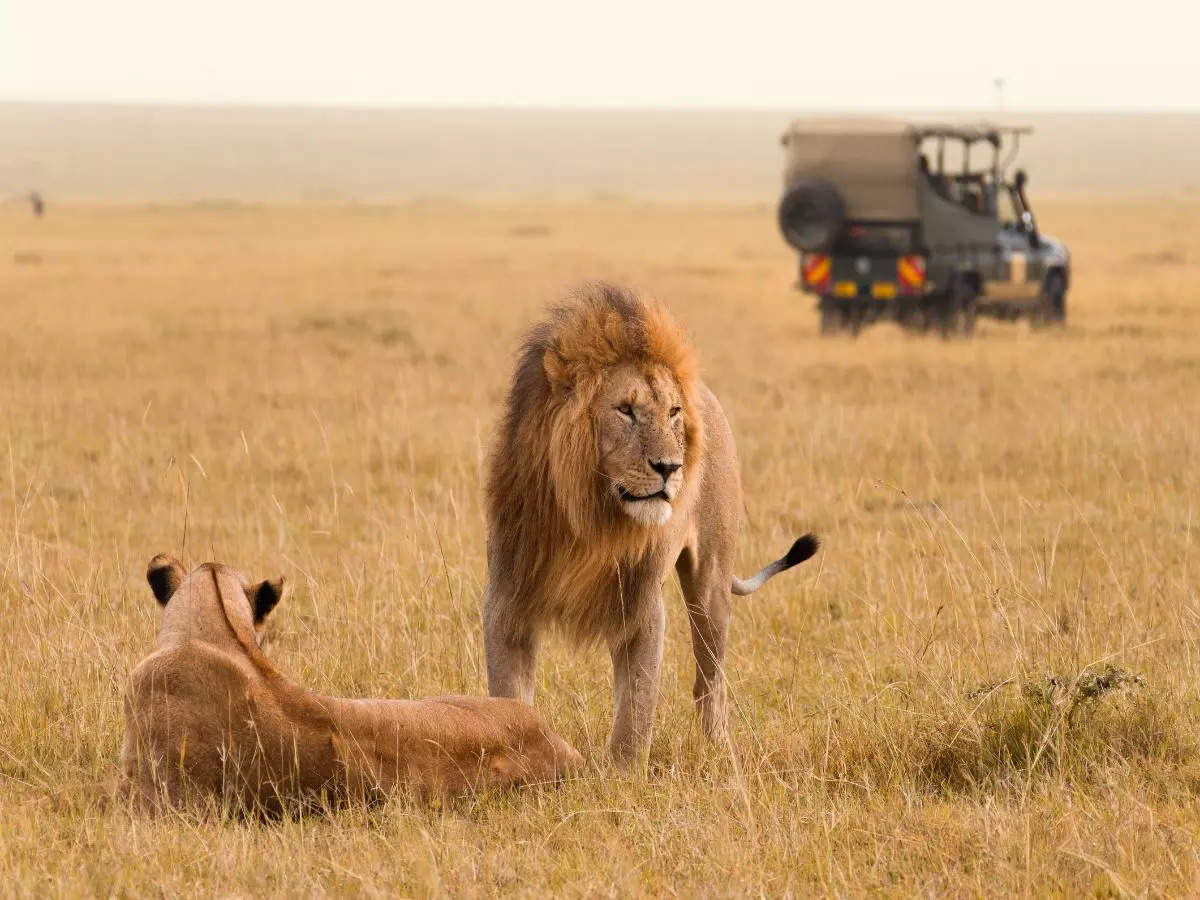
Wildlife safaris not only offer unparalleled adventure, but also allow one to experience intimate encounters with the planet's most extraordinary wildlife and terrains. Across the globe, there are s...


10 natural wonders of the world actually worth visiting, according to travel reviews
A new study looked at unique natural wonders you can’t find anywhere else in some of the most extraordinary places on the planet to rank 10 that are “actually worth a visit.”
Titan Travel — a travel agency that offers escorted tours across the globe — looked into the popularity of world-famous natural wonders on Instagram and TikTok, as well as Google search volumes and Tripadvisor to “reveal which natural wonders of the world are the best,” the company said. Two natural wonders in the United States made the list.
“While plenty of countries offer spectacular man-made sights like the Egyptian Pyramids, Machu Picchu or the Great Wall of China, it's the natural wonders that only a few people will ever get to see in their life that truly fill us with awe,” the company stated.
Start the day smarter. Get all the news you need in your inbox each morning.
Seven world wonders in less than a week: Man sees The Great Wall, Taj Mahal and more to set new record
Top 10 best natural wonders of the world
1. arches national park, united states.
- 2.4M Google searches / 61.7M Tik Tok views / 663.8K Instagram posts
- 87.57% “excellent” reviews / 0.25% “terrible” reviews
- 8.29/10 “wonder” score
2. Iguazu Falls, Brazil
- 2.5M Google searches / 44.8M Tik Tok views / 296.7K Instagram posts
- 90.73% “excellent” reviews / 0.11% “terrible” reviews
- 8.19/10 “wonder” score
3. Victoria Falls, Zimbabwe
- 2.6M Google searches / 63.9M Tik Tok views / 318.5K Instagram posts
- 86.57% “excellent” reviews / 0.22% “terrible” reviews
- 8.14/10 “wonder” score
4. Grand Canyon, United States
- 682.0K Google searches / 568.9M Tik Tok views / 4.2M Instagram posts
- 89.99% “excellent” reviews / 0.60% “terrible” reviews
- 7.91/10 “wonder” score
5. Table Mountain, South Africa
- 1.4M Google searches / 44.5M Tik Tok views / 1.3M Instagram posts
- 81.83% “excellent” reviews / 0.26% “terrible” reviews
- 7.67/10 “wonder” score
6. Matterhorn, Switzerland
- 162.6K Google searches / 137.0M Tik Tok views / 969.7K Instagram posts
- 91.39% “excellent” reviews / 0.43% “terrible” reviews
- 7.24/10 “wonder” score
The most 'beautiful' sights in the US? This study of travel reviews shows us.
7. Mount Everest, Nepal
- 13.3M Google searches / 638.2M Tik Tok views /222.7K Instagram posts
- 88.68% “excellent” reviews / 1.62% “terrible” reviews
- 7.14/10 “wonder” score
8. Great Barrier Reef, Australia
- 4.0M Google searches / 164.1M Tik Tok views / 989.0K Instagram posts
- 77.44% “excellent” reviews / 2.44% “terrible” reviews
- 6.62/10 “wonder” score
9. Cliffs of Moher, Ireland
- 3.0M Google searches / 61.3M Tik Tok views / 693.8K Instagram posts
- 76.85% “excellent” reviews / 1.29% “terrible” reviews
- 6.53/10 “wonder” score
10. Angel Falls, Venezuela
- 1.6M Google searches / 20.2M Tik Tok views / 34.1K Instagram posts
- 91.03% “excellent” reviews / 0.28% “terrible” reviews
- 6.52/10 “wonder” score
10. Milford Sound, New Zealand
- 1.3M Google searches / 17.0M Tik Tok views / 426.3K Instagram posts
- 79.72% “excellent” reviews / 0.26% “terrible” reviews
What are the seven natural wonders of the world?
In 1997, CNN released a "Seven Natural Wonders of the World" list, which comprises geological, aquatic and astrophysical phenomena, in collaboration with the Seven Natural Wonders organization. Dispersed throughout five of the seven continents, these wonders are comparable in scale, but vary in accessibility and tourism infrastructure.
- Mount Everest
- Paricutin Volcano
- The Grand Canyon
- Victoria Falls
- The Harbor Of Rio de Janeiro
- Great Barrier Reef
- Northern Lights
This article originally appeared on USA TODAY: 10 natural wonders of the world actually worth visiting, according to travel reviews

- Motorcycles
- Car of the Month
- Destinations
- Men’s Fashion
- Watch Collector
- Art & Collectibles
- Vacation Homes
- Celebrity Homes
- New Construction
- Home Design
- Electronics
- Fine Dining
- Les Marquables de Martell
- Mira Villas
- One&Only
- Panther National
- Reynolds Lake Oconee
- Saratoga Spring Water
- Wynn Las Vegas
- 672 Wine Club
- Sports & Leisure
- Health & Wellness
- Best of the Best
- The Ultimate Gift Guide
This Luxe New Cruise Will Stop in 80 Destinations Around the World, From Fiji to Norway
Silversea's 149-day journey will begin in los angeles on january 8, 2027., rachel cormack.
Digital Editor
Rachel Cormack's Most Recent Stories
- Forget a Nature Walk. You Can Dig for Dinosaur Fossils at This Luxe Hotel in Montana.
- This New 157-Foot Superyacht Blends Long-Range Exploration With 5-Star Luxury
- John Lennon’s ‘Help!’ Guitar Just Sold for a Record $2.9 Million at Auction
- Share This Article

One of the smallest cruise ships in Silversea ’s fleet will carry out the line’s biggest global voyage.
Related Stories
How soaring u.s. hotel rates are making dallas a luxury travel hot spot, brussels and berlin are two of this summer’s travel hot spots—here’s why.

“Garnered over 30 years of operations, our destination expertise will enable our guests to discover the very best experiences in ultra-luxury cruise travel,” Silversea president Bert Hernandez said in a statement.

Travelers will then cruise the Indian Ocean, visiting Bali, Semarang, Singapore, Colombo, the Maldives, Seychelles, Reunion, and Cape Town, to name but a few notable destinations. Highlights of this leg include a visit to the Great Barrier Reef, a sunset river cruise to Victoria Falls, a safari experience in South Africa, and a trip to the Vallée de Mai Nature Reserve on the island of Praslin.

Silversea says the accommodation in port has been selected to enhance the experience in each destination, with stays in destinations such as Honolulu, Cairns, Bordeaux, and more. You’ll also spend longer in port than any other World Cruise. Ship life won’t be bad, either. Guests can indulge in soothing wellness treatments and moreish culinary experiences as they discover the world.
Silversea will open an exclusive pre-sale for the Three Oceans World Cruise to Venetian Society members on June 20, while general sales will open on June 27 (with quotes available upon request).
Rachel Cormack is a digital editor at Robb Report. She cut her teeth writing for HuffPost, Concrete Playground, and several other online publications in Australia, before moving to New York at the…
Read More On:
- Cruises/Yacht Charter
- Silversea Cruises
More Destinations

Athens Is Bumping. Here’s Where to Stay and Play This Summer.

Meet Vijay Kumawat, the Only Private Guide in India’s Most Renowned Tiger Sanctuary

A Week of Auto Tradition
AUG 14 - 19 Behind-the-scenes access to a remarkable week honoring automotive brilliance.
Give the Gift of Luxury
Latest Galleries in Destinations

Kalmar Beyond Adventure’s Porsche Safari in Photos

Oceaya in Photos
More from our brands, angelina jolie and daughter vivienne edge up tailored dressing for ‘reefer madness: the musical’ opening night with kristen bell and more, mlb marketing effort celebrates baseball’s latino stars, fans, ‘the great lillian hall’ review: jessica lange is grand as a legendary stage actress confronting dementia, pro-gaza protestors stage action at brooklyn museum, calling for divestment from israel, the best yoga mats for any practice, according to instructors.

IMAGES
VIDEO
COMMENTS
Brazil travel guide. About Brazil. From the jungle calls of the Amazon to the thong-clad crowds of Copacabana beach, Brazil is an intoxicating mix of the big, the bold and the beautiful, perennially one of the world's favourite destinations. ... The World Travel Guide (WTG) is the flagship digital consumer brand within the Columbus Travel ...
South America. One of the world's most captivating places, Brazil is a country of powdery white-sand beaches, verdant rainforests and wild, rhythm-filled metropolises. Best Time to Visit. Best Places to Visit. Attractions.
Next up, we'll head to the lively city of Rio de Janeiro, home of the legendary Copacabana, Botafogo and Flamengo beaches, and of course, Sugar Loaf Mountain and the iconic Christ the Redeemer statue. view trip ⤍. 10 days / from1700 USD. Blissful Brazil.
A tropical wonderland. A visit to Brazil usually begins in Rio de Janeiro, one of the world's most vibrant urban landscapes, where dramatic, rainforest-crowned mountaintops surround a city nestled picturesquely between jungle and sea. The Amazon region - and its namesake river - are home to the planet's greatest collection of plants and ...
Brazil Travel Guide. Your complete Brazil travel guide, with our tips, ideas on things to do, and best things to see in Brazil. Great for first-time travelers. Brazil is the largest country in South America and a top tourist destination. In fact, Brazil has its own Ministry of Tourism, which ensures touring is as easy as possible for visitors.
Get information on Brazil Travel Guide - Expert Picks for your Vacation hotels, restaurants, entertainment, shopping, sightseeing, and activities. Read the Fodor's reviews, or post your own.
Brazil is a country located in South America. Brasilia is the capital and it is a country known for its natural wonders, culture, architecture, and diversity. Our Brazil travel guide is here to help you see the best it offers. Brazil eluded us for some time before we finally made a visit.
Brazil travel guide. Brazil is a pretty large country. We have five regions and 26 states spreading across four time zones. From rainforests with unique wildlife to concrete jungles and untouched beaches, we have them all. And because Brazil is so vast, the five regions are very different from each other.
Winter in Brazil lasts from May to September, but no matter where in Brazil you are visiting, temperatures won't drop below 60 F. It's one of the best times to go sightseeing and hiking in cities like Rio, thanks to plenty of sunshine and cooler temps. During the spring and summer months, November to March, temperatures can get up to 120 F ...
The largest country in South America is home to almost 2 million square miles of lush rainforest, the famous Christ the Redeemer statue, and arguably the most passionate soccer fans in the world—we'll show you how to enjoy it all. Campeche Island Off the Coast of Brazil. Morro de São Paulo Travel Guide. Sugarloaf Mountain Cable Car in Rio de ...
Brazil: A Comprehensive Travel Guide for Adventurous Souls. Dive into a nation where the spirit of samba dances through bustling cities, untouched rainforests, and sun-kissed beaches. Brazil, South America's largest country, offers a vibrant tapestry of cultures, landscapes, and experiences. ... Beaches: Copacabana and Ipanema are world ...
Brazil Travel Guide. The country of Brazil is a tropical paradise, home to stretches of rainforest, islands with tropical beaches, and endless rivers. Hang gliding, surfing, sailing and fishing are popular activities with excellent opportunities for rock climbing and hiking. Rio de Janeiro has so much to see and do from museums, exotic parks ...
Visit the 60,000-acre Parque Nacional de Brasilia and walk the trails between tall Cerrado trees while looking for wildlife like anteaters and pampas deer. 4. Explore the Pantanal. Located in Western Brazil, the Pantanal is the largest wetland in the world, stretching into parts of Bolivia and Paraguay.
Missions are now a UNESCO World Heritage Site. Read more: Go on the Iguassu Falls Tour - And Don't Forget the Jesuit Missions! THE NATURAL HIGHLIGHTS OF BRAZIL The Essential BRAZIL TRAVEL GUIDE 5 ... Read more: The Essential BRAZIL TRAVEL GUIDE. THE BEST BEACHES OF BRAZIL. w w w . S o u t h A m e r i c a . t r a v e l
1. Escape to the Rainforest(s) - There's Three! First on our list of things to do in Brazil is escape to the rainforest! Approximately 60% of Brazil is forested with three rainforests, the Amazon, the Atlantic, and the Tijuca forest along the mountains of Rio de Janeiro. Travel through the Atlantic Rainforest via a vintage train high above the trees, enjoying endless views along your journey.
Underpinning this natural beauty is the awe-inspiring Amazon river and rainforest. Home to more than 390 billion trees and covering more than 8 million sq/km, the Amazon Basin contains more than 60% of the world's remaining rainforests, with half of this lying in Brazil. Visitors to the Amazon region can encounter some of Brazil's most ...
Brazil Travel Guide. 18 Top-Rated Tourist Attractions in Brazil. 19 Top-Rated Tourist Attractions in Rio de Janeiro. ... Examining these times of fast-moving changes in society, technology, and the physical world, the museum prompts viewers to consider various paths into the future, and how each opens up based on the choices made every day as ...
Places to visit in Brazil. In the north and northeast, colonial monuments dot the state capitals, most of which are beside the sea. Salvador and Recife offer the best combination of beach and history.. The succession of beautiful beaches continues south to the all-time leading beach city of the Americas, Rio de Janeiro.By contrast, São Paulo is the most dynamic city in South America.
BRAZIL travel guide & TRULY LIFETIME HOLIDAYS. Brazil offers excellent and unique travel features. Brazil has the world's largest rainforest and river (the Amazon), the most spectacular waterfalls of the world (Iguassu), the greatest American concentration of wildlife (the Pantanal), the world's longest stretch of tropical beaches and the most popular street festival (the Brazilian Carnival).
Brazil is a nature lover's paradise, boasting unparalleled biodiversity and stunning landscapes. The Amazon Rainforest, the world's largest tropical rainforest, is a sanctuary for countless species, from jaguars and macaws to vibrant poison dart frogs. The Pantanal, the world's largest tropical wetland, is an incredible birdwatching ...
Rio de Janeiro got its close-up to the world when it hosted the Olympics in 2016, and Rio's beaches and legendary nightlife make for a blissfully hedonistic vacation. ... Your Sustainable Travel Guide to the Wild and Remote Brazil Atlantic Forest. Brazil Galleries. Galleries. 15 Stunning Natural Areas in Brazil. Galleries. 11 Most Incredible ...
7. Stay Connected and Informed. Having a reliable internet connection during your trip to Brazil is crucial for staying connected and informed. With an internet data plan, you can enjoy the convenience of unlimited internet access, ensuring you have vital information and communication at your fingertips.
In today's post, we've prepared the Brazil Travel Guide with everything you need to know to enjoy your stay in the main cities and tourist destinations of the fifth-largest country in the world and one of the most visited countries, thanks to its wide and diverse tourist, gastronomic and cultural offer.. In this guide, you will find plans and unmissable destinations, the best time to go to ...
At the end of the 19th century, Santos, 190 miles to the south, supplanted Paraty as the country's primary coffee-exporting port, and the town began to languish. "It fell off the map," says ...
Summary. Pride is a colorful celebration of love and acceptance for the LGBTQ+ community worldwide during the month of June. The biggest Pride event in the world is in São Paulo, Brazil, drawing around 3 million attendees and featuring a lively parade. São Paulo's Pride Parade is supported by the city through medical professionals, police ...
Best overall: Allianz Travel Insurance. Best for exotic travel: World Nomads Travel Insurance. Best for trip interruption coverage: C&F Travel Insured. Best for medical-only coverage: GeoBlue ...
TRAVEL NEWS, WORLD Updated : May 31, 2024, 16:42 IST A guide to the world's 6 best and biggest wildlife safaris! Wildlife safaris not only offer unparalleled adventure, but also allow one to ...
Seven world wonders in less than a week: Man sees The Great Wall, Taj Mahal and more to set new record. This photograph taken on December 26, 2021 shows Table Mountain lit up with a faint purple ...
Sunday, May 26. Before 1 p.m. 3 p.m. - 7 p.m. Monday, May 27. After 7 p.m. 3 p.m. - 7 p.m. Meanwhile, about 3.5 million people are expected to fly. AAA expects this weekend to be the "most ...
The 698-foot Silver Dawn will embark on an epic 149-day cruise in 2027, visiting 35 countries across five continents. The transoceanic adventure includes stops in some 80 destinations, more than ...